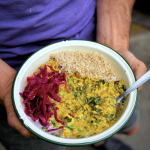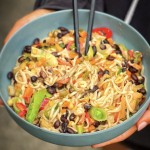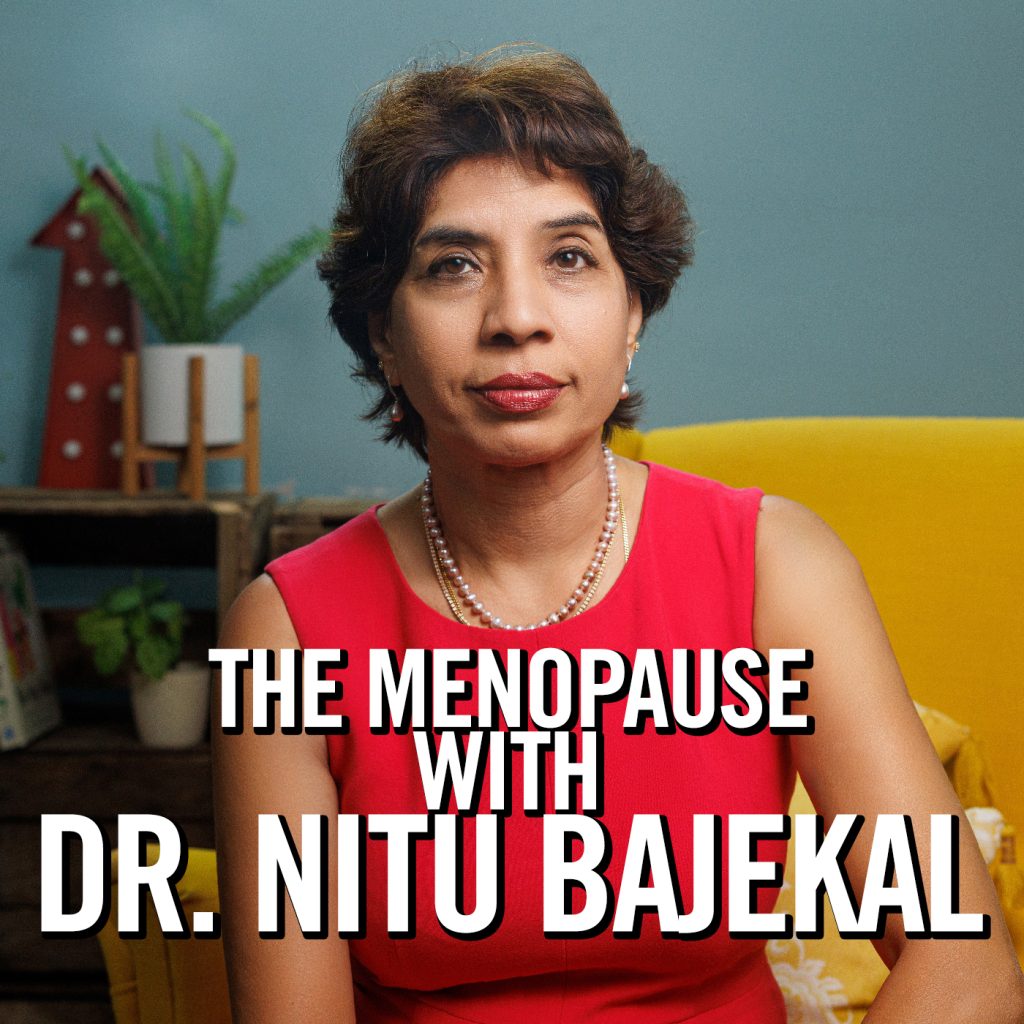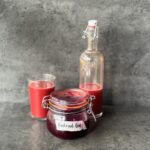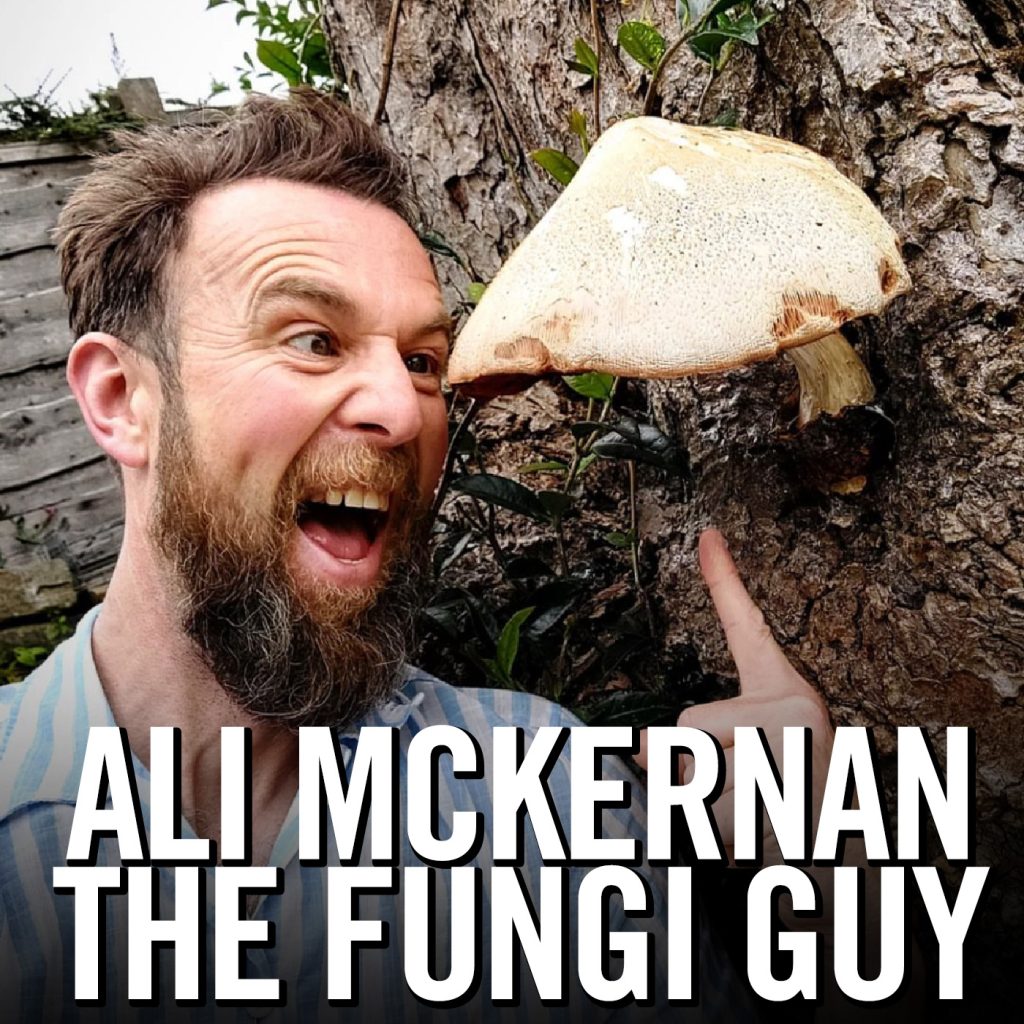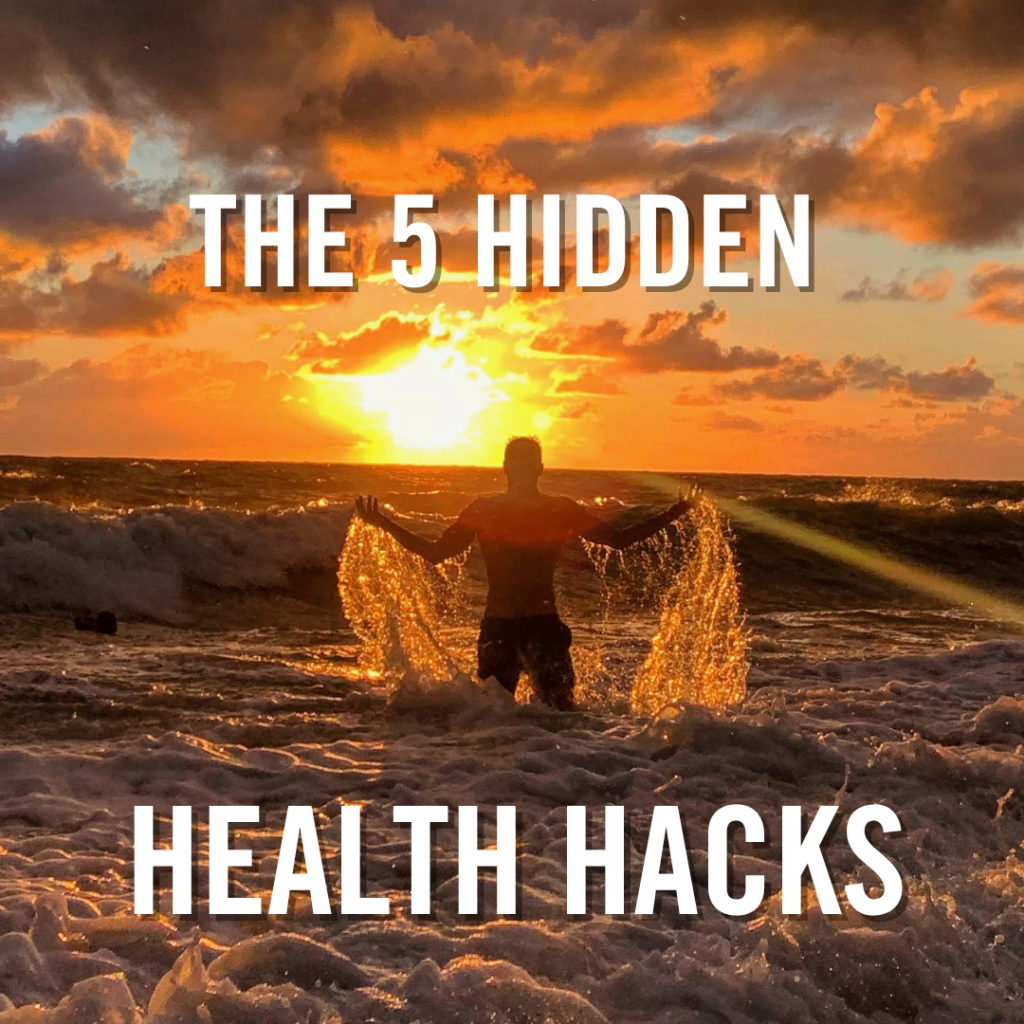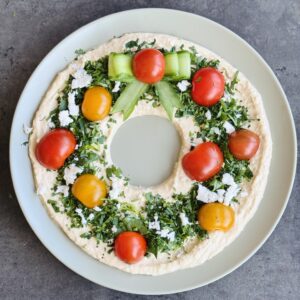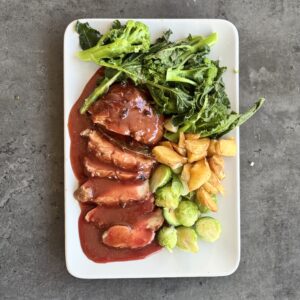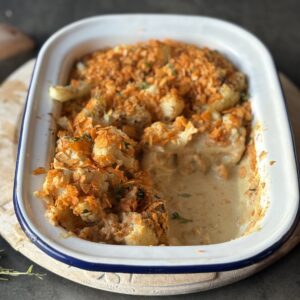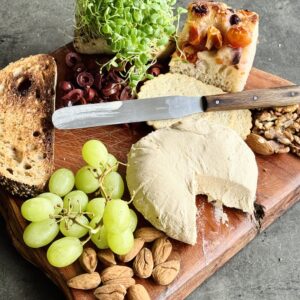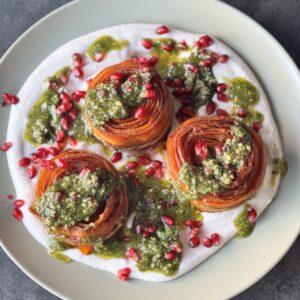
Vibrant and delicious shoots that are wonderful added to any salad, for garnishing any meal or fab in any sandwich. These shoots are high in protein and a super nutrient dense food.
INGREDIENTS
Peas (100%).
ALLERGEN INFORMATION
For allergens, see highlighted ingredients.
NUTRITIONAL INFORMATION
| Typical | per 100g |
|---|---|
| Energy | 123kJ |
| 29kcal | |
| Fat | 0.3g |
| of which Saturates | 0.1g |
| Carbohydrate | 3.5g |
| of which Sugars | 0.7g |
| Fibre | 2.1g |
| Protein | 4.2g |
| Salt | 0.01g |

Charred Aubergine Tagliatelle
Takes 26 minutes
Serves 3
Ingredients
- 400 g tagliatelle
- 150 g oyster mushrooms
- 2 aubergines
- 1 carrot
- 1 onion
- 3 cloves garlic
- 100 g tomato purée
- 700 g tomato passata
- 1 tbsp maple syrup
- 1.5 tbsp tamari
- Salt and pepper (to taste)
- Basil (to serve)
Instructions
- Char the aubergines: Using tongs, cook the aubergines over a gas flame for 5-10 minutes until they are charred and cooked through to the centre. A fork should easily pierce the aubergines when they are ready. The centre should be soft and break down effortlessly.Alternatively if you don’t have a gas flame, cut the aubergines in half and place them face down on a baking tray. Sprinkle with a generous pinch of salt and bake at 200°C for about 30 minutes until they are soft enough to be easily scooped out or torn apart.
- Prepare the vegetables: Peel and dice the onion and garlic. Finely dice the carrot into 1/2 cm cubes. Using a fork, shred the oyster mushrooms to give them a distinct, pulled texture. Be careful not to scrape your fingers when doing this.
- Cook the vegetables: Heat a non-stick pan over high heat and add 1 tablespoon of oil. Once hot, add the onion, carrot, and a pinch of salt. Cook for 3-4 minutes, then add the mushrooms and garlic. Cook for another 4-5 minutes until the onions and mushrooms start to brown at the edges.
- Flavour the sauce: Add the tamari and mix it through, allowing the mushrooms to absorb the flavour. Next, add the tomato passata, tomato purée, and maple syrup. Stir well and taste the sauce. Adjust the seasoning with salt and pepper to your liking.
- Chop the aubergine: Once the aubergines are done, chop them into small pieces and stir them into the sauce.
- Cook the pasta: Follow the instructions on the packet to cook the tagliatelle. Once done, drain and rinse the pasta, then add it to the sauce.
- Finish and serve: Finely chop the basil and sprinkle it over the top. Mix everything together, double-check the seasoning, and enjoy!
Nutrition
Here we have pulled together some of our favourite ways to use red cabbage. We know it can sometimes be challenging to know what to do with it! It packs a punch of vitamins C and K, along with a synergy of antioxidants that promote overall well-being. Its deep, purple-hued leaves bring not only a pop of colour to your plate but also a spectrum of nutritional benefits, including anti-inflammatory properties and digestive support.
Red cabbage is a chameleon in the kitchen, capable of starring in a variety of dishes. From the tangy crunch of a fresh slaw to the comforting warmth of a braised side, its culinary potential is boundless. Whether you’re pickling, fermenting, sautéing, or tossing it raw into salads, red cabbage adds a flavourful twist to any meal. Let’s embark on a journey of taste and health as we explore the delicious possibilities of red cabbage in your kitchen.
Red Cabbage Sauerkraut
Why not turn it into homemade probiotics? It takes 15 mins of prep and a week or so to ferment till you have this superfood probiotic red cabbage powerhouse!!
Total Time Needed: 20 Mins + fermenting time
Difficulty: Easy
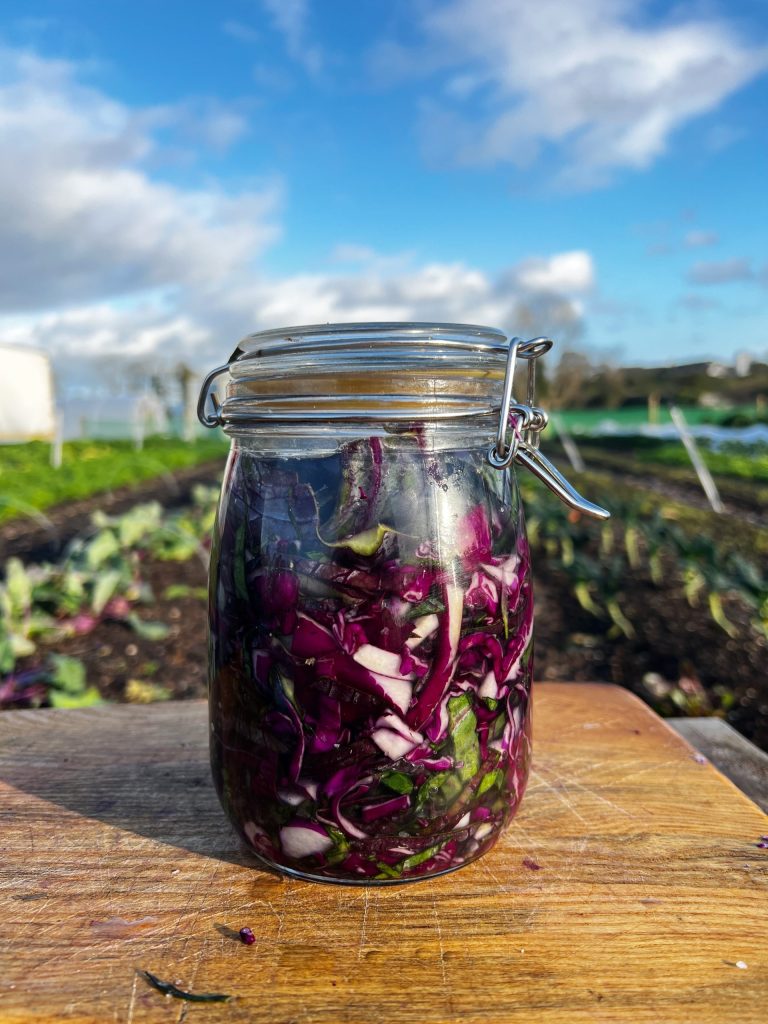
Asian Style Salad
This salad is a great way of using carrots, red cabbage, spinach and even beetroot. Its packed with nutrition and flavour
Total Time Needed: 25 Mins
Difficulty: Easy
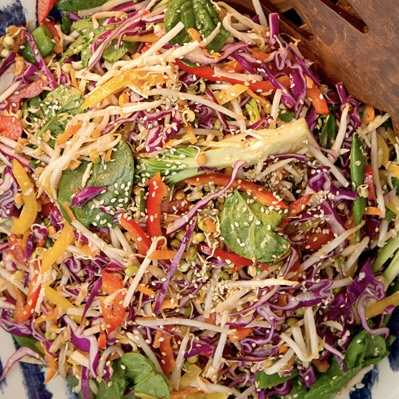
Red Cabbage, Apple & Walnut Salad
Indulge in the crisp, refreshing flavours of our Red Cabbage & Apple Salad, a dish that celebrates the harmonious blend of sweet and tangy. This salad is not only a feast for the eyes but also a powerhouse of health. Perfect for a light lunch or as a side to your main course. Add spinach too if you so desire!
Total Time Needed: 20 Mins
Difficulty: Easy


Asian Style Rainbow Crunch Salad
Takes 20 minutes
Serves 6
Ingredients
- 1 medium carrot
- 250 g red cabbage
- 1 regular red pepper
- 100 g sprouted beans like mung beans or aduki beans, can be replaced with bean sprouts
- 50 g sugar snap peas 1 handful
- 30 g sunflower seeds
- 30 g sesame seeds
- 100 g baby spinach
For Dressing
- 1 Thumb sized piece Fresh Ginger approx 8g
- 1 clove Garlic
- 1½ tbsp of Tamari or Soy Sauce
- 1 Lemon (juice of)
- ¼ medium Red Chilli
- 2 tablespoons Maple Syrup
- 60 ml sesame oil or other oil
Instructions
- Prep the veg: Grate the carrot and red cabbage or if your knife skills are good finely slice the cabbage into long thin stips and julienne the carrot into small matchstick size cuts.. Finely slice the red pepper (removing the seeds and stalk) and slice the sugar snap peas lengthwise so you open them up into thin long strips.
- Toast seeds: Toast the sesame and sunflower seeds in a dry pan over high heat for about 5 minutes, until they turn slightly brown and start to pop
- Put salad veg in a bowl: Combine the cabbage, carrot, peppers, sugar snap peas, sprouted beans, and baby spinach in a large salad bowl.
- Blend the dressing: For the dressing, blend together all ingredients for the dressing in a blender or food processor until nice and smooth and the garlic and ginger and fully blended.
- Dress, mix & serve: Add the dressing to the salad and mix until well coated. Sprinkle toasted seeds on top and enjoy!
Nutrition
The Happy Pear Podcast
This week’s episode is with Mary-Frances O’Connor, a psychologist and author of “The Grieving Brain: The Surprising Science of How We Learn from Love and Loss.”
Episode 112
Mary-Frances conducts studies to better understand the grief process both psychologically and physiologically. She is a leader in the field of prolonged grief, a clinical condition in which people do not adjust to the acute feelings of grief and show increases in yearning, avoidance, and rumination.
Her work primarily focuses on trying to tease out the mechanisms that cause this ongoing and severe reaction to loss. In particular, she is curious about the neurobiological, immune, and cardiovascular factors that vary between individual responses to grief.
In this episode we explore the different facets of grief, how it affects our brain, how to deal with it and how we can support others.
A heavy topic, and we are complete novices here but we learnt a lot and hope that you did to.
Lots of love,
Dave & Steve
Available now from all good podcast providers:
This episode is sponsored by Vivobarefoot Footwear. Vivobarefoot Footwear have given our listeners an exclusive 15% discount when you enter the code HAPPYPEAR15
Genuinely these are the only shoes you will see Dave & Steve wearing!
Produced by Sean Cahill and Sara Fawsitt

Meaty Mushroom Shawarma
Takes 20 minutes
Serves 2
Ingredients
- 2 flatbreads
- 200 g oyster mushrooms
Seasoning
- 1 tbsp sumac
- 1/2 tsp turmeric
- 1 tbsp smoked paprika
- 1/2 tsp chilli powder
- 1/2 tsp black pepper
- 3 tbsp tamari
- 1.5 tbsp maple syrup
- 2 tbsp oil
Salad
- 10 cherry tomatoes
- 1/3 cucumber
- 15 g fresh coriander
Tahini Sauce
- 50 g tahini
- 100 g natural yoghurt
- 1 clove garlic
- Juice of 1 lemon
- Pinch of salt
Additional
- Pickled red onion
Instructions
- Prepare the mushrooms: Tear the oyster mushrooms into pieces that can be spread wide when pressed.Place them in a bowl, add the seasoning (sumac, turmeric, smoked paprika, chilli powder, black pepper, tamari, maple syrup, and oil), and mix well.
- Cook the mushrooms: Heat a wide non-stick frying pan on high heat and add 1 tbsp of oil. Once hot, spread the mushrooms in a single layer, ensuring there’s enough space for them to char. Using another clean pan, press the mushrooms for about 20 seconds to maximise charring and remove excess moisture for a meatier texture. Cook for 1-2 minutes, turn, and press again until the mushrooms are charred and cooked through. Remove from the pan and roughly chop.
- Make the salad: Finely dice the cucumber, coriander, and cherry tomatoes. Mix them in a bowl with a pinch of salt. Set aside.
- Prepare the tahini sauce: Peel and finely dice the garlic. In a bowl, combine the tahini, yoghurt, lemon juice, garlic, and a pinch of salt.Mix until the sauce emulsifies into a thick cream. Taste and adjust seasoning as necessary.
- Assemble the shawarma: Spread a generous layer of the tahini sauce over each flatbread. Add the coriander, tomato, and cucumber salad, followed by the charred mushrooms. Top with pickled red onions and enjoy!
Nutrition
Menopause Nutrition Advice from a Gynaecologist
General Advice:
- Adopt a predominantly whole food plant based (WFPB) way of eating. Eating a range of whole plant foods helps with much more than just the symptoms of menopause. The same diet that helps with menopausal symptoms, also helps with better aging, reduced dementia and Alzheimer’s risk, reduced heart disease and diabetes and reduced breast, prostate, bowel, womb and ovarian cancer risks, the biggest killers in the modern day.
- Eating a whole food plant based diet means you will eat calorie light, nutrient dense, gut microbiome promoting fibre rich colourful foods.
- Focus on eating a plant strong diet full of colourful micronutrient and antioxidant rich vegetables, fruits, legumes, nuts and seeds and intact minimally processed whole grains. To this way of eating, one should add plenty of herbs and spices as these increase the antioxidant power of any dish by as much as 200%. Make water the drink of choice.
- As this way of eating is rich in fibre, it helps promote healthy gut bacteria (healthy gut microbiome) and reduces the incidence of common but serious life threatening diseases such as heart disease and cancer as well as dementia through complex mechanisms. Learn how to improve gut health.
- Avoid a diet high in trans fats found in junk and ultra processed foods (biscuits/cakes/chocolates/ready meals) as they promote inflammation.
- Avoid saturated fats found almost exclusively in animal products (eggs, dairy, fish, chicken and red meat which along with the growth hormone, insulin growth factor, hormones, chemicals, pesticides and antibiotics promote oxidative stress and inflammation in the body, the latter being the base from where most lifestyle diseases arise.
- The less processed a food is, the better it is for you. That is why it is best to avoid highly refined foods and stick to fibre rich whole plant foods.
- Avoid oils and fruit juices as they tend to be devoid of fibre and as a result do not have the same amount or variety of micronutrients that are so good for our health.
To help reduce hot flushes and night sweats:
- Breakfast: 250 ml of soya milk with steel cut porridge oats. Add 1-2 tbsp of flaxseed powder and 1 tsp of chia seeds to the oats and soak in hot water. Cook with a cup of soya milk (organic, unsweetened or homemade if possible). Add nuts and fresh and dried fruit. This gives you a good start with the fibre rich, plant oestrogen rich, omega-3 rich plant-based breakfast or brunch.
- Mid-morning snack: handful of edamame beans or soya nuts or berries or hummus with crudités.
- Lunch: Large rainbow coloured salad with beans or chickpeas or hummus or vegetable bean soups, minestrone soups or dals.
- Dinner: Hearty Lentil Stew , pan fried tofu with steamed greens and tofu,
- Avoid alcohol and smoking as both these can make hot flushes much worse.
- Caffeine containing drinks can worsen hot flushes.
- Avoid a diet high in trans fats and processed foods (biscuits/cakes/chocolates/ready meals/fried foods/sugary foods) as they promote inflammation through a variety of mechanisms.
- Avoid saturated fats found almost exclusively in animal products (eggs, dairy, fish, chicken and red meat which along with the growth hormone, insulin growth factor, hormones, chemicals, pesticides and antibiotics promote oxidative stress and inflammation in the body, the latter being the base from where most lifestyle diseases arise.
By Dr. Nitu Bejekal, Snr Consultant Gynaecologist
Understanding the Menopause: Navigating the Physical and Emotional Changes with Our Expert Course
The menopause starts when a woman has no period for a full 12 months. The typical age a women starts the menopause is age 51. The period before menopause when some menopause symptoms might begin or when their might be some inconsistency in the regularity of your period is called the perimenopause. The menopause can be a challenging time in a women’s life but it does not need to be the case. As hormone levels drop, primarily oestrogen, women may experience symptoms such as hot flushes, night sweats, weight gain, difficulty sleeping and mood swings. These symptoms, along with the increased risk of certain health conditions such as heart disease and dementia, can make the menopause a difficult time. However, with the right support and facts, women can navigate this period with ease and emerge stronger and healthier.
Overview of the Menopause
Menopause is a natural biological process that marks the end of a woman’s reproductive years. It typically occurs between the ages of 45 and 55 with the average being somewhere around 51, although it can occur earlier or later. During this time, the ovaries stop producing eggs and the production of oestrogen and other hormones decreases.
What There is to Learn about the Menopause
The menopause is a complex process that involves many factors, including hormonal changes, genetics, lifestyle, and environmental factors. Women who understand the menopause and how it affects their bodies can better manage its symptoms and improve their overall health and well-being and even thrive during this period of their live. This can include learning about lifestyle changes such as exercise and diet, as well as effective treatments for specific symptoms such as hot flushes, sleep disturbances, and mood swings.
There are also important health considerations related to the menopause, such as the increased risk of certain conditions such as heart disease, osteoporosis, and type 2 diabetes. Understanding these risks and taking steps to mitigate them, such as getting regular check-ups and adopting healthy lifestyle practices can help women maintain good health as they age.
Why Our Course Can Help
The Happy Menopause course is a 4 week course fronted up by Dr. Nitu Bajekal, Senior Consultant Gynaecologist and other medical professionals. It is designed to help women understand the menopause and empower them to make lifestyle changes to help them to thrive during this period of transition. It includes the learnings from real experts to help you to better deal with the often negative symptoms.
The course will give you the facts about menopause and debunk many of the myths. It gives you meal plans to start to cook and eat as well as hundreds of delcious recipes. There are daily live classes for you to join as well as so much more. Whether you are experiencing symptoms of the menopause or are simply looking for information and support, our course has something to offer.
We understand that the menopause can be a confusing and overwhelming time, but with the right support and education, women can come through it feeling stronger and more confident. The Happy Menopause Course is here to help you to thrive during this period and to make the most of it. We look forward to helping you on your journey.
7 Natural Menopause Treatments That Work
As women go through menopause, they often experience various physical and emotional changes due to the decline in hormones in their body, primarily oestrogen. Some common symptoms include hot flushes, night sweats, weight gain, mood swings, poor quality sleep and brain fog or loss of confidence. While HRT (hormonal replacement therapy) is a popular treatment for some women, many women would prefer to use natural approaches to mitigate these negative symptoms for a more gentle and holistic approach.
Here are 7 natural menopause treatments that have been shown to work for many women:
- Phytoestrogens: These are plant-based compounds found in foods like soybeans, lentils, chickpeas, flaxseeds, and almonds. Eating these foods can help relieve menopause symptoms by mimicking the effects of estrogen in the body. A great way to do this is to add a tin/can of cooked beans or chickpeas to your dinner or to eat hummus, which is made of chickpeas. Beans are also high in fibre and low in calories so will aid in weight loss.
- Herbs: Certain herbs have been used for centuries to treat menopause symptoms. Black cohosh is well-known for relieving hot flushes, while red clover can help regulate mood swings. Other helpful herbs include dong quai, ginseng, and evening primrose oil. The above are rare medicinal herbs, however all herbs are high micro nutrients and contain compounds that will help regulate your bodies systems. Choose herbs such as coriander, mint, basil, parsley or whatever fresh herbs you like. All will have beneficial properties.
- Acupuncture: This is a traditional Chinese medicine practice that involves inserting fine needles into specific points on your body. Acupuncture has been found to be effective in reducing hot flushes and helping with de-stressing as well as helping to improve sleep quality for menopausal women.
- Mind-body practices: Practices such as meditation, yoga, mindfulness and tai chi can help relieve stress and anxiety, which are common symptoms of menopause. They help reduce stress and bring you back to the present moment.
- Eating anti-inflammatory foods. Some of the side effects of menopause are rooted in inflammation. Much of the modern western diet of animal based foods and processed foods cause an inflammatory response to our bodies. By eating more whole plant foods that are naturally anti-inflammatory, these foods will help to ease symptoms by reducing inflammation.
- Hormonal balancing whole plant foods: Whole plant foods support hormone production and help balance many systems in your body. Whole plant foods include fresh fruits, vegetables, beans & legumes, wholegrains and nuts and seeds.
- Exercise: Regular exercise can reduce the severity of hot flushes, improve mood, reduce stress, boost energy levels and improve sleep quality. Sometimes motivation for exercise can wain during menopause so it is a matter of picking something that you think you will enjoy and getting started. Ideally you have a friend join you or someone to help hold you accountable and to support you who is on the same journey. Scheduling it into you week is also really important to make sure that it happens.
Remember, every woman’s experience of menopause is unique. However there are over arching lifestyle changes that will give you a really solid foundation in terms of your health and the menopausal phase of your life. We created The Happy Menopause Course, it is fronted up by Senior Consultant Gynaecologist Dr. Nitu Bejekal and other medical professionals. It gets great results and debunks a lot of myths and false facts about menopause.
Sample Lesson: Cognitive Health
Oestrogen levels can affect word recall, memory and so called ‘brain fog’ symptoms, and having levels that are both too low or indeed too high in some people can mean the sweet spot is hard to find. For some, HRT helps. Regular physical activity and spending time in nature helps, as well as prioritising sleep, trying out breathwork and meditation and avoiding alcohol. Learning new skills and managing stress are also useful.
Sample Lesson: Menopause 101 – also includes Perimenopause
Women are usually born with two ovaries (egg containing baskets or organs) although one can go through life with no repercussions if there is only one functioning ovary. Each ovary contains a huge number of eggs, in fact thousands which reduce in number over time through a process of natural loss every month. There is no way to increase or reduce this natural loss of eggs. Only a few hundred eggs are used in a woman’s lifetime. After the onset of puberty, the ovary releases an egg most months, a process known as ovulation.
Sample Lesson: What about Calcium?
Calcium is an important mineral for human survival. It is needed, as you probably already know, to keep our bones and teeth strong and healthy. Small amounts of calcium are also required for nerve function, to relax our muscles and for blood clotting.
Before the domestication of dairy cows was commonplace, many human populations evolved without dairy in their diet, consuming all the calcium they required from plants. Due to the artificial selection of sweetness, rather than nutritional content, many of the plant foods we consume today have lower levels of calcium than that of their ancestors.
Sample Lesson: Benefits of Soya in Menopause
A randomised controlled trial showed fantastic results showed Just 1/2 cup or 86 g of mature soya beans providing 55 to 60 g of isoflavones was associated with reduced frequency and severity of hot flushes by 84% and improved quality of life in vasomotor, psychosocial, physical, and sexual symptoms in postmenopausal women when followed for just 12 weeks. The women involved in this study were following a completely plant based diet during this time.
The Happy Pear Podcast
Today we have a special guest joining us, the one and only George Monbiot. George is an award-winning journalist, author, and environmental activist, and we’re so excited to have him here to chat with us.
Episode 112
In this episode, we dive deep into some really interesting topics with George, such as the importance of rewilding and how it can help combat climate change. He shares some amazing insights on how rewilding can not only benefit the environment, but also our mental health and well-being. It’s fascinating stuff!
We also discuss some of the challenges we face in creating a more sustainable future, and how we can work together to overcome them. George has such a positive and hopeful outlook, and it’s really inspiring to hear his thoughts on this.
Throughout the conversation, we all share stories and anecdotes from our own lives, and it really feels like a friendly chat between old friends. Dave is so impressed with George’s ideas that he even asks him out to lunch the following week!
So if you’re interested in hearing some great insights on environmental activism and sustainability, this is definitely the episode for you. George is such an amazing guest, and this conversation is packed full of insightful nuggets.
Lots of love,
Dave & Steve
Available now from all good podcast providers:
To find out more about George, check out his latest book: “Regenisis: Feeding the World without devouring the Planet”.
This episode is sponsored by Vivobarefoot Footwear. Vivobarefoot Footwear have given our listeners an exclusive 15% discount when you enter the code HAPPYPEAR15
Genuinely these are the only shoes you will see Dave & Steve wearing!
Produced by Sean Cahill and Sara Fawsitt
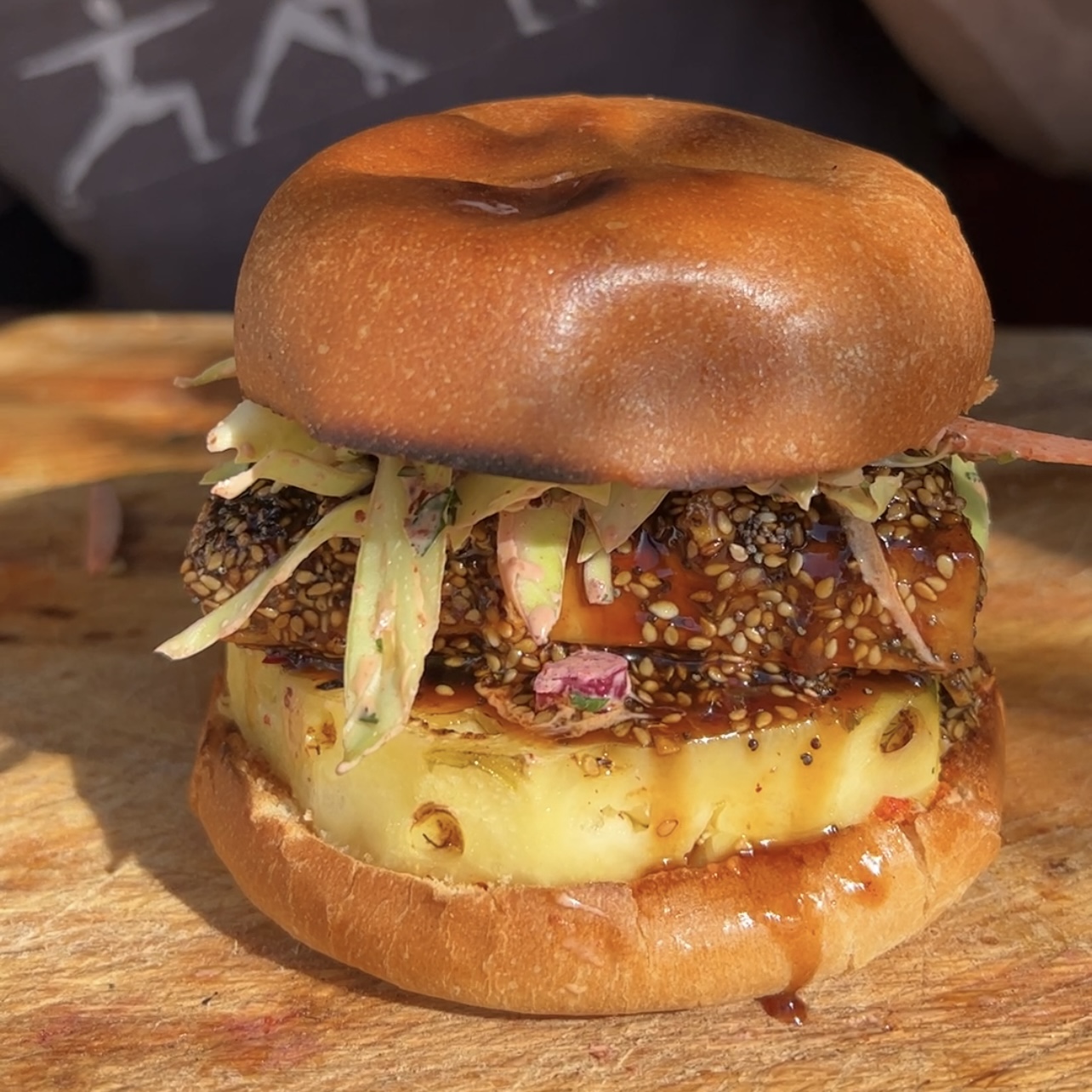
Sticky Sesame Tofu Burger with Charred Pineapple and Kimchi Mayo
Takes 27 minutes
Serves 2
Ingredients
For the Slaw:
- 1/4 white cabbage (finely sliced)
- 1/2 carrot (grated)
- Handful of fresh coriander (diced)
- 1/4 red cabbage (finely sliced)
- 50 ml vegan mayonnaise
- 1 tsp chilli powder (Korean chilli powder like gochugaru works best)
- 1 tbsp kimchi juice (or sauerkraut juice)
For the Tofu:
- 200 g firm tofu (sliced into 1 cm thick slices)
- 4 tbsp white flour (or cornflour)
- 4 tbsp sesame seeds
For the Teriyaki Sauce:
- 5 tbsp tamari
- 3 tbsp maple syrup
- 1 tbsp vinegar (of choice)
- 1 clove garlic (finely chopped)
- 1/2 thumb-sized piece ginger (peeled and finely chopped)
- 1/4 red chilli (finely chopped)
Extras:
- 2 burger buns
- 1/3 fresh pineapple charred (sliced into 2 x 1 cm slices, core removed)
- Spicy red pesto or ketchup
Instructions
- Make the Slaw:Finely slice the cabbages, grate the carrot, and dice the fresh coriander. In a separate bowl, mix together the vegan mayonnaise, chilli powder, and kimchi juice until well combined. Add the mayo mixture to the cabbage, carrot, and coriander. Mix well to form your kimchi slaw.
- Char the Pineapple:Carefully remove the skin from the pineapple, slice into two 1 cm thick slices, and remove the core. Heat a non-stick pan and char the pineapple on both sides for 30-40 seconds until evenly browned. Set aside.
- Prepare the Tofu:Slice the tofu into 1 cm thick pieces, slightly larger than the burger buns. Heat a non-stick pan on high and add 1 tbsp of oil. While the pan is heating, finely chop the garlic, ginger, and red chilli. Mix all the teriyaki sauce ingredients in a small bowl.Fry the tofu slices for 1-2 minutes on each side until golden. Add 2 tbsp of the teriyaki sauce to the pan and coat the tofu slices thoroughly. Remove from the pan and set aside. Clean the pan.
- Coat the Tofu:In a shallow dish, coat the cooked tofu in white flour or cornflour, ensuring an even layer. Dip each piece of tofu into the remaining teriyaki sauce, then roll in sesame seeds to fully coat.
- Fry the Coated Tofu:Reheat the pan on high heat with 1 tbsp of oil. Fry the coated tofu for 1 minute on each side until the sesame seeds start to turn golden and pop. Add the remaining teriyaki sauce to the pan, and let it reduce for about 1 minute. Add the tofu back in, spooning the sauce over to stick to the sesame crust.
- Assemble the Burger:Toast the burger buns. Spread a generous dollop of pesto or vegan mayo on the bottom bun. Add the charred pineapple, followed by the sticky sesame tofu. Drizzle any remaining teriyaki sauce over the tofu. Top with the kimchi slaw and close with the top bun. Enjoy!
This Low Fat Tofu and Spinach Dal is so tasty and genuinely only takes 10 mins. It is also low fat so ideal for anyone wanting to lose weight. The first time we made this recipe we shot a video after brekkie and ended up devouring the full lot! This recipe is ideal for anyone going through menopause as its low in fat, high in phytoestrogen coming from the beans and lentils.
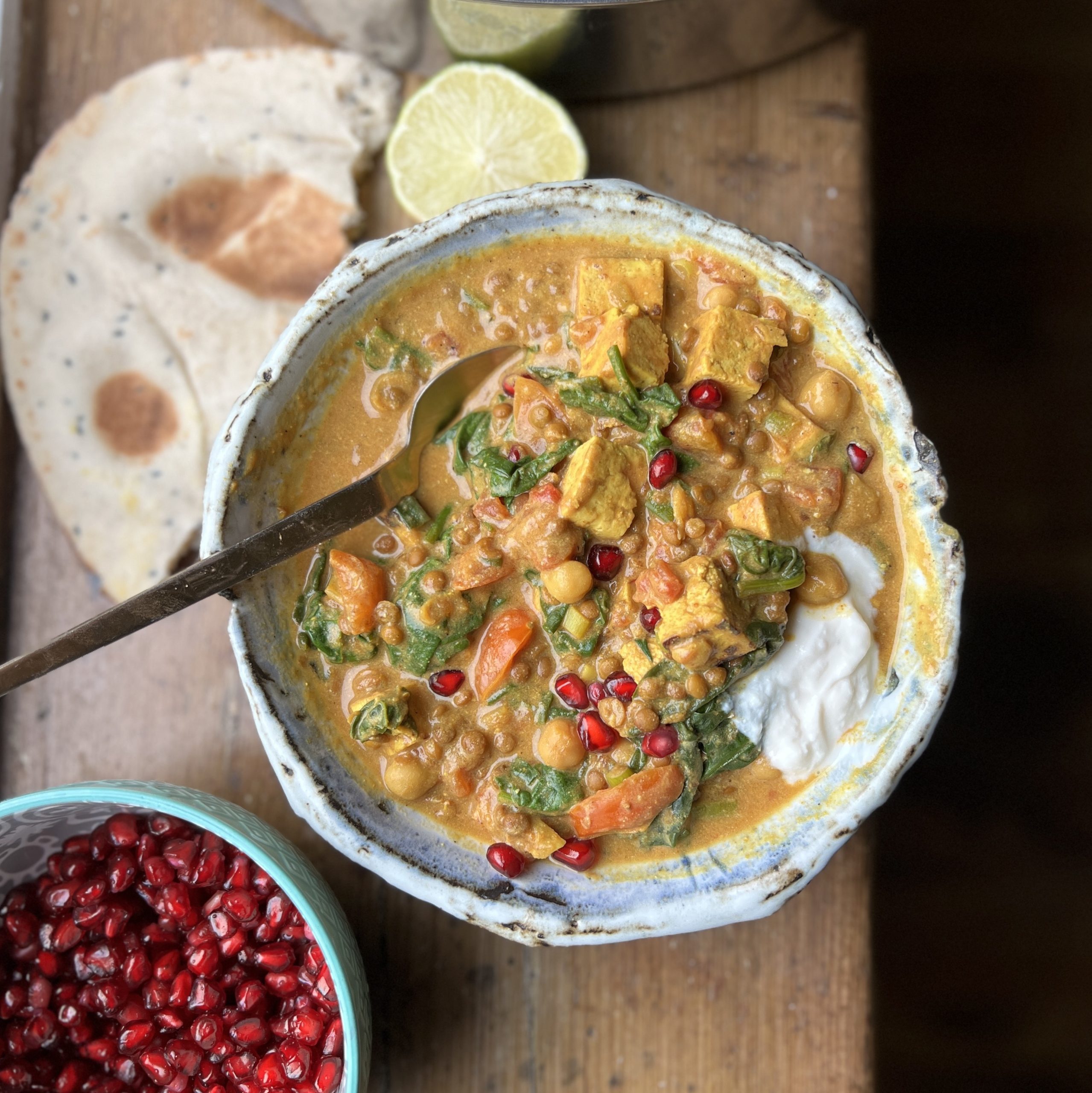
Tofu and Spinach Dal
Takes 16 minutes
Serves 4
Ingredients
- 200 g tofu
- 3 tbps tamari
- 1.5 tbsp maple syrup
- 1 clove garlic
- thumbsized piece of ginger
- 1 bunch scallions
- 400 g cooked chickpeas
- 400 g cooked lentils
- 100 g spinach
- 400 g chopped tomatoes
- 200 ml water
- 250 g natural soy yoghurt
- 1/2 juice lime
- 10-15 cherry tomatoes
- 2 tbsp curry powder
- 1 tsp ground tumeric
- 2 tsp ground cumin
- 1 tsp salt
- 1 tbsp tamari
- 1/2 tsp black pepper
Instructions
- Peel and finely chop the garlic and ginger. Finely chop the scallions/ green onions removing any limp outer leaves. Drain the tinned chickpeas and lentils and rinse thoroughly, keeping them separate. Chop the cherry tomatoes in half. Remove the tofu from the pack, drain any water, cut the tofu into 1.5cm squared cubes. In a mug mix the 3 tbsp of tamari with the 1.5 tbsp of maple syrup until well combined.
- Heat a non-stick pan on high heat, once hot add the tofu and cook for 3-4 mins stirring regularly until it starts to sear or golden on each side, add in the tamari and the maple syrup mixture and quickly mix so that each piece of tofu is really well coated with the sauce. Add in the drained beans and lentils to the pan with the tofu along with the chopped tomatoes, water and the sliced scallions or green onions. Add in the spices, the curry powder, turmeric, ground cumin, salt, tamari and ground black pepper and mix well.
- Finally add in the soy yogurt along with the spinach and mix well and cook for 2-3 mins until the spinach starts to wilt.
- Squeeze in juice of ½ lime and mix through, taste and adjust the seasoning to your liking by more salt, pepper, lime or maple syrup
- Leave to simmer for a further 2 mins, then take off the heat.
- Garnish with some pomegranate seeds and fresh coriander (or other fresh herb of your choice), and serve with a cooked grain of choice or toasted pittas chopped into soldiers and some rice. Enjoy!
Nutrition

The Happy Pear Podcast
Dr Nitu Bajekal is back with a special episode for National Women’s Health Day! An expert in women’s health and menopause. This is the second time she’s joined us on the podcast, and we’re thrilled to be launching our online menopause course with her.
Episode 111
Get ready for an informative and lively conversation full of takeaways that both men and women of all ages should listen to.
Key takeaways:
- Menopause is a natural part of aging for women, and it’s essential to recognise and manage its symptoms, including hot flashes, mood swings, and vaginal dryness.
- Hormonal changes during menopause can also lead to an increased risk of heart disease, osteoporosis, and other health conditions, making it vital to take care of overall health and wellbeing.
- Lifestyle factors such as diet, exercise, and stress management can play a significant role in managing menopause symptoms and reducing health risks.
- Dr. Nitu emphasises the importance of self-care and self-compassion during menopause, as it can be a challenging time both physically and emotionally.
- The hosts and Dr. Nitu discuss common misconceptions and stigmas surrounding menopause and encourage open and honest conversations about women’s health.
The most important takeaway of all is let’s start talking more openly and honestly about women’s health!
Lots of love,
Dave & Steve
Available now from all good podcast providers:
Checkout our Happy Menopause course for more information.
This episode is sponsored by Vivobarefoot Footwear. Vivobarefoot Footwear have given our listeners an exclusive 15% discount when you enter the code HAPPYPEAR15
Genuinely these are the only shoes you will see Dave & Steve wearing!
Produced by Sean Cahill and Sara Fawsitt
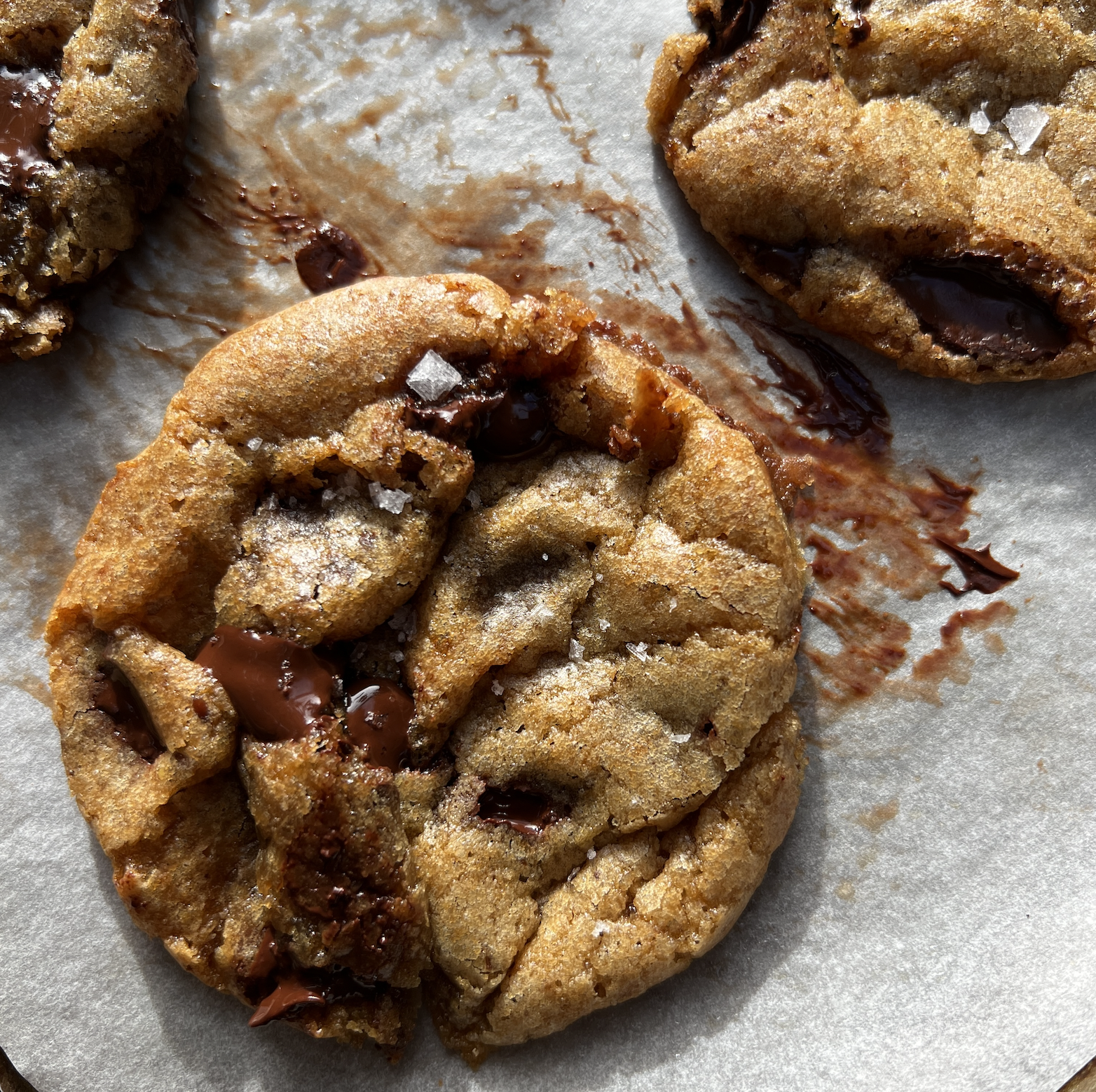
Super Chewy Chocolate Chip Cookies
Takes
Serves
Ingredients
- 125 g self-raising flour
- 80 g vegan block butter
- 115 g caster sugar
- 35 g brown sugar
- 3 tbsp oat milk
- 1 tbsp ground flax seeds
- 3 tbsp water
- 100 g chocolate chips
Instructions
- Preheat the oven: Set the oven to 170°C (fan). Line a baking tray with parchment paper.
- Prepare the flax egg: Mix the ground flax seeds with 3 tbsp of water and set aside for about 5 minutes to thicken.
- Melt the vegan butter: Melt the vegan block butter over low heat. Once melted, remove from the heat and set aside to cool slightly.
- Mix dry ingredients: In a large bowl, sift the self-raising flour, caster sugar, and brown sugar together.
- Combine wet ingredients: In a separate bowl, mix the melted butter, oat milk, and the thickened flax egg.
- Form the cookie dough: Gradually add the wet ingredients to the dry ingredients, mixing until just combined. Avoid overmixing to prevent developing too much gluten. Stir in 80 g of the chocolate chips, reserving 20 g for decoration.
- Chill the dough: Cover the cookie dough and refrigerate for 30 minutes or freeze for 10 minutes to firm it up slightly.
- Shape the cookies: Remove the dough from the fridge or freezer. Scoop heaped tablespoons (about 45 g per cookie) and roll them into balls. Arrange them on the prepared baking tray, leaving space between each cookie to allow for spreading (around 5 cookies per tray). Gently press each cookie down with the palm of your hand.
- Decorate and bake: Press the remaining 20 g of chocolate chips into the tops of the cookies. Bake in the preheated oven for 6 minutes.
- Create the perfect texture: After 6 minutes, remove the tray from the oven and drop it carefully onto the counter to create a 'bang' that will flatten the cookies slightly. Return to the oven and bake for a further 6-8 minutes, or until golden.
- Finish and serve: Remove from the oven and sprinkle a pinch of sea salt on top of each cookie.Allow the cookies to cool before enjoying (if you can resist!).
Can Coffee Cause Bloating? The Truth About Coffee, Bloating and Your Gut Health
Do you love starting your day with a cup of coffee, but hate the bloating that comes with it? You’re not alone. Many people experience bloating after drinking coffee, and it can be uncomfortable and frustrating. In this article, we’ll explore whether coffee really can cause bloating, and what you can do about it.

Overview of Bloating and Gut Health
Bloating is a common symptom of an unhealthy gut. It occurs when your digestive system has difficulty breaking down food, leading to excess gas and discomfort. The health of your gut plays a crucial role in your overall well being, affecting everything from your immune system to your mental health. That’s why it’s important to take care of your gut and address any issues, like bloating, as soon as possible. Bloating is really a sign or indicator of an unhappy gut.

Can Coffee Cause Bloating?
Now, let’s talk about coffee. You may have noticed that sometimes after drinking your favourite cup of joe, you feel bloated and gassy. So, can coffee really cause bloating? The short answer is yes, it can.
Coffee is a natural laxative that stimulates the muscles in your digestive system, which can lead to an increase in bowel movements. This can cause the production of gas, leading to bloating and discomfort. Additionally, coffee contains caffeine, which can also cause bloating by increasing the production of stomach acid and slowing down digestion.
But, it’s important to note that not everyone experiences bloating after drinking coffee. It can vary depending on your body’s sensitivity to caffeine and other compounds found in coffee. If you do experience bloating after drinking coffee, you may want to consider cutting back or switching to a lower-caffeine option.
So, does cutting out coffee help with bloating? It can, but it’s not necessarily the only solution. It’s important to consider other factors that can contribute to bloating, such as diet, stress, and gut health.
In fact, this is where our Gut Health Revolution course can come in handy. By learning about the connection between gut health and bloating, you can make informed decisions about your diet and lifestyle to alleviate bloating and improve your overall well-being.
And if you do decide to continue drinking coffee, there are ways to minimise the bloating effects. Opting for a low-acid coffee or adding a splash of oat milk can help reduce the amount of acid and stimulate digestion.
So, yes, coffee can cause bloating, but it’s not necessarily a reason to give up your morning cup of joe. By being mindful of your body’s response to coffee and making informed choices, you can enjoy your coffee without the discomfort of bloating.

Does Coffee Make You Gassy and Bloated?
There’s no denying that coffee is a staple for many people. Whether it’s part of your morning routine or an afternoon pick-me-up, a steaming cup of coffee can be a real comfort. However, for some people, coffee may cause an unpleasant side effect: bloating and gas. So, does coffee make you gassy and bloated?
The answer is not a simple one. While coffee itself doesn’t contain gas-causing compounds, it does stimulate the production of stomach acid. This increase in acid production can lead to digestive discomfort, including bloating and gas. Additionally, coffee can be a diuretic, which means it can cause dehydration and constipation, both of which can contribute to bloating.
It’s also important to consider what you’re putting in your coffee. Adding milk or cream to your coffee can make it more difficult to digest, particularly if you’re lactose intolerant. Artificial sweeteners or high amounts of sugar can also cause digestive issues, including bloating. The same goes for adding additional syrups.
If you’re experiencing bloating and gas after drinking coffee, it’s worth examining your overall diet and lifestyle. Are you eating a diet that includes lots of fruit, veg, wholefoods and legumes that naturally contain plenty of fibre? Are you drinking enough water throughout the day? Are you getting enough exercise? How is your sleep? These factors can all impact your digestive health and contribute to bloating.
If you’re still experiencing discomfort, it may be worth cutting back on your coffee intake or trying alternative sources of caffeine, such as tea or cocoa. You may also want to experiment with different brewing methods or types of coffee to see if that makes a difference. A batch brewed coffee or V60 can often be a gentler type of coffee when compared to an espresso based coffee.
Ultimately, the link between coffee and bloating is not straightforward, and what works for one person may not work for another. However, by paying attention to your body and making some small adjustments to your diet and lifestyle, you may be able to find relief from bloating and gas.
And don’t forget, our Gut Health Revolution course can provide valuable insights and strategies for improving your digestive health, including reducing bloating and gas. So, if you’re struggling with digestive issues, consider giving our course a try, it really does get fantastic results in a matter of days.

Does Cutting Out Coffee Help with Bloating?
If you are experiencing bloating after drinking coffee, you may wonder if cutting it out of your diet will help. The answer is not a simple yes or no, as the effects of coffee on the digestive system vary from person to person.
Coffee is a diuretic and a stimulant that increases the production of stomach acid, which can lead to digestive issues such as bloating, gas, and heartburn. However, some people may be able to tolerate coffee without experiencing any negative effects.
If you are one of those people who experiences bloating after drinking coffee, cutting it out of your diet may help alleviate your symptoms. However, it’s important to note that other factors can contribute to bloating, such as eating too quickly, eating gas-producing foods, and being sedentary. So, cutting out coffee alone may not be enough to relieve your bloating.
It’s also worth mentioning that if you are used to consuming high amounts of caffeine on a daily basis, cutting out coffee abruptly can lead to withdrawal symptoms such as headaches, irritability, and fatigue. It may be better to gradually decrease your coffee intake to avoid these symptoms.
Instead of cutting out coffee completely, you can try reducing your intake or switching to decaf to see if it helps with your bloating. Alternatively, you can try adding some gut-friendly foods and drinks to your diet to promote healthy digestion and reduce bloating.
Some gut-friendly foods include fermented foods such as kefir, kimchi, and sauerkraut, which are rich in probiotics that can help regulate digestion. Fibre-rich foods like fruits, vegetables, whole grains and beans/legumes are naturally high in prebiotic fibre and can also promote healthy digestion and reduce bloating.
Additionally, drinking herbal teas like ginger or peppermint tea can soothe the digestive tract and reduce bloating. And, of course, taking our Gut Health Revolution course can help you understand the causes of bloating and provide you with the tools and resources you need to improve your gut health and reduce your symptoms.
In summary, cutting out coffee may help alleviate bloating for some people, but it’s not a guaranteed solution. Other factors such as diet, exercise, and stress management also play a role in digestive health. Experimenting with reducing your coffee intake, adding gut-friendly foods, and taking our Gut Health Revolution course can all be effective strategies to alleviate bloating and improve overall gut health.

Can Black Coffee Cause Bloating?
Black coffee is simply coffee without any added milk, cream, or sugar. While black coffee is generally considered to be a low-calorie and healthy beverage, some people may experience bloating and digestive discomfort after consuming it.
The main reason black coffee can cause bloating is due to its high acidity. When coffee is consumed, the acid in the coffee can irritate the lining of the stomach and small intestine, which can cause gas, bloating, and abdominal discomfort. Additionally, caffeine can also stimulate the production of stomach acid, which can further aggravate digestive symptoms.
It’s also worth noting that some people may be more sensitive to the effects of coffee than others. For example, people with certain digestive conditions, such as irritable bowel syndrome (IBS), may be more prone to experiencing bloating and other digestive symptoms after consuming coffee. Here is an article we wrote on how to improve gut health which covers IBS.
That being said, it’s important to remember that not everyone will experience bloating after drinking black coffee. It ultimately comes down to your unique digestive system and tolerance for coffee.
If you are someone who experiences bloating after drinking black coffee, there are a few things you can try to reduce the likelihood of digestive discomfort. One option is to switch to a lower-acid coffee blend, such as one that is specifically marketed as “low-acid” or “stomach-friendly”. Another option is to simply reduce the amount of coffee you consume or avoid drinking it altogether.
Finally, if you are experiencing chronic bloating or other digestive symptoms, it may be worth considering enrolling in our 4 week Gut Health Revolution course. We created it with a consultant gastroenterologist, a dietician, a mindfulness expert and ourselves best chefs. The course gets fantastic results and has helped more than 20,000 people improve their gut health.
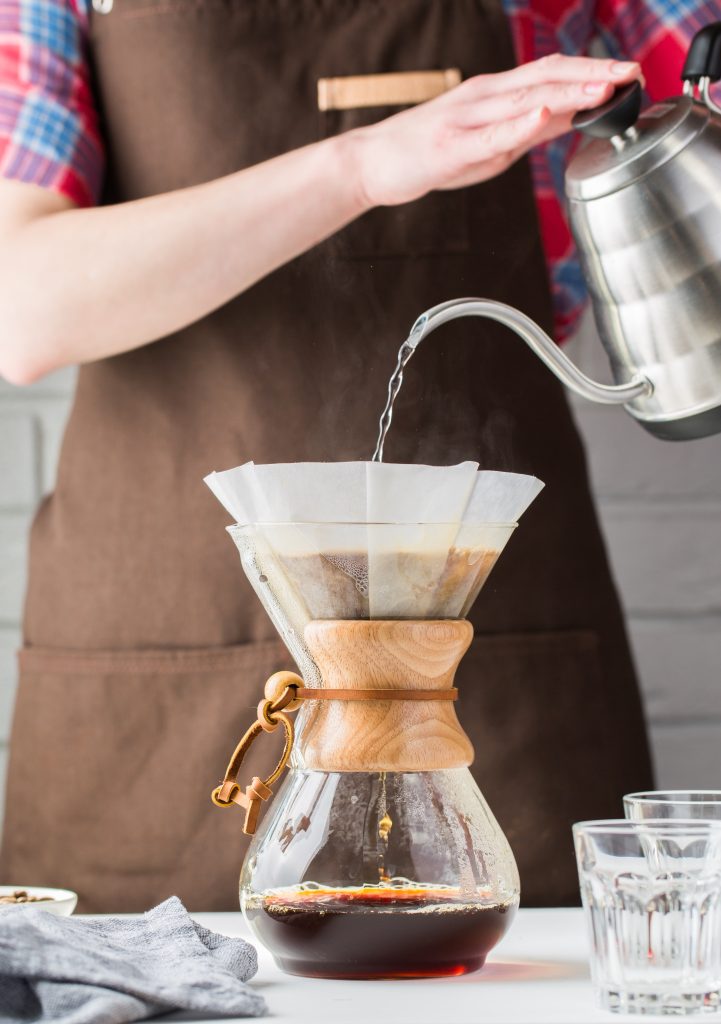
Does Coffee Bloat or Debloat?
While coffee is known to cause bloating in some individuals, it is also believed to have a de-bloating effect on the gut. This is due to the caffeine content in coffee, which has been shown to stimulate the digestive system and promote bowel movements.
However, it’s important to note that this effect may not be the same for everyone. Some people may find that coffee worsens their bloating and digestive symptoms, while others may experience relief.
In general, the de-bloating effect of coffee is more likely to be observed in individuals who have a regular coffee habit and are not consuming excessive amounts. Drinking too much coffee can actually have the opposite effect and lead to increased bloating and discomfort.
As I mentioned further up this article, the way you consume your coffee can impact its de-bloating effect. For example, adding sugar, milk, or cream to your coffee may negate the potential benefits and even exacerbate bloating.
So, does coffee bloat or debloat? The answer is, it depends. While it may have a de-bloating effect on some individuals, it can also worsen bloating in others. It’s important to listen to your body and pay attention to how you feel after consuming coffee.
If you’re experiencing persistent bloating or digestive discomfort, it may be worth considering reducing your coffee intake or cutting it out altogether to see if it makes a difference.
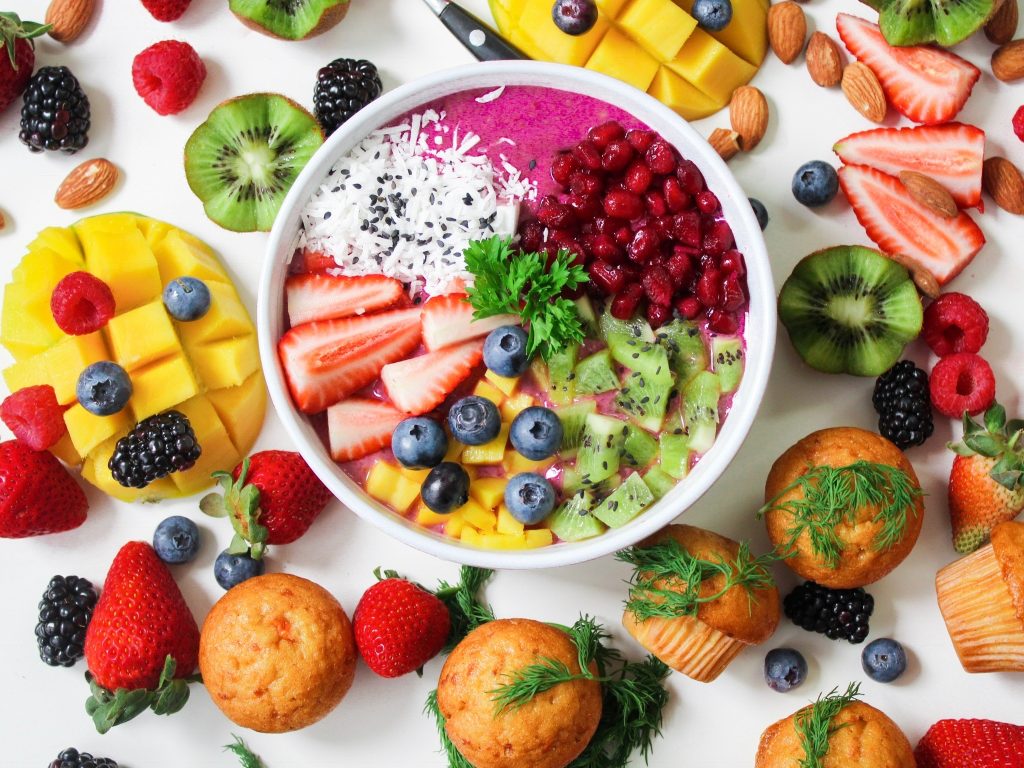
What Relieves Bloating Fast?
There are several things you can do to relieve bloating fast:
- Drink water: Staying hydrated can help flush out excess gas and relieve bloating.
- Move your body: Gentle exercise like walking or yoga can help stimulate your digestive system and ease bloating.
- Try ginger: Ginger has anti-inflammatory properties that can help relieve bloating and other digestive issues. Ginger tea is an easy way to take it.
- Eat probiotic foods: Fermented foods such as kim chi and sauerkraut are natural protiobcs. They are widely available and easy to eat alongside any of your meals. Probiotic foods can help balance the bacteria in your gut and alleviate bloating and other digestive issues. Here is a link to a simple sauerkraut fermentation recipe that is easy to make and full of natural probiotics.
How Gut Health Revolution Course Can Help
Our Gut Health Revolution course is designed to help you achieve a healthy, happy gut. You will literally learn to eat delicious foods that will heal and super charge your gut health and therefore every aspect of your health. Through our expert guidance and comprehensive resources, you’ll learn how to address bloating and other gut issues, and create sustainable habits for better gut health. With our personalised approach, you’ll receive the support and guidance you need to achieve your health goals.
Conclusion
Bloating is a common symptom of an unhealthy gut, and coffee can exacerbate it for some people. While cutting out coffee can help with bloating, it’s not the only solution
More Gut Health Recipes
The Happy Pear Podcast
“No fungi no forest no future. Fungi are as important as oxygen and yet we only think of them as icky things”
Episode 110
The mycelium network, is vast, diverse, intelligent and everywhere! In this episode, we’re thrilled to have Fungi Guy, the popular YouTuber, as our special guest.
Fungi Guy, also known as Ali, is a passionate forager and mushroom enthusiast with a wealth of knowledge and experience. He has been foraging for over a decade and has a deep appreciation for the incredible diversity, importance and beauty of mushrooms.
In this episode, Fungi Guy shares his vast knowledge on mushrooms, his approach to foraging, from identifying different species to selecting the best specimens for cooking. He also shares some of his favorite mushrooms and explains why they’re so special to him.
One of the things we love about Fungi Guy is his infectious enthusiasm for mushrooms and his commitment to sustainable foraging practices. He truly embodies the spirit of The Happy Pear, and we’re honored to have him as our guest.
So, if you’re a mushroom lover or just curious about the world of foraging, this episode is not to be missed! Tune in to hear from Fungi Guy and learn more about the fascinating world of mushrooms.
Lots of love,
Dave & Steve
Available now from all good podcast providers:
This episode is sponsored by Vivobarefoot Footwear. Vivobarefoot Footwear have given our listeners an exclusive 15% discount when you enter the code HAPPYPEAR15
Genuinely these are the only shoes you will see Dave & Steve wearing!
Produced by Sean Cahill and Sara Fawsitt
The Happy Pear Podcast
Slow aging and improve your health with water!
This week we speak to holistic doctor and author of Quench, Dr Dana Cohen.
For over two decades, Dr. Dana Cohen has been on the leading edge of integrative and functional medicine, guiding thousands of patients through protocols that initiate cellular repair and restore balance to the body.
Episode 109
Her unyielding devotion to her patients has helped countless patients on the brink of giving up hope to finally improve, recover, or completely heal from a variety of severe and chronic health issues.
We jump striaght into her recent research and book Quench and discuss in detail the magical healing power of water.
“Proper hydration is the key to unlocking optimal health. But we need to start looking at hydration for what it is: the very essence of your health.”
The benefits of proper hydration can have a dramatic effect on your health, your vitality, and your overall quality of life, according to Dr Dana. Quench will help you determine how to hydrate the right way (hint: it doesn’t involve chugging a gallon of water every day), and then how to get the water you do drink deep into your muscles, cells, and fascia (the connective tissue of your body), where it’s needed most.
A brilliant episode, that will leave you stuffing your face with fruit, veg and lemon infused water!
Lots of love,
Dave & Steve
Available now from all good podcast providers:
This episode is sponsored by Vivobarefoot Footwear. Vivobarefoot Footwear have given our listeners an exclusive 15% discount when you enter the code HAPPYPEAR15
Genuinely these are the only shoes you will see Dave & Steve wearing!
Produced by Sean Cahill and Sara Fawsitt
Sample Lesson: Why your gut microbiome loves fibre
Our powerful jaw muscles, the hydrochloric acid in our stomach, the digestive enzyme cocktails produced by our pancreas – these are all powerless when it comes to digesting the structural carbohydrates found only in plants that we call fibre.
We have outsourced this job to our gut microbes, and they do it incredibly efficiently. When we serve our microbes a steady supply of fibre rich foods – fruits, vegetables, wholegrains, beans, and unprocessed plants – we immediately boost the production of Short Chain Fatty Acids (SCFA), substances that we can only get from our gut microbes and have so many health benefits that it is difficult to keep up with the research!
Sample Lesson: Knife Skills
There are many variations of knives you can use in the kitchen. We decided that rather than getting lost in the world of different knives, we would instead tell you about our favourite 3. These are the most useful knives that will help to get you started and cooking up some magic!
- Chef’s knife
- Paring knife/ utility knife
- Bread knife
Sample Lesson: Do you need a probiotic supplement?
The human gut microbiome consists of a vast diversity of microscopic organisms and is a crucial player in our overall health. The bacteria, yeasts, viruses, and archaea of the gut microbiome first appeared on Earth between 2 and 4 billion years ago. They’ve been with humans on every single step of our own 7-million-year evolutionary journey. So, it shouldn’t surprise you to learn that you don’t need probiotic supplements to optimise or ‘balance’ your gut microbiome. Despite a thriving probiotic industry – one that is worth a massive $70 billion a year – there is surprisingly little evidence to support the health claims often made by probiotic companies.
Sample Lesson: Why FODMAPs are good for you
FODMAPS stands for fermentable oligosaccharides, disaccharides, monosaccharides, and polyols. These are small carbohydrates found in a variety of plant foods. These carbohydrates can be quite difficult for some people to break down and digest. If we don’t absorb them in our small intestine, they carry on down into our large intestine, where our gut microbiota lives (the bacteria that breaks down our fibres). Once the FODMAPS arrive here, they are broken down by our microbiome and this can cause bloating and gas, diarrhoea and sometimes constipation.
The Truth About Probiotics: Do You Really Need Them for Better Gut Health in Ireland?
When it comes to gut health, we often hear about probiotics and how they can help keep our gut bacteria in check. But with so many products on the market and conflicting information, it can be hard to know if we really need them. So, let’s get down to the truth about probiotics and whether they’re necessary for better gut health in Ireland.
Our gut microbiome is made up of a vast array of microscopic organisms, including bacteria, yeasts, viruses, and archaea. These tiny creatures have been with us on every step of our evolutionary journey, and they play a crucial role in our overall health. While probiotics have gained popularity in recent years, the truth is that you don’t necessarily need them to optimise or ‘balance’ your gut microbiome. Despite the huge market for probiotic products – valued at a whopping $70 billion annually – there’s surprisingly little scientific evidence to support the health claims made by the industry. So, let’s take a closer look at the truth about probiotics and what you really need for better gut health in Ireland.
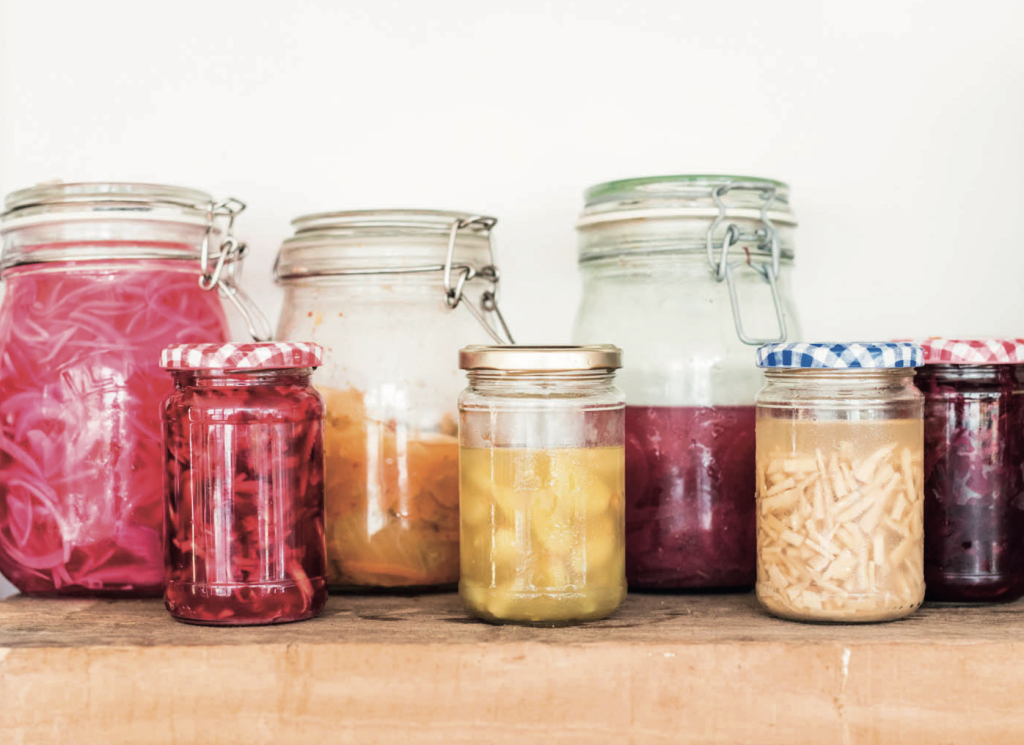
Section 1: Understanding Probiotics
If you’ve heard anything about gut health, you’ve likely heard about probiotics. These tiny organisms, found in foods and supplements, are said to have a host of benefits for our health. But what are they, exactly?
Think of probiotics as the good bacteria that live in your gut. They work to keep your digestive system healthy and happy, aiding in the breakdown and absorption of nutrients. And they’re not just in our gut – probiotics are found in fermented foods like kimchi, kombucha and sauerkraut.
Now, while it may sound counterintuitive to add more bacteria to your gut, the idea is that by increasing the amount of good bacteria, you can crowd out the bad. And that can lead to all sorts of benefits, from better digestion to a stronger immune system to even better mental health.
So, if you’re interested in improving your gut health, probiotics are definitely something to consider. Whether you get them from food or supplements, they can help keep your gut in top shape. But, as we’ll see in the next section, there are some potential downsides to consider as well.

Section 2: The Pros of Probiotics
Probiotics are like superheroes for your gut! These beneficial bacteria are great for maintaining and improving gut health. There are many reasons why you should consider incorporating probiotics into your diet. Here are just a few of the amazing benefits:
- Improved Digestion: Probiotics can help to break down food, making it easier for your body to absorb nutrients. They also help to balance the pH level in your gut, which can reduce bloating and other digestive discomforts.
- Boosted Immune System: Your gut is closely linked to your immune system with over 70% of your immune system cells being based in your gut. By eating probiotics, you can help to strengthen your immune system and reduce your risk of infections.
- Reduced Inflammation: Inflammation in the body can lead to a variety of health issues. Probiotics can help to reduce inflammation in the gut and throughout the body.
- Aids in Weight Loss: Research has shown that probiotics may help to reduce body weight and body fat percentage. By improving gut health, probiotics can help to regulate your metabolism and improve your body’s ability to burn calories.
Incorporating probiotics into your diet is an easy way to improve your overall health and wellbeing. And if you live in Ireland, it’s easy to find probiotic-rich foods and supplements to help you achieve optimal gut health. However Dr. Alan Desmond, consultant gastroenterologist who we created our Gut Health Revolution Course with says ‘Despite a thriving probiotic industry – one that is worth a massive $70 billion a year – there is surprisingly little evidence to support the health claims often made by probiotic companies. ‘
It’s important to remember that probiotics are just one piece of the puzzle. A healthy diet, regular exercise, and stress management are all important factors in maintaining gut health. And if you need additional support, be sure to check out the Gut Health Revolution Course – it’s a great solution to help you achieve optimal gut health.

Section 3: The Cons of Probiotics:
As much as probiotics have benefits, they are not perfect. One of the biggest downsides is that they may cause unwanted side effects, especially when taken in high doses. The most common side effects of probiotics include gas, bloating, and stomach upset. Some people may also experience allergic reactions, particularly if they have a history of food allergies or sensitivities.
Another issue with probiotics supplements is that not all strains are created equal. Some may be more effective than others, and some may not have any benefits at all. It can be challenging to know which strains are best for specific health issues, and there is a lot of variability in the quality of the supplements on the market.
Additionally, probiotics may interact with other medications, including antibiotics. In some cases, they may reduce the effectiveness of antibiotics or even cause harmful interactions.
Finally, there is limited research on the long-term effects of probiotic supplements use. While they have been shown to be safe for short-term use, there is still much to learn about the potential risks and benefits of prolonged probiotic supplementation.
It’s essential to consult with your healthcare provider before taking any new supplements, including probiotics. They can help you navigate the potential risks and benefits and determine if probiotics are right for you. And remember, there are plenty of other ways to support gut health, such as through a healthy diet and lifestyle habits.
Conclusion and Gut Health Revolution
In conclusion, while probiotics can be beneficial for some people, they are not a one-size-fits-all solution for gut health. It’s important to consider the potential cons and alternatives before deciding to take probiotics. And remember, a healthy gut can be achieved through a variety of lifestyle factors, such as eating a diverse diet, getting enough sleep, and exercising regularly.
If you’re looking for a comprehensive solution to improve your gut health, we highly recommend checking out the Gut Health Revolution course. This course is designed to provide you with the knowledge and tools you need to optimise your gut health and achieve better overall health and well-being. With a focus on natural and sustainable solutions, the Gut Health Revolution course offers a practical and effective approach to gut health that is tailored to your unique needs and preferences.
By following the tips and strategies outlined in the course, you can improve your gut health and experience the many benefits that come with it, such as improved digestion, stronger immunity, and better mental health. So, if you’re ready to take the next step in your gut health journey, consider enrolling in the Gut Health Revolution course today.
More Gut Health Recipes
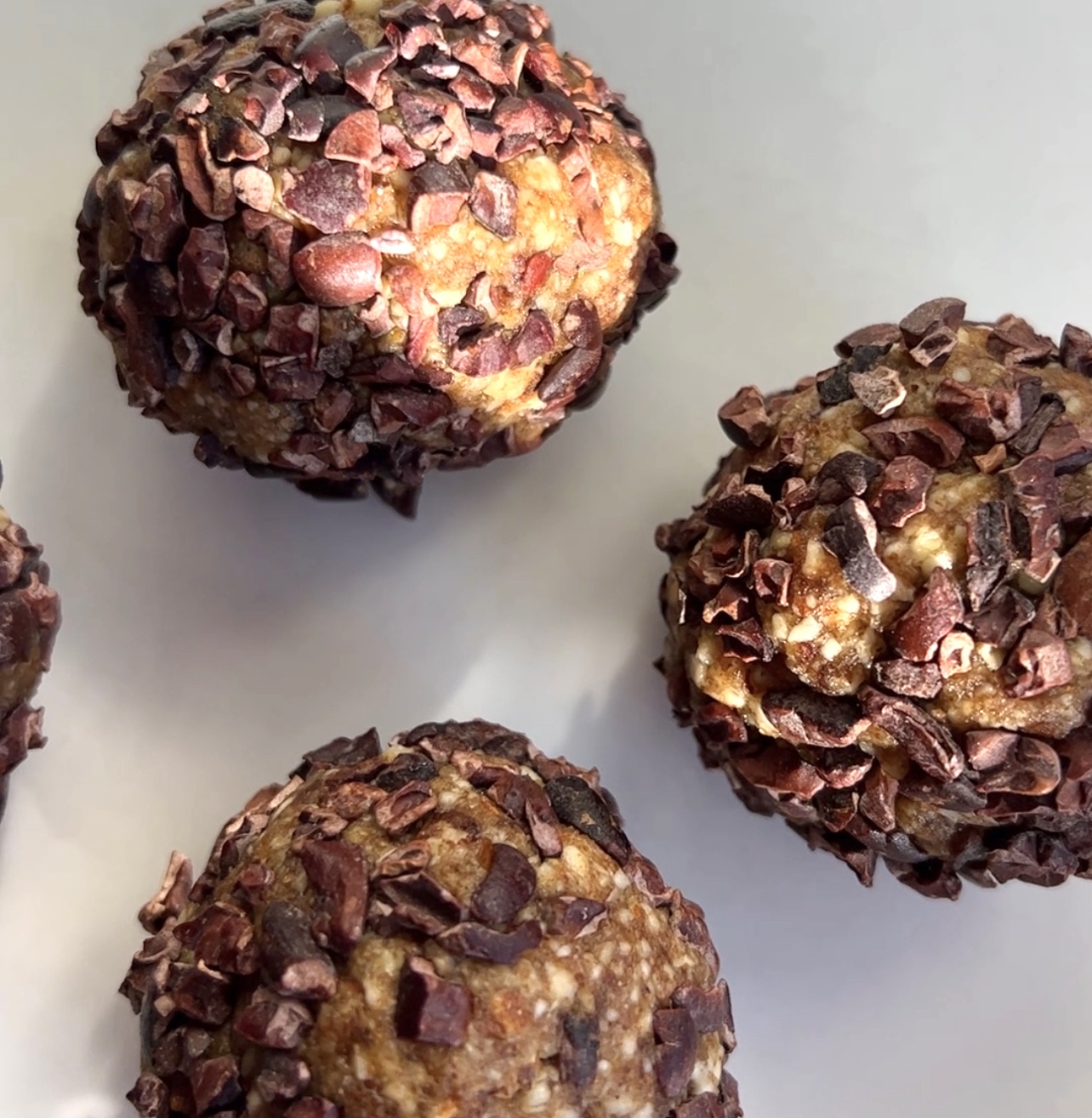
High Protein Gut Balls
Takes 14 minutes
Serves 8
Ingredients
Inside filling
- 100 g medjool dates
- 1 tbsp cocoa powder
- 1 tbsp maple syrup
- 2 tbsp plant milk
- 2 tsbp peanut butter
Outer layer
- 300 g medjool dates
- 300 g almonds
- ¼ tsp salt
- 2 tsp vanilla extract
- 100 g cocoa nibs
Instructions
- Prepare the Inside Filling:Remove the pits from the dates and add them to a food processor along with the cocoa powder, maple syrup, plant milk, and peanut butter. Blend until smooth, forming a consistency like a healthy chocolate spread.
- Shape the Inside Filling:Using 2 teaspoons, carefully shape the mixture into 8-10 small balls, approximately 2 cm in diameter. Set aside.
- Prepare the Outer Layer:Wash the food processor. Remove the pits from the dates for the outer layer and add them to the food processor along with the almonds, salt, and vanilla extract. Blend until the mixture is well combined.
- Shape the Outer Layer:Carefully shape and flatten portions of the outer layer into small rectangles, approximately 4 cm square. Place the inside filling ball in the centre of each rectangle, then fold the outer layer over, ensuring the inside filling is completely covered. Roll gently to form a smooth ball.
- Coat with Cocoa Nibs:Roll each ball in the cocoa nibs, ensuring they are well coated. Repeat with the remaining mixture.Enjoy!
Boost Your Gut Health with Probiotics and Prebiotics: A Beginner’s Guide
What are probiotics and prebiotics?
Okay, so let’s start with the basics. Probiotics are live bacteria and yeasts that are good for your gut health. They’re naturally found in your body, and you can also get them from food and supplements. On the other hand, prebiotics are non-digestible fibres that feed the good bacteria in your gut, promoting their growth.
Benefits of probiotics and prebiotics
Now, let’s talk about the good stuff. Adding probiotics and prebiotics to your diet has a ton of benefits, like improving your digestion, boosting your immune system, reducing inflammation, and aiding in weight loss. And you don’t just have to take our word for it – there’s plenty of scientific evidence to back it up!
How to incorporate probiotics and prebiotics into your diet
Adding probiotics and prebiotics to your diet is easier than you think. You can find them in a variety of foods, like yogurt (lots of plant based versions out there, our fav is coconut), kefir, sauerkraut, and kimchi. You can also take supplements if you’re not getting enough from your diet. However Dr. Alan Desmond who we created our Gut Health Revolution Course with says ‘Despite a thriving probiotic industry – one that is worth a massive $70 billion a year – there is surprisingly little evidence to support the health claims often made by probiotic companies‘ And the best part? You can enjoy probiotic fermented foods in so many delicious ways, like adding sauerkraut to your sandwich or drinking a refreshing glass of kombucha.
Vegan sources of probiotics and prebiotics
If you’re following a plant based or vegan diet, don’t worry most probiotic foods are plant based! Fermented foods like tempeh and miso are great options, as well as plant-based yogurts and Kombucha. You can also try making your own fermented foods at home – it’s easier than you think!
Precautions when consuming probiotics and prebiotics
While adding probiotics and prebiotics to your diet is generally safe, there are a few things to keep in mind. Be aware of possible allergic reactions, and don’t overconsume – too much of a good thing can have negative effects. If you’re unsure, talk to your doctor or a registered dietitian.
Conclusion
Incorporating probiotics and prebiotics into your diet is an easy and delicious way to improve your gut health and overall well-being. By following the tips in this article and consuming a variety of foods rich in these beneficial bacteria, you can achieve optimal gut health and lead a happier, healthier life. And if you want to take it to the next level, check out our Gut Health Revolution Course – it’s a game-changer!
More Gut Health Recipes
The Happy Pear Podcast
“A life not reflected is a life not worth living.”
This is the second time we have had our friend and very own life coach, Gerry Hussey on the podcast.
Episode 108
Gerry is a performance psychologist and also in more recent times been coined ‘The Soul Coach’. He has been in the human health and performance Field for almost 20 years.
Gerry has been at the forefront of building high performance teams and individuals in Olympic and Professional, sport and corporate organisations. His vast experience has seen him prepare and lead teams for success at Olympic Games, Heineken cups, World cups, and World and European championships.
He has worked and currently works with some of the world’s leading sport and business teams as well as coaching for high performing individuals.
Gerry is a leading voice that is challenging us to rethink health and performance in a whole new way and his integrated approach is one of honesty, simplicity and authenticity.
Another brilliant episode with Gerry, he really is the modern day sage!
Enjoy!
Lots of Love,
Dave & Steve x
Available now from all good podcast providers:
This episode is sponsored by Vivobarefoot Footwear. Vivobarefoot Footwear have given our listeners an exclusive 15% discount when you enter the code HAPPYPEAR15
Genuinely these are the only shoes you will see Dave & Steve wearing!
Produced by Sean Cahill and Sara Fawsitt
This Easy Mexican Chilli for gut health is packed with fibre so ideal for amping up your gut health where 70% of your immune system is.
Your gut is home to hundreds of trillions of microorganisms, bacteria, fungi, yeast, archaea. This collection of microorganisms are also known as your microbiome. Your microbiome exists In your large intestine and it works symbiotically with every system in your body.
Your gut health directly impacts every aspect of your health. Hippocrates, the father of modern medicine, back more than 2000 years ago said that ‘all disease starts in the gut’.
If you are looking for more recipes that are great for gut health, we have some very tasty gut health recipes here.
We also have compiled a great article on gut health, IBS, bloating and other foods to eat for gut health which you can check out here.
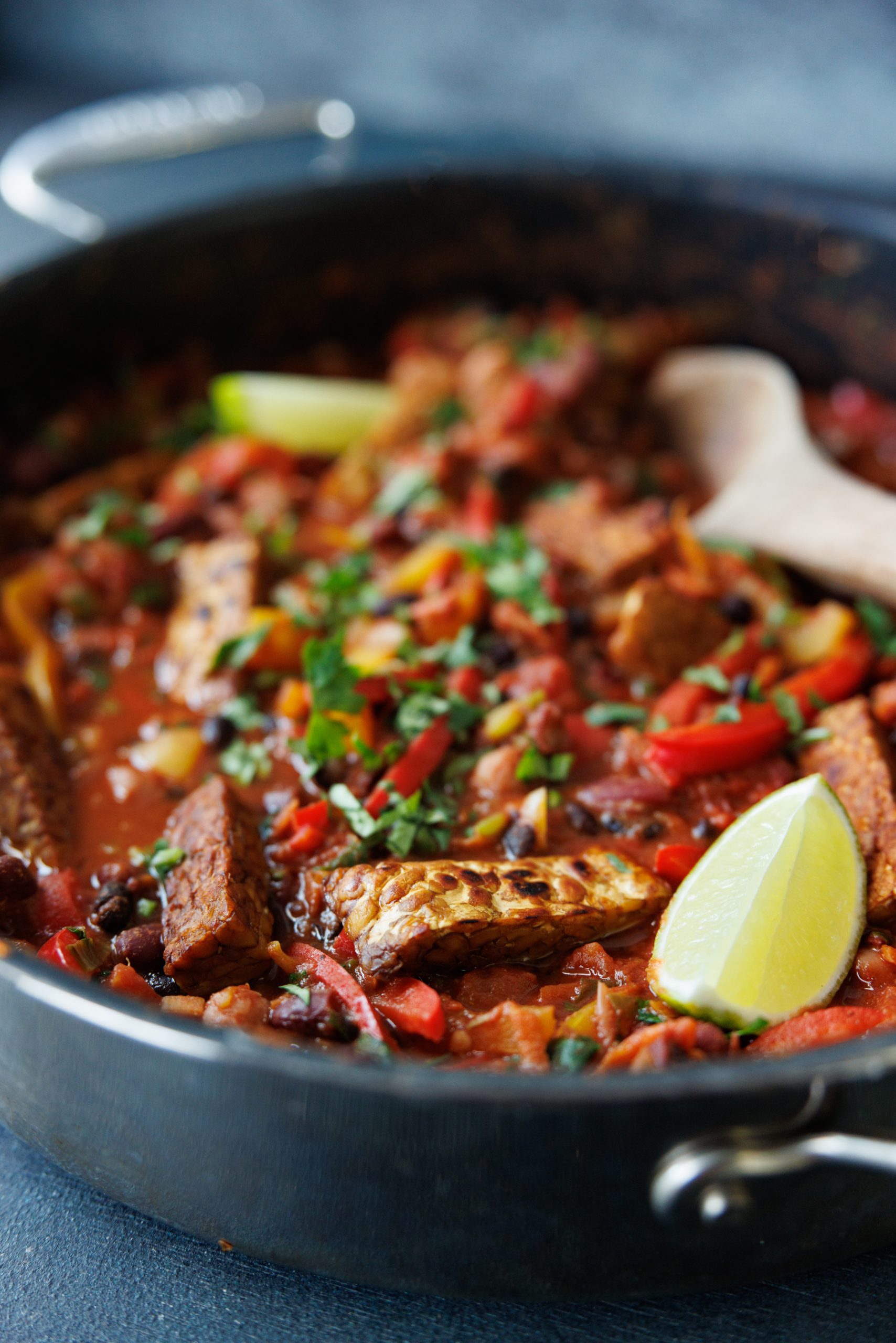
Easy Mexican Chilli for Gut Health
Takes 18 minutes
Serves 4
Ingredients
- 150 g tempeh/ tofu
- 6 spring onions/ scallions
- 1 carrot
- 1 red chilli
- 800 g mixed beans
- 400 g black beans
- 800 g chopped tomatoes
- 50 g dark chocolate (70%-80%)
- 1 tbsp smoked paprika
- 3 tbps Tamari
- 1 bunch coriander
- 1 red pepper
- 1 yellow pepper
Instructions
- Finely chop the spring onions/scallions. Grate the carrot. Chop the tempeh/tofu into small pieces. Finely chop the chilli. Drain and rinse the beans. Finely chop the red and yellow peppers.
- Put a small non-stick pan on a high heat and add the tempeh blocks with no oil. Cook on both sides till they golden and sear. This will take approx 3 mins on each side. Add 2 tablespoons of tamari and mix well and turn off the heat.
- Put the large non stick pan on a high heat. Once hot add the chopped spring onions and the carrot. Cook for 1 minute while stirring regularly. If anything starts to stick add 2 tablespoon of water and ‘deglaze’ the pan.
- Add the chopped red chilli and peppers to the pan along with a tsp of salt. Mix well and leave to cook for 3-4 minutes.
- Add the drained beans, the 2 tins of chopped tomatoes and the chocolate, the smoked paprika and the remaining 1 tablespoon of tamari. Cook for a further 2 minutes.
- Finely chop the coriander and add and mix through. Serve with the tempeh on top.
Notes
Nutrition
Video
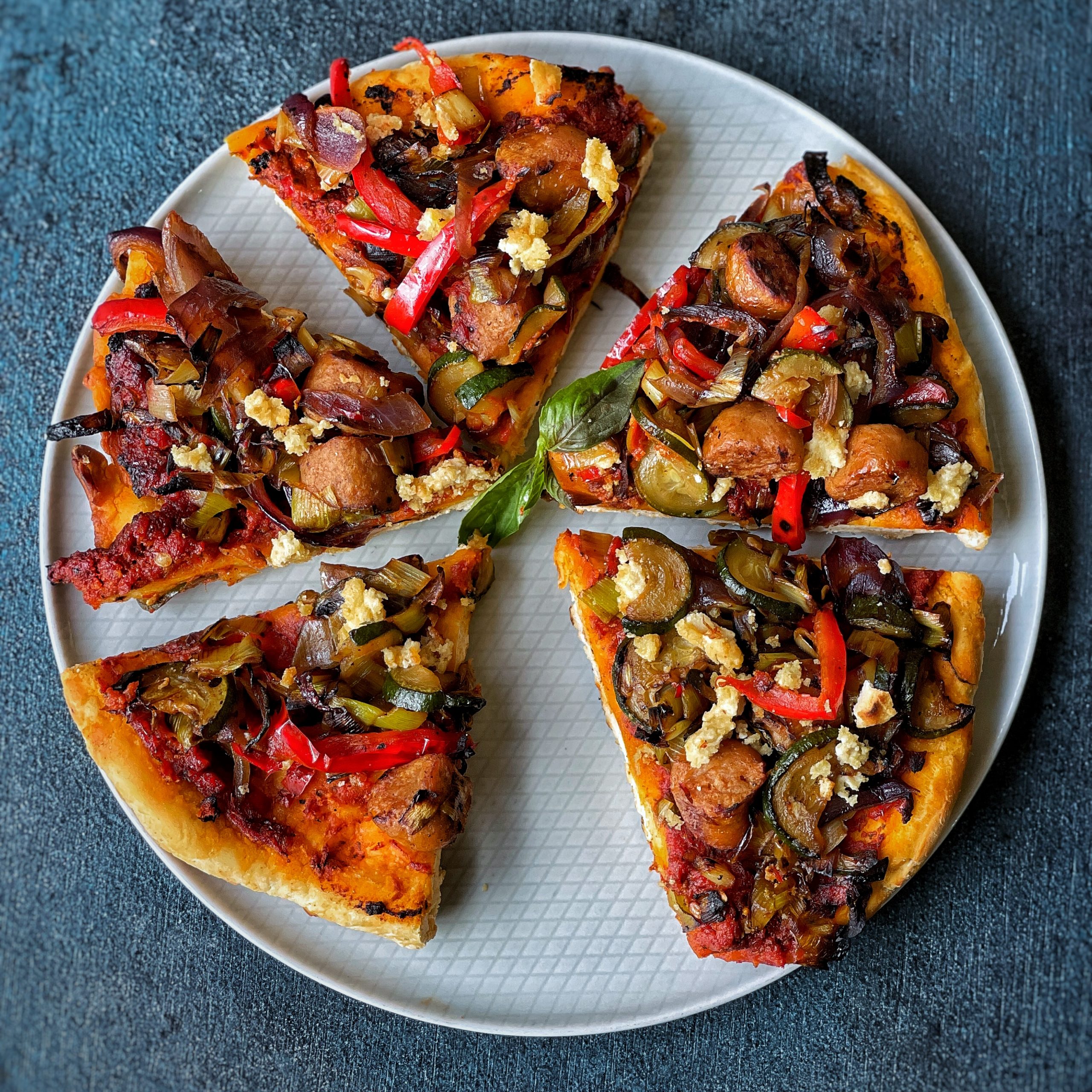
One Pan 20 minute epic pizza
Takes
Serves 1
Ingredients
Dough
- 250 g self raising flour
- 125 ml water
- Small pinch salt
Toppings
- 1 Tbsp oil
- 2 vegan sausages
- 1 small red onion
- 1 small leek
- 1 small red pepper or half large
- 1 small courgette (approx 120g)
- ½ red chiili
- ½ tsp salt
Sauce
- 2 tbsp tomato paste/ tomato puree
- 2 tbsp pesto of choice
Instructions
- Preheat oven to 250 C
- If using frozen vegan sausages defrost before using.
- For the toppings, chop up the vegan sausage into roughly 7 slices per sausage. Peel and slice the red onion into half moons, cut the leek in half lengthwise and into half moons (rinse to remove any sediment) chop the courgette and pepper into small bite size pieces, dice half a red chilli (remove the seeds if you like it less spicy).
- Put a large ovenproof frying pan (approx 30cm) on high heat, once hot add the oil and all the prepared veg and generous pinch of salt and sliced vegan sausages. Cook for 7-10 minutes stirring regularly until the onion and leek are nicely softened and the sausages are nicely charred. Remove the toppings from the pan to a bowl and wipe the frying pan clean.
- In a separate bowl mix the sauce ingredients together.
- To make your dough mix the ingredients together in another bowl and then knead dough on a lightly floured surface for 5-10 minutes until it forms a nice smooth elastic dough that is smooth to the touch. Alternatively you can mix it in a stand mixer with a dough hook for 4-5 minutes.
- By hand, flatten, stretch and shape your dough to roughly the size of the frying pan (ensure the pan is oven proof – no plastic) ensuring the dough is nice and thin in the middle. Heat the empty pan over a medium heat and add 1 tsp of oil, then carefully add the dough to the pan, pushing the dough to the edges to cover the bottom of the pan. Working quickly, spread the sauce in an even layer over the dough, then scatter your topping over the sauce. Cook over the heat for 4 – 5 minutes just until the base is nicely lightly browned. Then transfer to the preheated oven at 250 degrees C for 10 minutes.
- Carefully remove from the oven, the handle will be very hot.
- Slide your pizza onto a cutting board slice and enjoy!
Video
The Happy Pear Podcast
Do you feel optimistic about the future?
When a class of 200 graduates were asked to raise their hand if they felt optimistic about the future – No one did. Are you surprised?
Episode 107
This week we speak to Matthijs Schouten, the biologist, ecologist, lecturer and author of Nature’s mirror; the image of nature in a cultural-historical perspective
Matthijs G.C. Schouten B.Sc., M.Sc. D.Sc. studied biology and comparative religion at the University of Nijmegen and Celtic studies at the University of Amsterdam (the Netherlands).
He has worked as a lecturer at the University of Nijmegen and as an ecological project leader for the Wildlife Service (Dublin). He was the leader of the international campaign for the conservation of Irish bogs. Since 1992 he is senior ecological officer at the National Forest Service of the Netherlands; since 1995 he also is a visiting professor of nature and landscape conservation at University College Cork and University College Galway (Ireland); in 1999 he furthermore accepted the chair of restoration ecology at Wageningen University (the Netherlands).
In 1990 he was awarded the International Award for Conservation Merit by the World wide Fund for Nature and in 1992 the National University of Ireland granted him a honorary doctorate.
He has published widely in the fields of ecology and nature philosophy. His latest book Spiegel van de natuur; het natuurbeeld in cultuurhistorisch perspectief (Nature’s mirror; the image of nature in a cultural-historical perspective) has formed the basis for the exhibition World Nature Art in the Nieuwe Kerk in Amsterdam.
In this episode we explore the meaning of nature, how we have become detached and obsessed with the individual, driven by ego, how we need to reinstate rituals of contemplation, the power we all posses to make change, the importance of enchantment, connection and falling in love.
“Unless we accept how destructive we can be we can’t move ahead constructively.”
We loved this episode so much, Dave has already booked a trip to have lunch with Matthijs!
Enjoy!
Lots of Love,
Dave & Steve x
Available now from all good podcast providers:
This episode is sponsored by Vivobarefoot Footwear. Vivobarefoot Footwear have given our listeners an exclusive 15% discount when you enter the code HAPPYPEAR15
Genuinely these are the only shoes you will see Dave & Steve wearing!
Produced by Sean Cahill and Sara Fawsitt
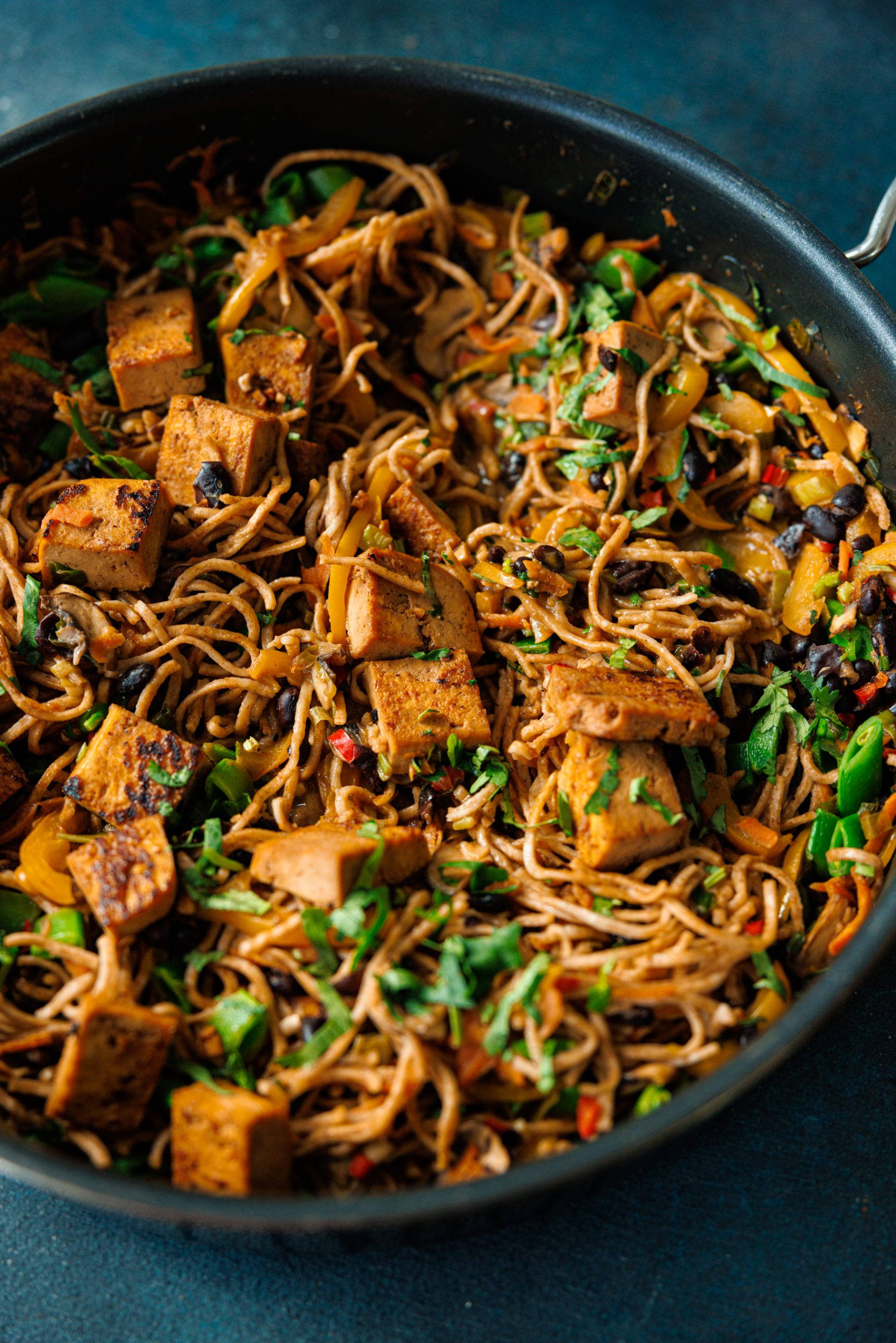
Easy Pad Thai in 10 Mins for Gut Health
Takes 10 minutes
Serves 4
Ingredients
- 200 g firm tofu
- 200 g whole wheat noodles
- 3 tbsp tamari
- 1 tbsp maple syrup
- 1 bunch scallions (green onions)
- 3 cloves garlic
- 1 thumb-sized piece of ginger
- 1 red chilli
- 150 g mushrooms
- 1 yellow pepper
- 1 grated carrot
- 400 g black beans (drained and rinsed)
- 400 ml coconut milk (use half the can)
- 50 g sugar snap peas
- Bunch of coriander
- Juice of ½ a lime
Instructions
- Boil the kettle, then fill a medium pot with the boiled water. Add the noodles and cook according to the instructions on the packet. Once cooked, drain and rinse them.
- Chop the firm tofu into medium-sized cubes. Peel and finely chop the garlic and ginger. Finely chop the scallions (green parts only), mushrooms, and yellow pepper. Drain and rinse the tin of black beans.
- Heat a wide-bottomed, non-stick pan on high heat. Once the pan is hot, reduce the heat to medium. Add the cubed tofu and cook until it starts to brown, turning to sear both sides. Add half of the garlic and ginger, and cook for 2 minutes, stirring regularly. When the tofu is seared, add 2 tablespoons of tamari and 1 tablespoon of maple syrup. If anything starts to stick, add 2-3 tablespoons of water and deglaze the pan. Remove the tofu from the pan and set aside.
- In the same pan, add the chopped yellow pepper, scallions, mushrooms, the remaining ginger, chilli, and grated carrot. Cook for 3 minutes. If anything starts to stick, add 2-3 tablespoons of water and deglaze the pan. Add the black beans, half the can of coconut milk, and the cooked noodles.
- Cook for a further minute or two, stirring to incorporate everything. Turn off the heat. Taste and season with salt. Start with 1 teaspoon of salt and adjust to taste if necessary. Squeeze over the juice of ½ a lime.
- Finely chop the coriander and sugar snap peas and add them to the dish before serving.
Notes
Video
How your gut affects your moods and mental health

The Gut Brain Axis
The gut and brain are connected through the gut-brain axis, which means that our gut health can have a significant impact on our mental health. A healthy gut microbiome (the population of microorganisms living in the gut) can help regulate mood, reduce inflammation, and improve brain function. On the other hand, an imbalanced gut microbiome has been linked to several mental health conditions, such as depression, anxiety, and stress. Furthermore, certain types of gut bacteria can produce neurotransmitters that influence mood, while others can influence the production of hormones such as cortisol, which plays a role in stress. To maintain good gut and mental health, it is important to eat a diet high in fibre, reduce stress, and avoid antibiotics and processed foods whenever possible.
In regards to mental health, butyrate is a short chain fatty acid that is made by the healthy fibre loving microbes in our gut. It has been suggested to have a positive impact in terms of moods and mental health as it can cross the blood-brain barrier and has been shown to have effects on neurotransmitter production, inflammation and oxidative stress, which are all involved in various mental health disorders.
The role of Vagus Nerve
The connection between the gut and the brain via the vagus nerve is referred to as the gut-brain axis.
Studies have shown that the vagus nerve plays a crucial role in the communication between the gut and the brain, and influences various functions including digestion, immunity, and mood. The vagus nerve transmits information from the gut to the brain and vice versa, allowing the brain to respond to changes in the gut and modulate gut function.
In regards to mental health, research suggests that an overactive or underactive vagus nerve can contribute to depression, anxiety and other mental health disorders. The vagus nerve has been shown to regulate the release of neurotransmitters, such as serotonin, that play a role in mood regulation, and can also modulate the body’s stress response.
Therefore, the vagus nerve is considered a key factor linking the gut and brain, and can have a significant impact on both gut and mental health.
The role of diet in terms of gut health and its influence on mental health
Diet has a significant impact on gut health, and therefore can also influence mental health. Some of the foods that are beneficial for gut health can positively impact mental health. These include:
- Fibre-rich foods: Foods high in fibre, such as fruits, vegetables, beans and whole grains, can promote the growth of beneficial gut bacteria and improve gut motility.
- Fermented foods: Fermented foods, such as kim chi and sauerkraut, are rich in probiotics that can help maintain a healthy gut microbiome.
- Polyphenol-rich foods: Foods rich in polyphenols, such as berries, nuts, and green tea, have anti-inflammatory effects and can support gut health.
- Omega-3 fatty acids: Omega-3 fatty acids all have anti-inflammatory effects and can support gut barrier function. Plant-based sources include walnuts, ground flax seeds, chia seeds
- Prebiotic foods: Prebiotic foods, such as onions, garlic, and asparagus, provide fuel for beneficial gut bacteria to thrive.
It’s important to note that everyone’s gut is unique and what works for one person may not work for another. A diverse plant based or plant predominant diet that includes a variety of nutrient-dense foods can help maintain a healthy gut and positive mental health.
If you want to learn more about the role of diet and what foods you can eat to super charge your gut, check out this in depth article we wrote on the gut along with Dr. Alan Desmond, Consultant gastroenterolist.
If you are looking for some gut health recipes – here is a link to lots of our gut health recipes
The Happy Pear Podcast
How do we get you to keep scrolling?
This is the aim of the applications on your phone. The more they can steal your focus and attention the more profitable they are.
So how can you take advantage of the benefits of technology whilst not letting it take advantage of you?
Episode 106
This week we speak to Johann Hari, the author of the New York Times bestseller: Stolen Focus: Why You Can’t Pay Attention.
Johann is an author, executive producer and Tedtalk speaker. His books have been translated into 40 languages, and been praised by a broad range of people, from Oprah to Noam Chomsky, from Elton John to Naomi Klein.
Johann’s first book, ‘Chasing the Scream: the First and Last Days of the War on Drugs’, was adapted into the Oscar-nominated film ‘The United States Vs Billie Holiday’. His second book, ‘Lost Connections: Uncovering The Real Causes of Depression – and the Unexpected Solutions’ was described by the British Journal of General Practice as “one of the most important texts of recent years”, and shortlisted for an award by the British Medical Association.
Johann’s TED talks have been viewed more than 93 million times. He has written over the past decade for some of the world’s leading newspapers and magazines, including the New York Times, the Los Angeles Times, the Guardian, the Spectator, Le Monde Diplomatique, the Sydney Morning Herald, and Politico. He has appeared on NPR’s All Thing Considered, HBO’s Realtime With Bill Maher, The Joe Rogan Podcast, the BBC’s Question Time, and many other popular shows.
Johann was twice named ‘National Newspaper Journalist of the Year’ by Amnesty International. He has also been named ‘Cultural Commentator of the Year’ and ‘Environmental Commentator of the Year’ at the Comment Awards.
A fascinating person who lives half the year in London, and spends the other half of the year traveling to research his books. We caught up with Johann one sunny afternoon and delved deep into what it means to loose focus, the effects it has on the brain, how our children are being affected by technology, and how we can regain focus and become more present.
A great episode!
Enjoy!
Lots of Love,
Dave & Steve x
Available now from all good podcast providers:
This episode is sponsored by Vivobarefoot Footwear. Vivobarefoot Footwear have given our listeners an exclusive 15% discount when you enter the code HAPPYPEAR15
Genuinely these are the only shoes you will see Dave & Steve wearing!
Produced by Sean Cahill and Sara Fawsitt
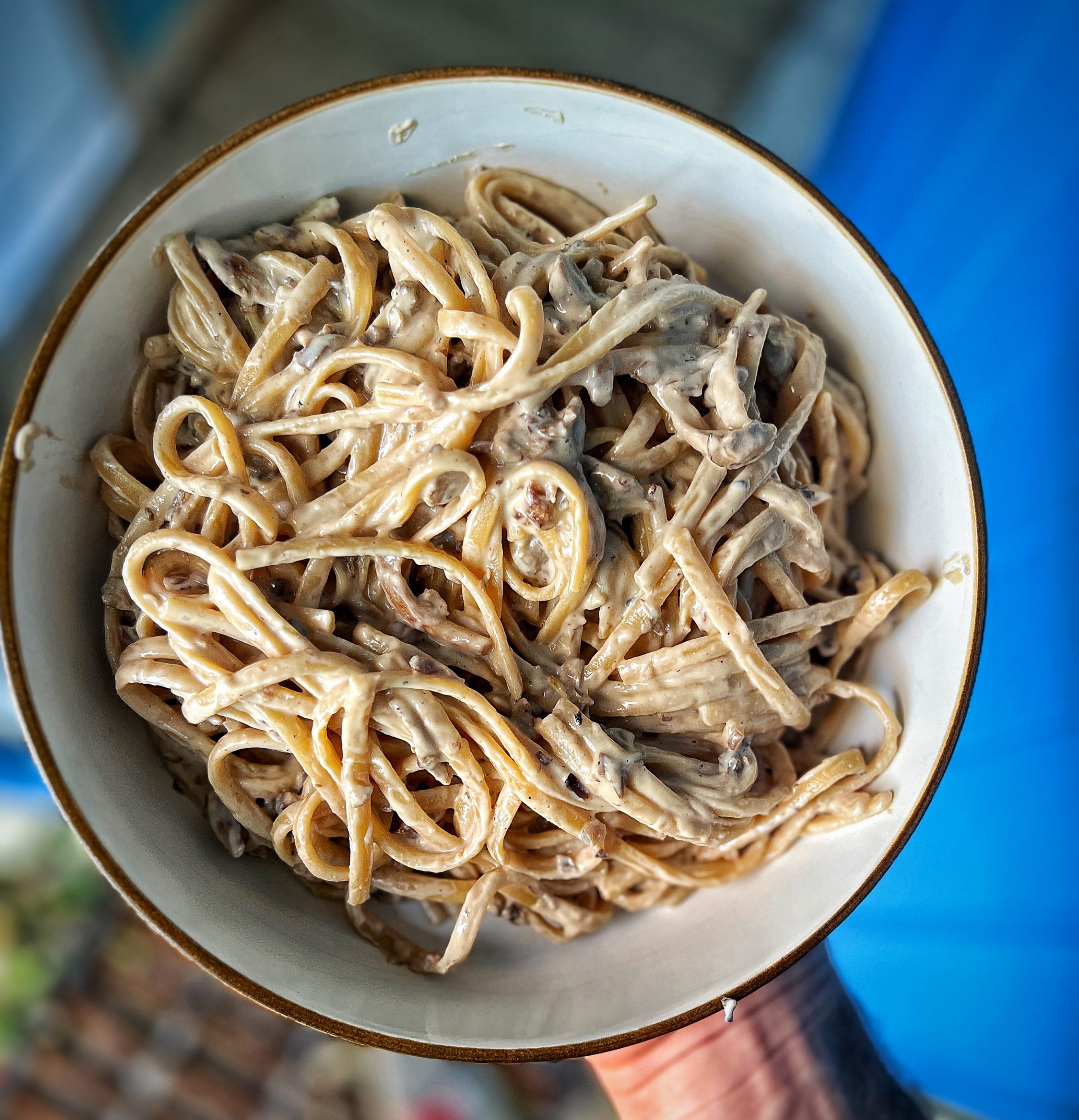
Creamy Mushroom Linguine
Takes 20 minutes
Serves 4
Ingredients
Linguine
- 250 g linguine
- 250 g Oyster Mushroom
- 1 onion
- 1/2 tsp garlic powder
- 2 tbsp tamari
Creamy Cashew Sauce
- 100 g cashew nuts
- 500 ml oat milk
- juice of half a lemon
- 1 tsp garlic powder
Instructions
- Prepare the Cashews: Place the cashew nuts in a small pot and cover with boiling water. Simmer gently for 5-10 minutes, then drain and rinse.
- Cook the Pasta: Fill a large saucepan with boiling water and add 1 tbsp of salt. Add your pasta and cook according to package instructions.
- Prepare the Vegetables: Peel and finely slice the onion and garlic. Finely chop the mushrooms.
- Cook the Onion and Mushrooms: Heat a large wide bottom pan over high heat. Add 1 tbsp of oil (or a few sprays of oil), followed by the onions and ½ tsp of salt. Reduce the heat to medium and cook for 4-5 minutes stirring until the onions brown slightly. Stir occasionally. Add the chopped mushrooms and garlic and cook for another 4-5 minutes. Stir in the tamari, cook for an additional minute, then turn off the heat.
- Prepare the Cashew Sauce: While the mushrooms are cooking, make the cashew sauce. Add the drained and rinsed cashew nuts and the rest of the sauce ingredients to a blender or food processor. Blend at high speed until smooth. Add the creamy cashew sauce to the pan, then turn the heat to medium. Cook for 1-2 minutes, stirring continuously, to allow the sauce to thicken.
- Combine the Pasta, Sauce & Mushrooms: Drain the cooked pasta, reserving some pasta water. Mix the pasta into the sauce, making sure the pasta is well coated. If the sauce is too thick, add reserved pasta water until you reach your desired creamy texture. If it is too watery, cook for a few minutes stirring constantly to avoid sticking. Taste and adjust seasoning with salt and black pepper as needed. Add the mushrooms and mix through.
- Garnish and Serve: Optionally, garnish with finely sliced fresh red chilli and/or fresh oregano or thyme. Serve hot and enjoy your creamy, comforting pasta!
Nutrition
We love this recipe, really quick to make, super tasty and everyone will be
looking for more, we are aware that is quite a promise but these burgers will
deliver!! Really worth seeking out the nutritional yeast as it gives a nice
distinct flavour to it and a couple of slices of vegan cheese is not essential
but really takes it to the next level. We like to serve them with vegan mayo,
lettuce, gherkins, ketchup, red onion and tomato. We fried ours up in the
pan for two minutes, but these are lovely cooked in the grill.
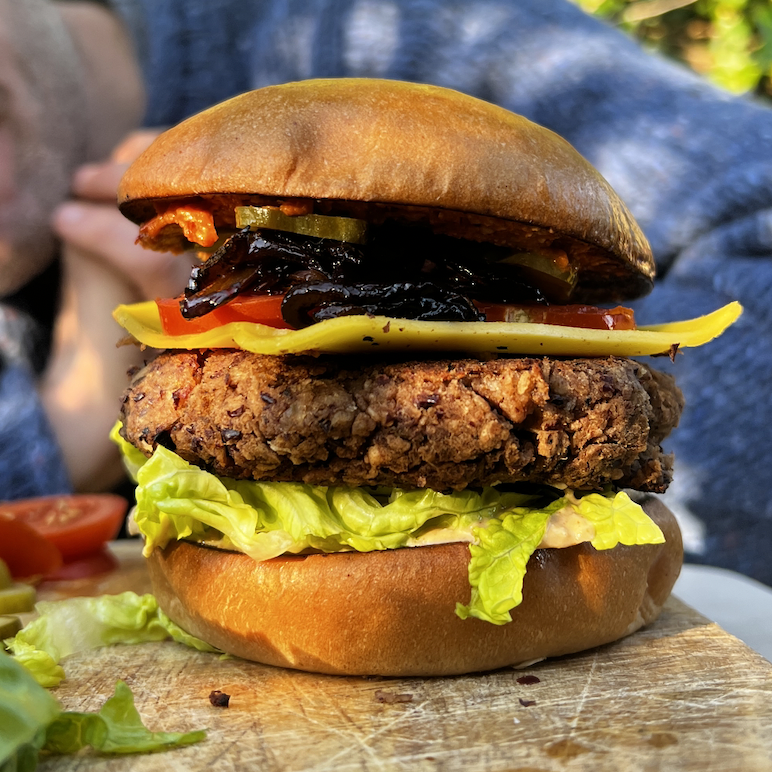
Epic Veg Burger
Takes 15 minutes
Serves 3
Ingredients
- 400 g kidney beans
- 1 onion
- 2 cloves garlic
- 150 g Oyster mushroom any kind of mushrooms will work!
- 4 tbsp Tamari
- 100 g breadcrumbs
- 3 tbsp nutritional yeast
Serving suggestions
- Favourite buns
- Vegan Mayonnaise
- Spicy Pepper Pesto
- Ketchup
- Lettuce Leaves
- Tomatoes
- Vegan Cheese
- Lettuce shredded, for extra naughtiness!
- Tomato
- Caramelised Onion
- Gherkins
- Avocado slices
Instructions
- Drain and rinse the beans. Peel and finely chop the onion and garlic. Roughly chop the mushrooms.
- Put 3 tablespoons of water into a frying pan on a high heat. Once hot, add the onion and garlic and cook for 1-2 minute, stirring regularly. Add the mushrooms into the pan and cook for a further minute. Now add the tamari, and stir fry for 2 minutes. Remove from the heat.
- In a mixing bowl, add the breadcrumbs, beans and the nutritional yeast and mix well.
- When the mushrooms are done, add them into the bowl and mix. Leave to cool for a minute. Using your hands or a wooden spoon mash and mix so that well mixed. Form this mixture into patties, making sure to really compress them so as to remove as much moisture as possible.
- The patties are now ready to cook. You can either fry them in the pan for 2 minutes on each side till they go golden or grill them in the oven at 180C/F/gas mark and they are also great grilled on the barbecue!
- Serve in your favourite bun bun with whatever tickles your fancy! We went a bit of everything…pesto, cheese, lettuce, tomatoes, gherkins and for real indulgence…caramelised onions. ENJOY, this one is epic!!
Nutrition
The Happy Pear Podcast
What does it mean to be an explorer?
What are the sacrifices one must take?
What are the benefits of putting yourself through such hard physical challenges?
Episode 105
This week we speak to Damian Browne, an extreme adventurer, peak performance athlete and International keynote speaker from Galway, Ireland.
For the last 25 years Damian has pursued his human potential, relentlessly pushing his body & mind to their perceived limits; forging himself & his character in what he deems “a crucible life”.
During a 16-year career as a professional rugby player, Damian donned the colours of some of rugby’s European elite, including Northampton Saints & Leinster; where he won club rugby’s biggest prize, The Heineken Cup.
Since retirement from professional rugby, Damian has become one of the World’s foremost extreme adventurers; undertaking some of the most demanding physical and mental challenges on the planet, including the 257km Sahara Desert ultra marathon, The Marathon des Sables, climbed 5 of the 7 Summits, a renowned mountaineering feat & most recently created history by becoming the first person ever to row from New York City to Galway, taking 112 days and in the process become one of only a handful of people to have rowed the Atlantic in both directions.
Damian’s drive to explore his physical & mental limits is not exclusive to ultra endurance events and he is a multi-time Irish indoor rowing champion, holding all-time, all-category records for the 500m and 1000m distance.
We were lucky to have had Damian in the studio with us for this episode, a brilliant and deep character, we hope you enjoy this episode as much as we did.
Enjoy!
Lots of Love,
Dave & Steve x
Available now from all good podcast providers:
This episode is sponsored by Vivobarefoot Footwear. Vivobarefoot Footwear have given our listeners an exclusive 15% discount when you enter the code HAPPYPEAR15
Genuinely these are the only shoes you will see Dave & Steve wearing!
Produced by Sean Cahill and Sara Fawsitt
The Happy Pear Podcast
Let’s lean into the discomfort by plunging into cold water or sweating through a hot sauna with metabolic scientist and author of Winter Swimming, Susanna Søberg.
Episode 104
We have been jumping into the sea for the last 8 years, we knew it was good for us, simply by how it made us feel: Elevated, alive, new, refreshed, giddy, more connected to those around us and overall a feeling of happiness. Now after so much research we are aware of how truly beneficial cold water and heat exposure is for us, from the serotonin, dopamine and oxytocin hits, to the longevity benefits and the effect it has on our metabolism. We discuss it all with Susanna and even take things a step further into the community benefits.
Susanna Søberg, PhD., earned her doctorate researching metabolism and has worked for many years designing and conducting clinical studies. Her most recent research and the background for this book have been on fat reduction through winter swimming at the Tryg Foundation’s Center for Physical Activity, Denmark. Winter Swimming, now published in thirteen languages, is her first book.
Founder and CEO of www.soeberginstitute.com . Susanna has also created a course, The Thermalist Cure, all about how and why to get started with cold, heat, and breathwork for better health. The course launches on 24th January and she has kindly offered our listeners a 10% discount with the code THEHAPPYPEAR
A brilliant episode that is on a topic close to our hearts.
Enjoy!
Lots of Love,
Dave & Steve x
Available now from all good podcast providers:
This episode is sponsored by Vivobarefoot Footwear. Vivobarefoot Footwear have given our listeners an exclusive 15% discount when you enter the code HAPPYPEAR15
Genuinely these are the only shoes you will see Dave & Steve wearing!
Produced by Sean Cahill and Sara Fawsitt
This is so genuinely tasting and easy to make – you will be surprised how good this is in even just 5 mins. Even if this ends up taking you 10 mins to make you will still have a super tasty quick dinner that will be faster to make than ordering a take away!
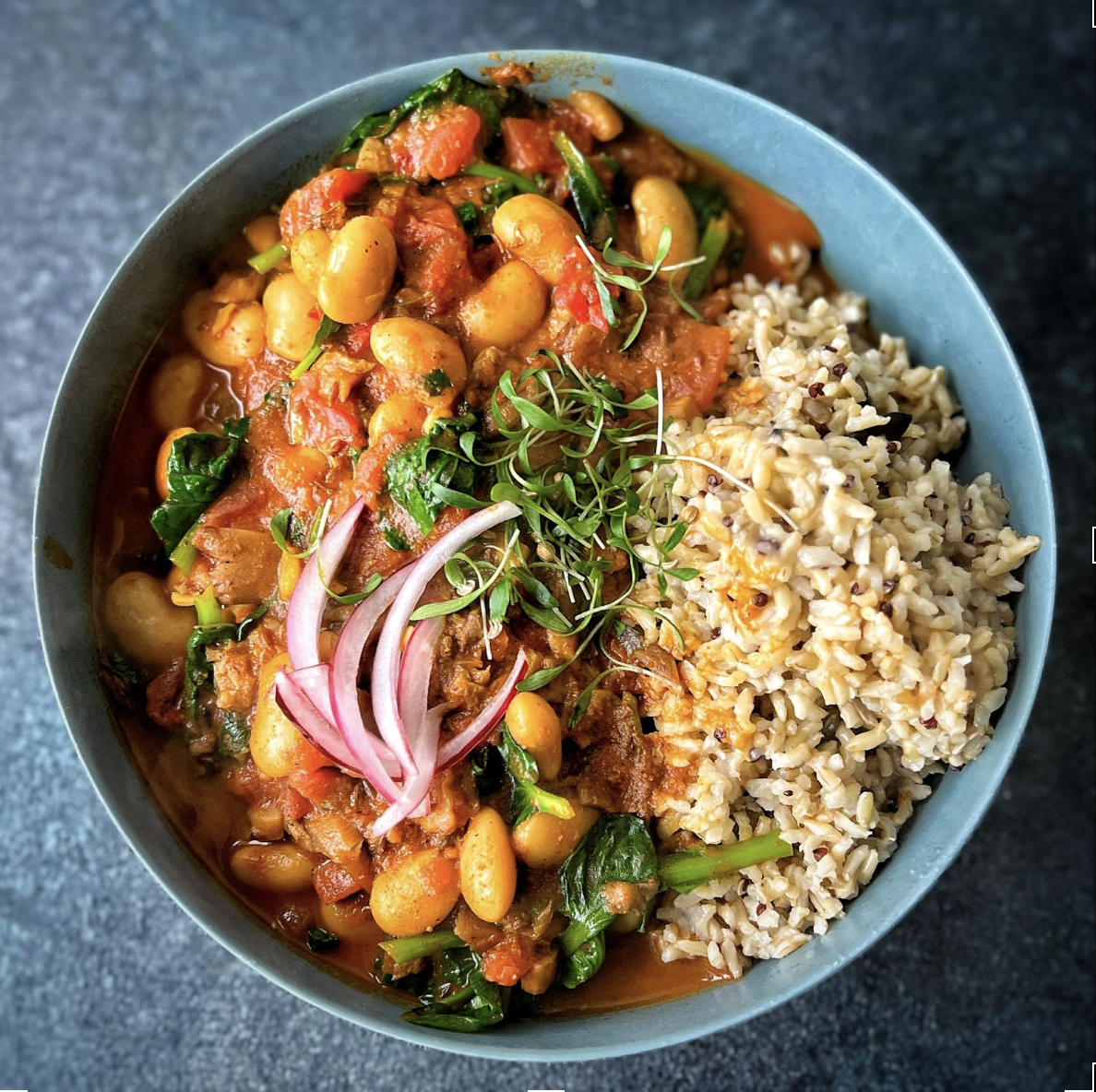
5 Mins Spinach, Mushroom and Butterbean curry
Takes 10 minutes
Serves 2
Ingredients
- 1 tbsp oil
- 1/2 thumsized ginger
- 2 cloves garlic
- 1/2 red chilli
- 200 g mushrooms (ideally oyster mushrooms)
- 2 tbsp tamari
- 1 tbsp cumin seeds
- 2 tbsp curry powder
- 1/4 ground pepper
- 400 g butter beans
- 400 g chopped tomatoes
- 200 g coconut milk
- 50 g baby spinach
To serve
- Pickled red onion
- Coriander shoots Serve with your favourite grain of choice, we used a pre cooked brown rice and served this beautiful curry with some pickled red onions and some coriander shoots. Enjoy!
Instructions
- Heat a wide bottomed non-stick pan on high heat. Chop the mushrooms into bite sized pieces. Peel and finely dice the ginger and garlic, finely dice the ½ red chilli, leaving the seeds in if you prefer it hot or removing the seeds for a milder spiced curry.
- Drain and rinse the butter beans. Once the pan is hot add the oil along with the mushrooms, diced ginger and cumin seeds and cook for 2 mins.
- Next add the garlic and chilli and mix through, stirring occasionally. Add in the tamari or soy sauce and thoroughly mix through ensuring to coat each mushroom in the sauce. Add in the butter beans, followed by the chopped tomatoes, coconut milk, curry powder and ground black pepper and cook for a minute bringing the temperature up, while stirring occasionally.
- Taste and adjust the seasoning to your liking by adding more salt, black pepper or lime juice.To finish add in the baby spinach and allow it to wilt down for 1 minute.
- Serve with your favourite grain of choice, we used a pre cooked brown rice and served this beautiful curry with some pickled red onions and some coriander shoots. Enjoy!
Nutrition
The Happy Pear Podcast
Dating, partying, socialising, special occasions, holidays… without alcohol does this sound difficult to you?
Could you imagine going sober at the age of 26 without using the excuse “I am on antibiotics” or “I am working tomorrow”?
Episode 103
This week we spoke to the founder of the Sober Girl Society and one of the leading voices on the sobriety movement, Millie Gooch.
At the age of 26 Millie decided to make a big lifestyle change, she quit drinking. After too many binge drinking nights that left her feeling anxious, and insecure. She realised she needed a change.
Millie has written for a range of publications, and her campaigning work has been featured everywhere from ELLE and Stylist to the BBC and Evening Standard.
In this episode, Millie gives us practical advice for how to date, party and socialise sober. We debunk the myths surrounding sobriety and how having a healthier relationship with alcohol can massively improve your confidence, relationships, productivity and your relationship with yourself.
We loved chatting to Millie, she is a brilliant voice for the movement.
Enjoy!
Lots of Love,
Dave & Steve x
Available now from all good podcast providers:
This episode is sponsored by Vivobarefoot Footwear. Vivobarefoot Footwear have given our listeners an exclusive 15% discount when you enter the code HAPPYPEAR15
Genuinely these are the only shoes you will see Dave & Steve wearing!
Produced by Sean Cahill and Sara Fawsitt

Meaty Spag Bol
Takes 7 minutes
Serves 2
Ingredients
- 200 g spaghetti (whole wheat is great for fibre)
- 2 cloves garlic
- 2 onions (medium)
- 1 carrot
- 400 g jackfruit
- 2 tbsp tamari
- 150 g oyster mushroom
- 400 g cooked lentils
- 800 g chopped tomatoes
- 200 g jar of tomato puree
- 1 tsp salt
- ¼ tsp black pepper
- small bunch of basil
Instructions
- Cook the pasta: Fill a pot with 3L of water and bring it to the boil (using a kettle will speed things up). Once boiling, reduce to medium heat and add 1 tbsp of salt. Add the dried pasta and cook according to the pack instructions.
- Prepare the vegetables: Drain and rinse the lentils and jackfruit. Peel and finely dice the onions and garlic. Finely dice the carrot. Chop the mushrooms into small, bite-sized pieces. Slice the jackfruit into thin, bite-sized strips.
- Cook the aromatics: Heat a wide-bottomed non-stick pan on high heat. When hot, add the chopped onion and fry for 3-4 minutes until it starts to brown. Add the garlic, diced carrots, and a pinch of salt. Reduce the heat to medium and cook for 3-4 minutes, stirring regularly. If the mixture starts to stick, add a couple of tablespoons of water to deglaze the pan using a wooden spoon.
- Cook the mushrooms and jackfruit: Add the mushrooms and jackfruit to the pan and cook for 3-4 minutes, stirring occasionally, until they start to char. Add tamari and mix well so that the mushrooms and jackfruit absorb the umami flavour.
- Drain the pasta: Once the pasta is cooked, drain it but reserve 50ml of pasta water to dilute the sauce later if needed.
- Finish the Bolognese: Add the drained lentils, chopped tomatoes, tomato purée, and the remaining salt and pepper to the pan. Bring the mixture to a boil, then lower to a simmer. Cook for 5 minutes, stirring occasionally to allow the flavours to meld.
- Combine pasta and sauce: Add about 50ml of the reserved pasta water to the sauce, then stir in the cooked pasta. Mix well to combine.
- Add basil: Remove the basil leaves from the stalks. Finely chop the stalks and add them to the sauce. Taste and adjust the seasoning as needed.
- Serve: Garnish with fresh basil leaves and enjoy your meaty spaghetti Bolognese!
Nutrition
Video
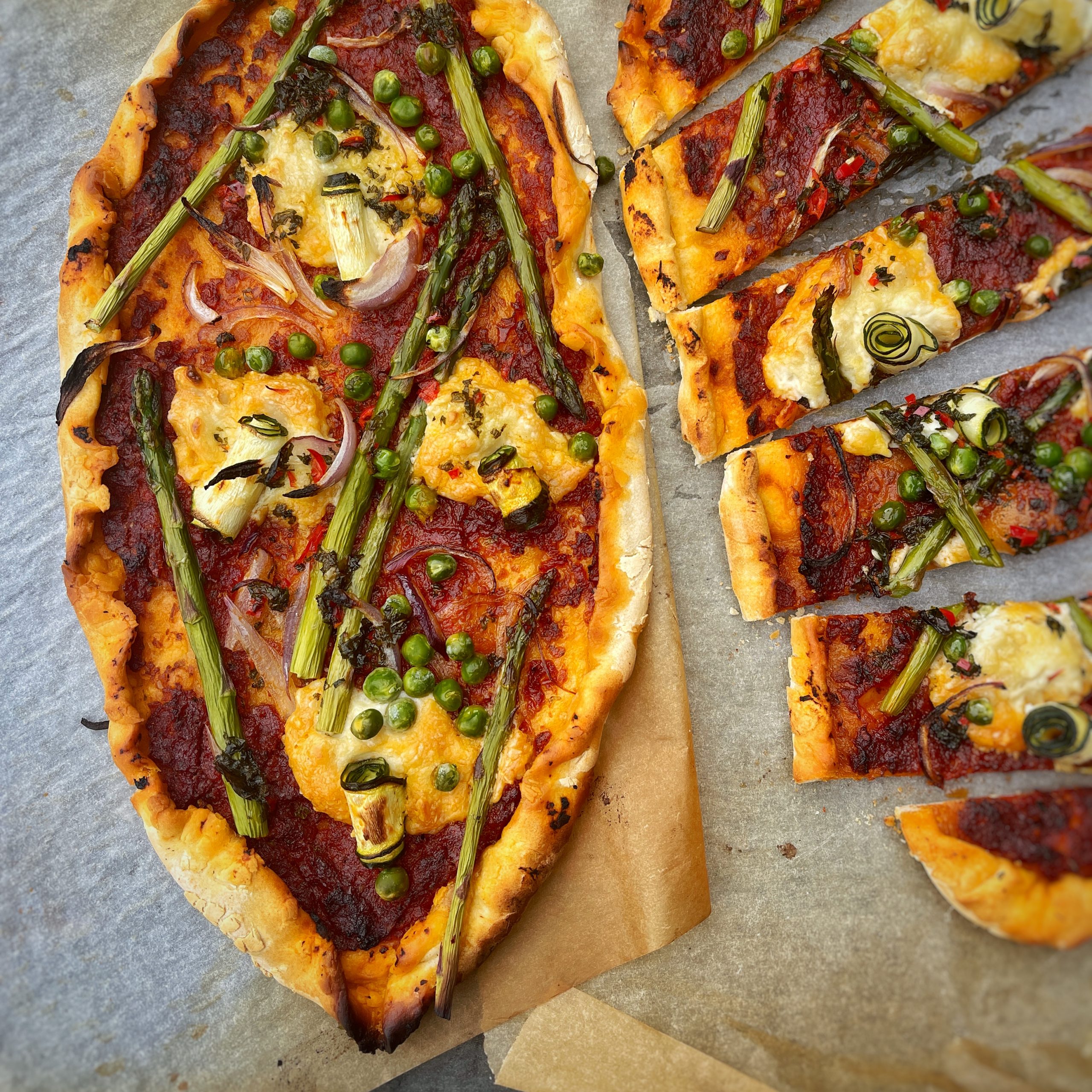
Quick Turkish pizza/ Pide with summer veg & feta
Takes 25 minutes
Serves 2
Ingredients
- Dough;
- 250 g self raising flour
- Small pinch salt
- 125 ml water
- Base;
- 4 tbsp Pesto of choice – we used our Happy Pear Sun-Dried Tomato pesto
- 4 tbsp Tomato puree
- Toppings;
- Quick fire cashew feta;
- 100 g cashew nuts
- 3 tbsp lemon juice juice of 1 small lemon
- 4 tbsp non dairy milk
- Good Pinch of salt and black pepper
- 100 g Asparagus
- 1 small Courgette -150g
- 50 g Peas
- Mint & chilli oil;
- 12 g mint
- 1 small fresh chilli
- 8 tbsp Olive oil
- Pinch of salt
Instructions
- Method;
- Preheat oven to 250 C Fan assisted
- Boil the cashews for 10 mins. Drain and rinse well and set aside.
- While the cashews are boiling make your dough; into a mixing bowl add the flour and water along with a small pinch of salt. Mix the flour, water and the salt together in a bowl and bring together to a rough dough. Transfer it to a lightly floured surface and knead for 5-10 minutes until it forms a nice smooth elastic dough, smooth to the touch. You could alternatively use a stand mixer with a dough hook for 4-5 minutes.
- Peel the courgette into long thin ribbons using a wide peeler ; approx 16 – 20 slices. Leave asparagus whole, trimming stalk so they are about 10cm
- Mix the pesto and tomato paste together
- To make the cashew feta; add the cashews to a high speed blender along with the milk, lemon juice and ⅓ tsp of salt and blend till smooth, remove and set aside. rinse the blender, then make the mint and chili oil.
- Divide the dough into 2 balls. Roll each dough into approx 30 x 20cm oval shape and transfer to two lightly oiled baking trays.
- To assemble the pide;
- Spread approx 4 Tbsp or half of the pesto tomato mixture over each dough, leaving 3cm uncovered all the way around.
- Add 4-5 tsp of feta dotted over the pesto.
- Toss the asparagus and courgette ribbons in 1 tbsp of oil and pinch of salt. Roll up 2 ribbons of courgette each,into little swirls.
- Add the courgette rolls and asparagus over the feta covering the pesto and feta, keeping the asparagus lined up at an angle, making a nice pattern.
- Fold back the uncovered dough all the way around, making a canoe shape, leaving the filling mostly uncovered. Pinch the pastry at both ends to keep it sealed during baking. Bake for 10 -12 mins until the dough is nice and golden. Rotate the trays once during cooking so it cooks evenly.
- Serve with your favourite summer salad. Enjoy!
Video
This is to show that super tasty dinners can be quick and easy to make, this is an easier version of a korma recipe a wonderful Indian chef, Santana who worked with us used to make. The first time we made this in the studio we all ended up eating it for a second breakfast! Serve with your favourite grain of choice.
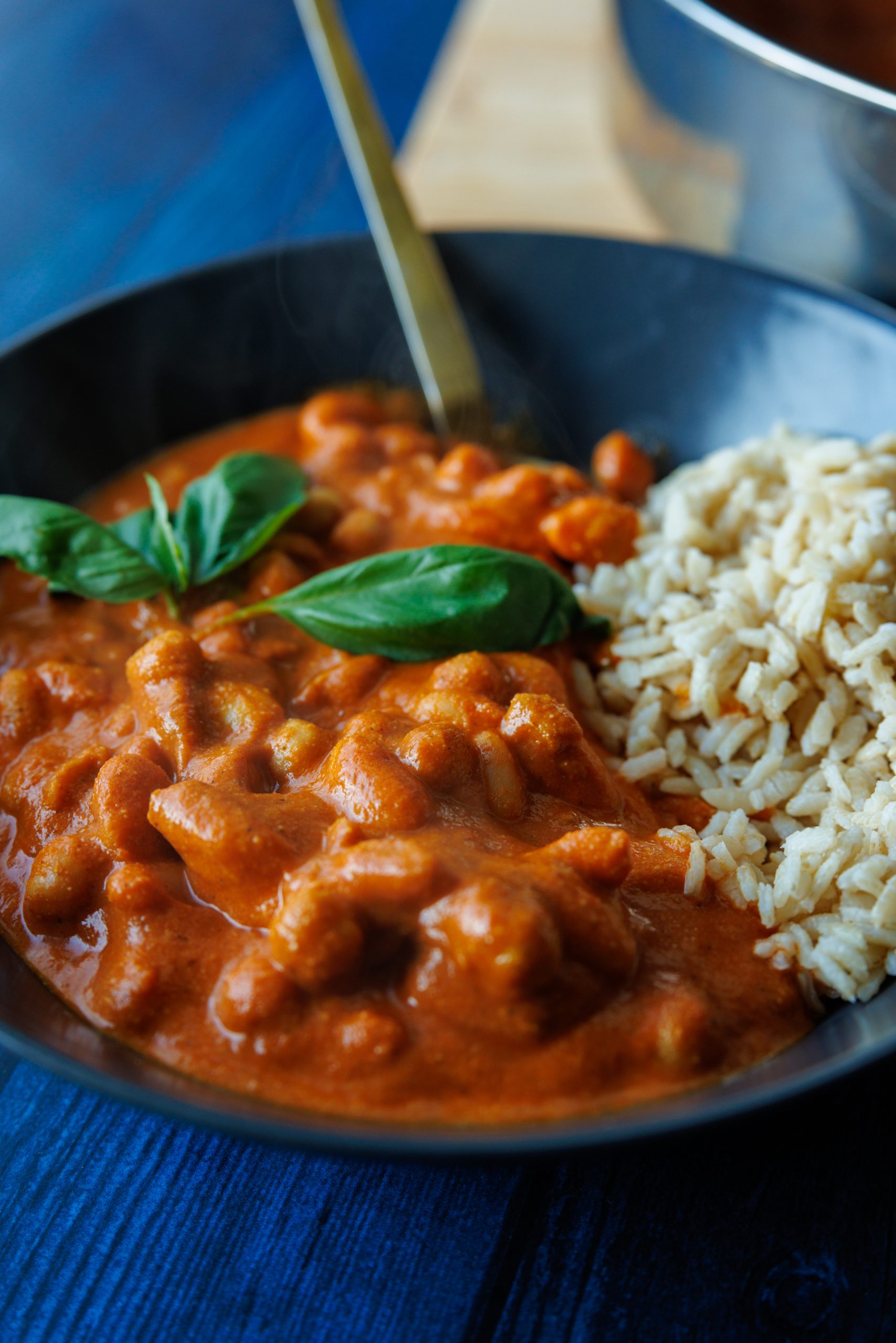
5 mins creamy korma
Takes 3 minutes
Serves 4
Ingredients
- 400 g chickpeas
- 400 g butter beans
- 200 g mushrooms (we love Oyster mushrooms)
- 2 tbsp tamari
- 2 cloves garlic
- thumbsized piece of ginger
- 50 g cashew nuts
- 400 ml coconut milk
- 400 g chopped tomatoes
- 150 g roasted red peppers from a jar, drained
- 2 tbsp curry powder
- 1 tbsp garam masala
- 1 tsp salt and pepper
Instructions
- Heat a non-stick pan on high heat. As it heats up, roughly chop the mushrooms, and finely dice the ginger.Drain and rinse the chickpeas and butterbeans.
- Add 1 tbsp of oil to the pan along with the chopped mushrooms and ginger and leave to fry.Into the blender jug add the garlic, chopped tomatoes, coconut milk, cashew nuts, roasted red pepper, curry powder, garam masala, salt and blend till super smooth.
- Give it the time to get a super smooth sauce.Stir the mushrooms and add the tamari/ soy sauce and mix well so that each mushroom is well infused with the umami flavour.
- Add the drained chickpeas and butter beans along with the sauce and mix well.Taste and adjust the seasoning to your liking by adding some salt, ground black pepper or lime juice.
- Serve with some quick cooked brown rice and some chopped coriander or basil for a delicious quick dinner.
Nutrition
Video
The Happy Pear Podcast
This week we bring you, New York Times bestselling author and internationally recognized professional speaker on a number of important public health issues, Dr Michael Greger, M.D. FACLM.
Episode 101
He wrote the book on How Not To Die & also How Not To Diet! A legend in the nutirtion world, Dr. Greger and his team set up Nutritionfacts.org, a science-based nonprofit organisation. That provides free updates on the latest in nutrition research via bite-sized videos. A strictly non-commercial public service health charity.
Dr. Greger has lectured at the Conference on World Affairs, the National Institutes of Health, and the International Bird Flu Summit, among countless other symposia and institutions; testified before Congress; has appeared on shows such as The Colbert Report; and was invited as an expert witness in defense of Oprah Winfrey at the infamous “meat defamation” trial. In 2017, he was honored with the American College of Lifestyle Medicine with its Lifestyle Medicine Trailblazer Award.
In this episode we debunk the myths around diet culture, and break down how to sustain a healthy weight and lifestyle.
Enjoy!
Lots of Love,
Dave & Steve x
Available now from all good podcast providers:
This episode is sponsored by Vivobarefoot Footwear. Vivobarefoot Footwear have given our listeners an exclusive 15% discount when you enter the code HAPPYPEAR15
Genuinely these are the only shoes you will see Dave & Steve wearing!
Produced by Sean Cahill and Sara Fawsitt
The Happy Pear Podcast
To mark 100 episodes of chatting to experts, trailblazers, doctors, entrepreneurs, celebrities, and psychologists we thought we would do something different.
Episode 100
We (Dave & Steve) and our two producers, Sara & Sean, get together and chat through our highlights, lowlights and learnings from speaking to such extraordinary people and experts in their field.
We hope you enjoy the episode and getting to know a little better the people behind The Happy Pear Podcast.
Enjoy!
Lots of Love,
Dave & Steve x
Available now from all good podcast providers:
This episode was sponsored by Wolfgangreforest.ie – how about going GREEN this Christmas by giving the gift of a tree instead of possessions people probably don’t need! With Wolfgang re-forest.
Produced by Sean Cahill and Sara Fawsitt
This make the most wonderful celebration dinner and the red currant jus is phenomenal and so worth the effort!
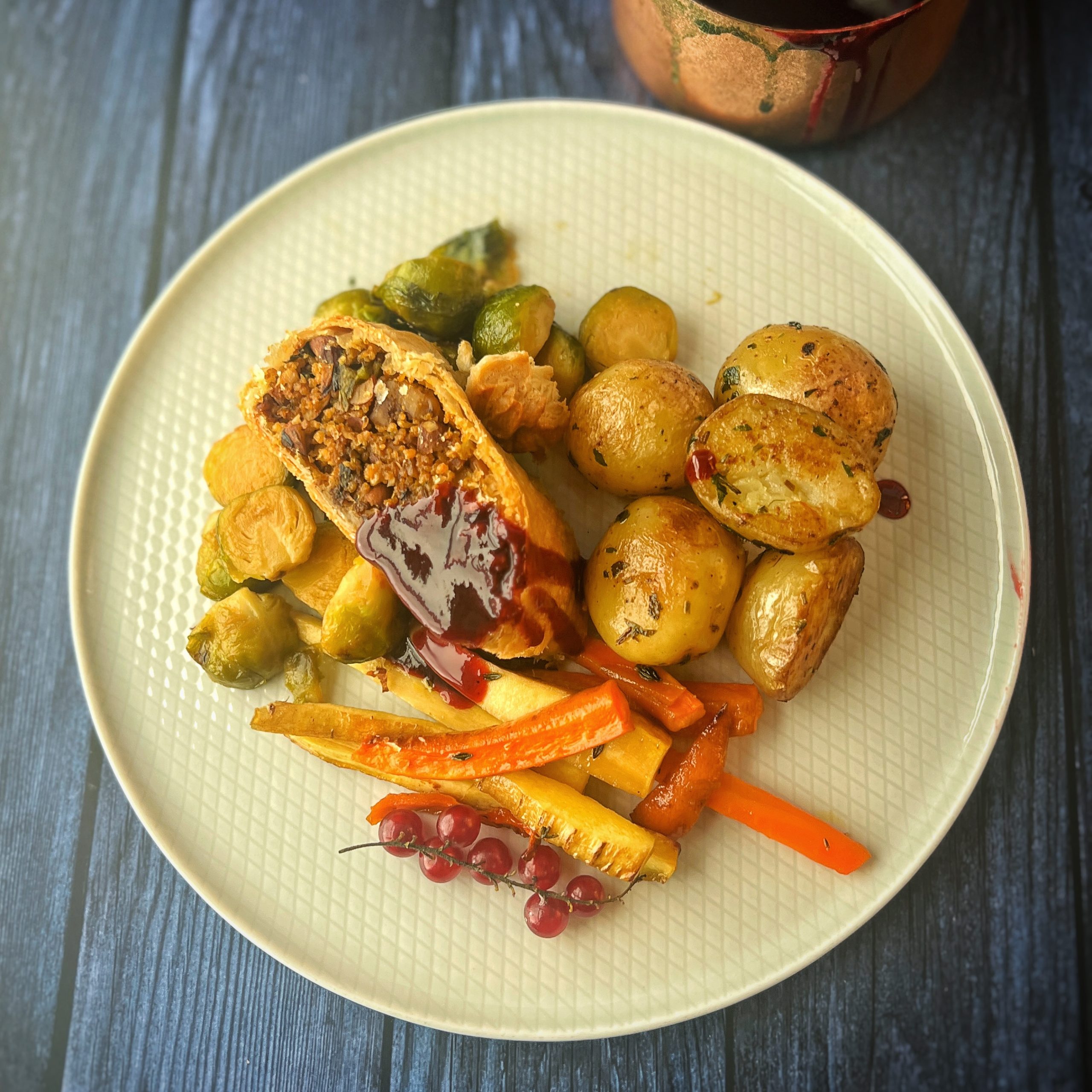
Christmas mushroom and pumpkin Wellington with red currant jus
Takes 1 hour
Serves 6
Ingredients
- 200 g almonds
- 2 tbsp tamari
- 2 tbsp maple syrup
- 1 leek or 3 small leeks/ 1 red onion
- 2 cloves garlic
- 200 g mushrooms ideally oyster
- 200 g pumpkin/ squash
- 200 g cooked chestnuts
- 150 g cooked couscous or quinoa or grain of choice buy a pack of precooked grain to save time (approx 75g of couscous dried gives 150g when cooked)
- 3 tbsp tamari
- 10 sprigs of fresh thyme
- 10 medium leaves of fresh sage
- 1 tsp salt
- ½ tsp black pepper
- 2 sheets of puff pastry 2x320g
- 2 tbsp of oat milk or plant milk of choice
- Red currant jus
- 100 g of fresh Red currants
- 4 tbsp of maple syrup
- 200 g of red wine
- 1 tbsp balsamic vinegar
- 500 ml veg stock
Instructions
- Preheat the oven to 200 degrees c
- Roughly chop the almonds or pulse in the food processor or put in a zip lock bag and bash with the bottom of a mug until coarse and put on a baking tray and coat with 2 tbsp of tamari and 2 tbsp of maple syrup, roast in the preheated oven for 10 mins.
- Slice the leek and give the green part a good wash as often sediment hides here, (if using onions peel and finely dice them) and peel and dice the garlic. Roughly slice the mushrooms, remove the sage leaves and thyme leaves from their stalks, finely chop the sage leaves and set aside.
- Grate the flesh of the pumpkin or squash (discard the skin or keep for a stock)
- Roughly chop the cooked chestnuts
- Place a large non-stick pan on high heat. Once warm add 1 tbsp of oil and add the chopped leek and fry for 3-4 mins stirring occasionally, add the garlic and mushrooms and grated squash/pumpkin and pinch of salt- cook for 7-10 mins stirring regularly.
- Add the cooked chestnuts and tamari, the thyme and sage leaves, and salt and black pepper and cook for a further 3-4 mins. Remove from the heat and add the cooked couscous and almonds and mix through. Make sure to taste and adjust the season to your liking.
- To roll the wellington:
- Roll out one of the sheets of puff pastry, keeping it on the parchment paper and carefully add half the filling into the centre of the pastry lengthwise,leaving ⅓ at either side empty and leaving approx 3-4 cm at either end to wrap. Using either your clean hands or 2 spoons compact the filling so that it is firm and holds its shape firmly. This is very important so that once the wellington is cooked it holds its shape. Wash your hands and fold the pastry over on one side and fold the other side over ensuring to cut off any excess pastry so that it cooks fully. Imagine you are wrapping a present however you have to be careful as the more you handle the pastry the softer and harder to work with it gets. Once the wellington is wrapped, carefully roll it over so that the seam is at the bottom. Lift the parchment paper with the wellington and place on a baking tray. You can cut decorations with any leftover pastry cuts. Gently score the pastry in a criss cross pattern and place any pastry decorations on top. Brush with some oat milk or plant milk of choice to help it golden in the oven.
- Baking in the oven for 30-45 mins until nicely golden all over.
- While the wellington is in the oven let’s make the red currant jus.
- Put a medium saucepan on high heat and add in all the ingredients, bring to a boil and using a whisk try to break down the red currants so they release their pectin which will help thicken the sauce as it reduces. Leave to reduce until it reaches a thick sauce and reduces by about ⅔’s. This should take about 20 mins – you can simply stir it occasionally.
- NOTE: if you can’t find fresh red currants, simply leave out the red currants and the maple syrup and replace with 2 tbsp of red currant jelly and repeat the process.
- Remove the wellington from the oven when it is golden brown. Easiest way to slice is to use a serrated knife. Each willington should give 6 slices. Serve with the red currant jus, and some roasted potatoes, brussel sprouts and cranberry sauce – enjoy!
Video
These make a wonderful edible gift and great last minute present which everyone likes! Literally takes 10 mins and they can look very professional! If you have a nice box and a ribbon, it can really make them look like a fancy homemade gift!
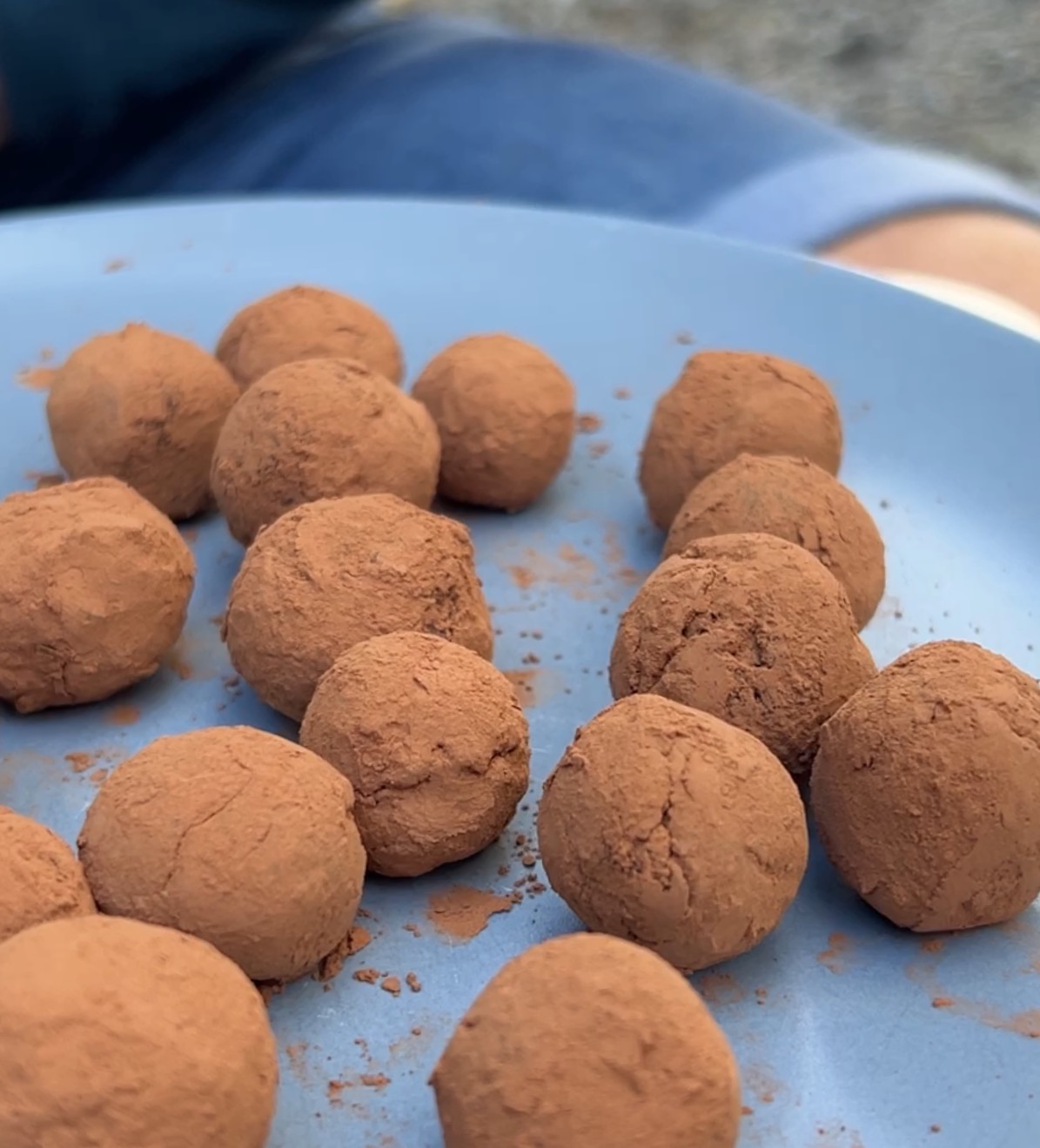
Ganache Chocolate Truffles
Takes 20 minutes
Serves 15
Ingredients
- 100 g dark chocolate
- 100 g cream plant based or coconut cream
- 1 orange zest
For Decoration
- Pistachios
- Freeze-dried raspberries
- Desiccated coconut
- Cacao powder
Instructions
- Break up the dark chocolate into small pieces and place them in a bowl.
- In a saucepan, add the cream and the orange zest, being careful to avoid the white pith, which can be bitter. Heat on medium until it reaches a gentle boil.
- Pour the heated cream over the chocolate and leave it for 2 minutes. Then stir until the mixture is well combined and richly chocolatey.
- Chill the mixture in the fridge for about 20 minutes, or until it’s firm enough to roll.
- Roll the chilled mixture into small balls, handling them as little as possible to prevent them from melting. Return the balls to the fridge to harden while you prepare the toppings.
- Peel and finely chop the pistachios. Place the chopped pistachios, desiccated coconut, cacao powder, and freeze-dried raspberries into separate bowls.
- Roll the hardened truffles in the prepared toppings for a decorative and varied finish.
- Package your truffles in a small box or clear bag, add a label, and they're ready to enjoy!
Nutrition
This is an indulgent sandwich guaranteed to please! It takes about 15 mins to make and is so worth it!
If you can oyster mushrooms are our favourite and if you compress them with a clean pan it encourages more evaporation and browning for a total flavour bomb of a sandwich!
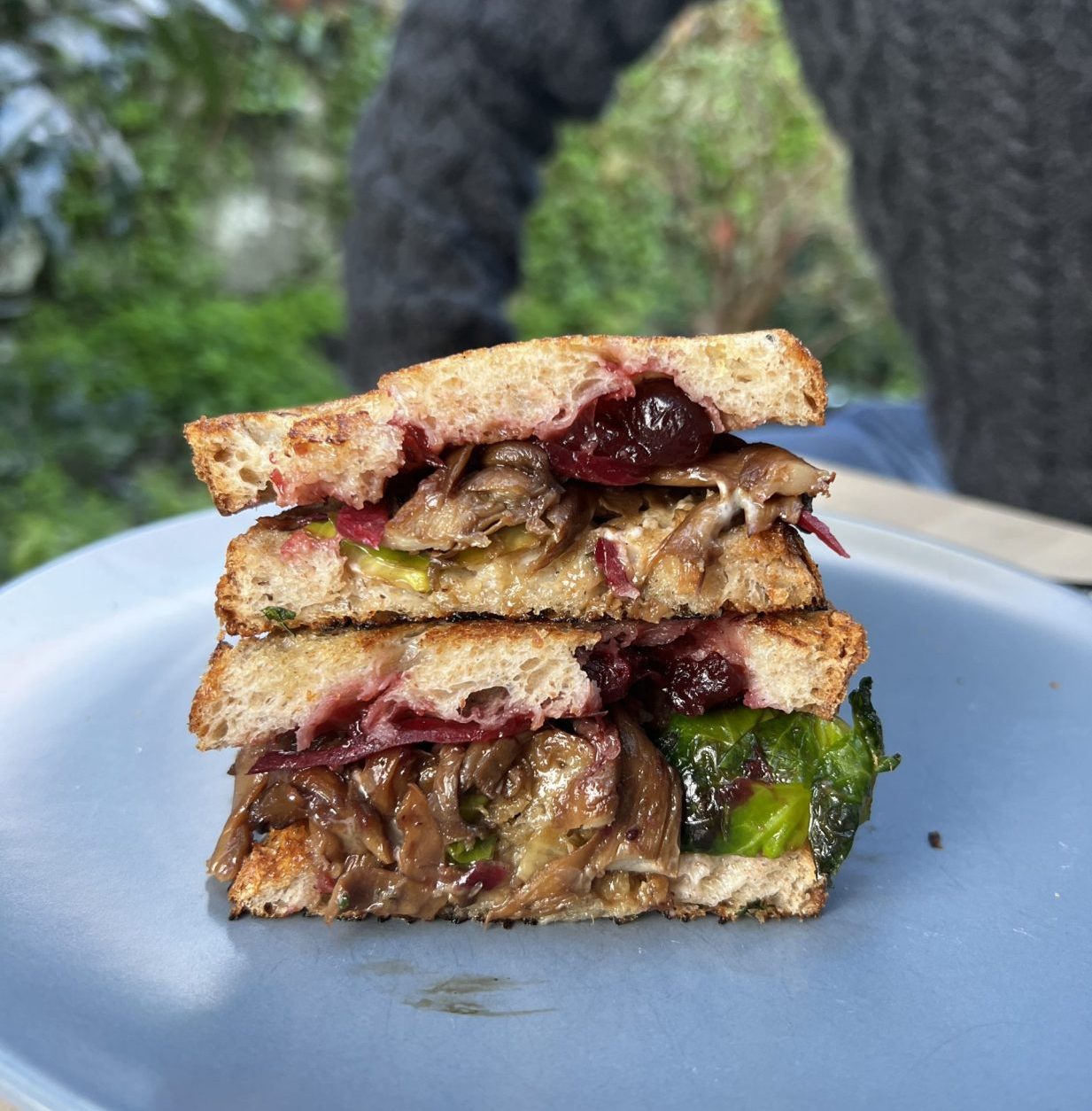
Epic Christmas Sandwich
Takes 12 minutes
Serves 2
Ingredients
- 100 g brussel sprouts
- 150 g Oyster mushrooms
- 4 tbsp gravy
- 2 tbsp tamari
- 1 tbsp oil
- 3 tbsp vegan mayo
- 3 tbsp cranberry sauce
- 100 g sauerkraut
- 100 g stuffing
- 4 slices bread
- 30 g plant-based butter
Instructions
- Wash and quarter the brussel sprout and put in a sauce pan with salted water and boil for 10 mins.
- Heat a non-stick frying pan on high heat and rip the mushrooms into thin strips. Once the pan is hot add 1/2 tbsp of oil and cook the mushrooms for 5 mins. Using a clean smaller pan, compress the mushrooms to encourage more evaporation and browning – this will result in more flavour. Turn the mushrooms until they are brown on both sides, add in the gravy and tamari and ensure each mushroom is popping with flavour. Remove the mushrooms. Drain and rinse the brussel sprouts and put the frying pan back on high heat. Add ½ tbsp of oil, once hot and add the brussel sprouts and fry until they start to brown on both sides, to add more flavour. Remove and set aside.
- Layout the 4 slices of bread, spread mayo on 2 sides and cranberry sauce on the other sides. Divide the brussel sprouts between the 2 sandwiches ensuring there is a thin layer. Layer on the stuffing, followed by the mushrooms, and top with the sauerkraut.
- Put the top on the sandwich and butter the outside layer of the top of the sandwich with a thin layer of plant based butter. Heat the frying pan on medium heat and put the butter side down on the pan and fry for 2-3 mins until golden. Butter the top side of the sandwich and turn and repeat until both sides are perfectly golden!Slice and enjoy!
Nutrition
The Happy Pear Podcast
Can diabetes both type 1 and type 2 be reversed by food and lifestyle choices?
Episode 99 – Mastering Diabetes
This week we speak to Cyrus Khambatta, PhD, and Robby Barbaro, MPH the co-authors of the New York Times bestselling book Mastering Diabetes and the cofounders of Mastering Diabetes, a coaching program that teaches people how to reverse insulin resistance via low-fat, plant-based, whole-food nutrition.
Cyrus has been living with type 1 diabetes since 2002, and has an undergraduate degree from Stanford University and a PhD in Nutritional Biochemistry from UC Berkeley. Robby was diagnosed with type 1 diabetes in 2000, and has been living a plant-based lifestyle since 2006. He worked at Forks Over Knives for 6 years, and earned a Master’s in Public Health in 2019.
A brilliant episode that will leave you stocking up on your fruit!
Enjoy!
Lots of Love,
Dave & Steve x
Available now from all good podcast providers:
This episode was sponsored byWolfgangreforest.ie – how about going GREEN this Christmas by giving the gift of a tree instead of possessions people probably don’t need! With Wolfgang re-forest.
Produced by Sean Cahill and Sara Fawsitt
This might sound like a crazy idea, but trust us, this is a wonderful way to use any leftover Christmas veg. We make an easy nacho cheese based on root veg and layer on Christmas veg to create an epic quesadilla. It started as a bit of a joke, but once everyone tasted it, we all adored it, and we even filmed a video on how to make it!
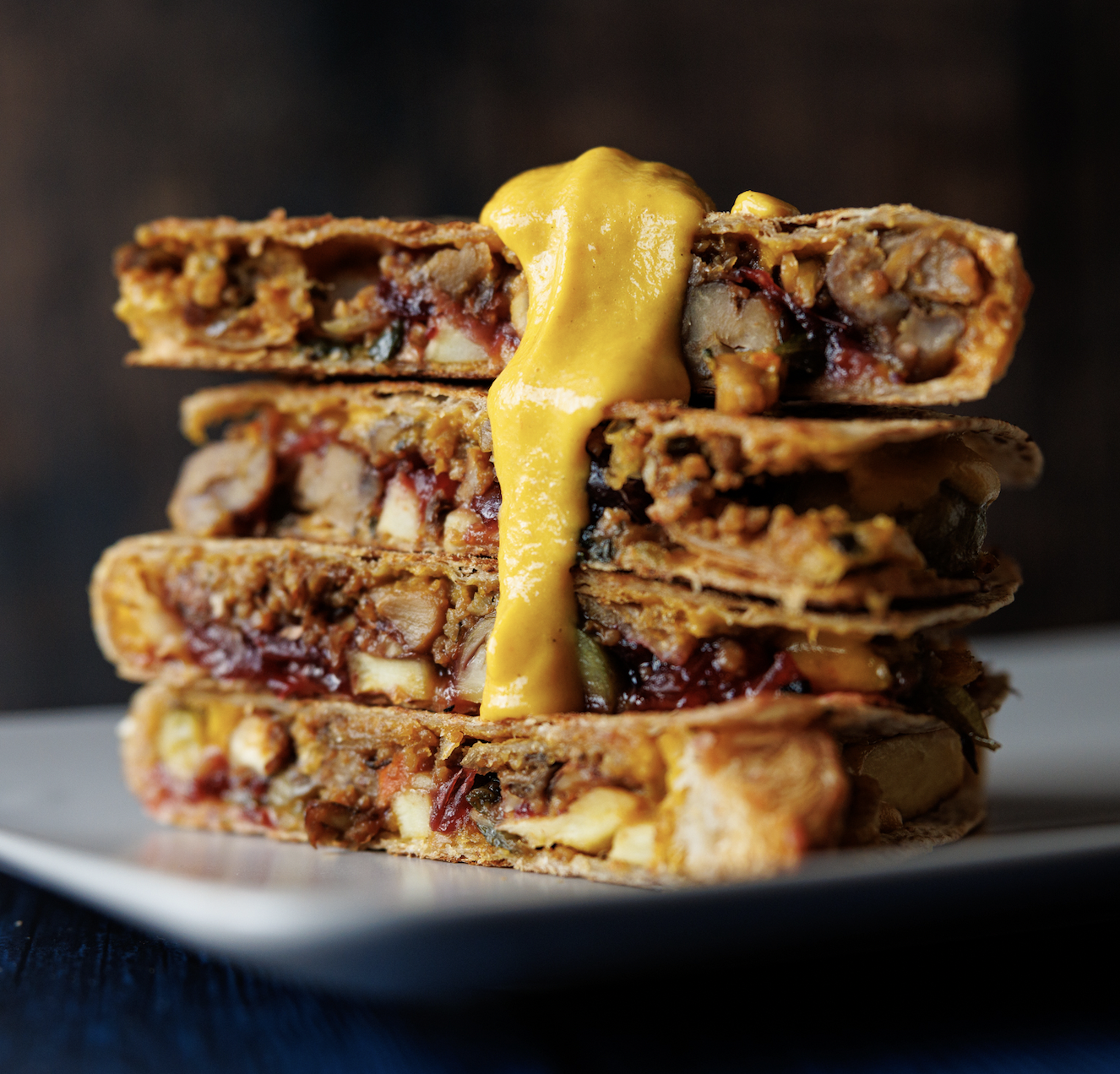
Christmas Quesadilla
Takes 12 minutes
Serves 1
Ingredients
Nacho cheese
- 140 g roasted veg such as parsnips and carrots (perfect for the nacho cheese colour)
- 60 ml vegetable oil
- 60 ml oat milk
- 1 tbsp garlic powder
- 3/4 tsp salt
- 1/2 tsp ground black pepper
Fillings
- 200 g stuffing
- 100 g cranberry sauce
- 400 g leftover veg
- 4 tortilla wraps
Instructions
- Into a blender, add all the ingredients for the cheese and blend until super smooth. Taste and adjust the seasoning to your liking.
- If the mixture is too thick, add more plant milk or water until you achieve a lovely texture. If it’s too thin, add a little more root veg and blend until smooth. Make sure to season to your liking.
- Heat a non-stick pan over medium heat. Add a tortilla and spread a generous amount of the cheese across the entire surface.
- Layer the Christmas veg, stuffing, and cranberry sauce on top of the cheese. Fold the tortilla over and ensure both sides are browned and crispy.
- Transfer to a chopping board, cut in half, and enjoy!
Nutrition
Video
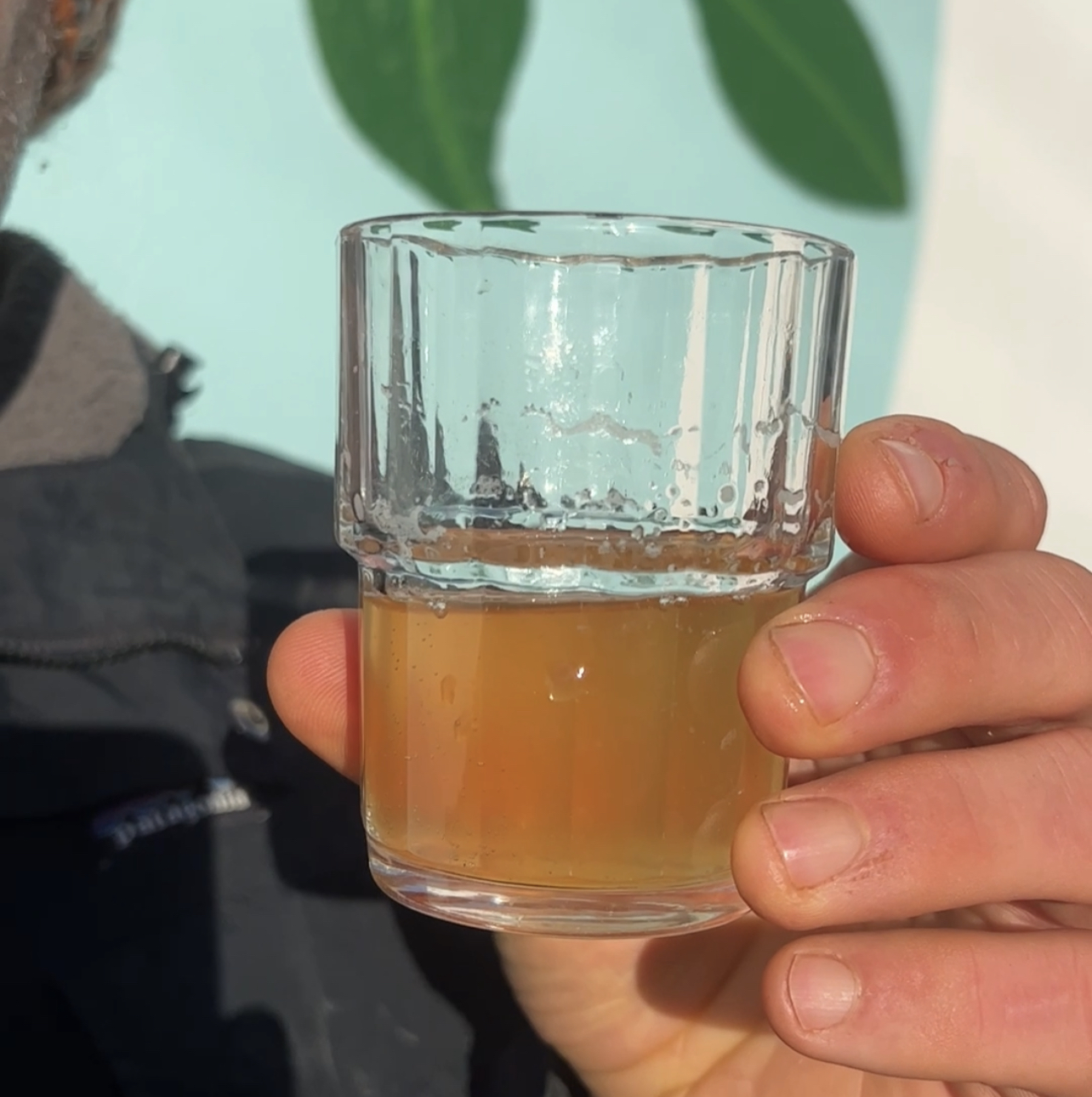
Kombucha
Takes
Serves 1
Ingredients
- 60 g white cane sugar
- 2 teabags (we love rooibos or green tea)
- 1 scoby
- 180 g kombucha (previously brewed or store-bought)
- 1 litre water
Instructions
- Pour 1 litre of water into a kettle and boil. Once boiled, add your teabags of choice along with the sugar.
- Stir until the sugar dissolves and the teabags infuse their flavour—this should take about 5 minutes. Remove the teabags and discard them.
- Leave the tea to cool, ensuring it’s below 37°C (body temperature). If it’s hotter, it could kill the scoby.
- Add the scoby and the previously brewed kombucha into a jar. Cover with a clean tea towel and leave to ferment for 10-15 days, away from direct sunlight, at room temperature.
- After 10-15 days, remove the scoby, and your kombucha is ready to drink!
Notes
Kombucha Q&A
How long should I ferment kombucha?
Ideally, if your SCOBY is healthy and the room temperature is around 20°C, it should take about 10-14 days. However, if the temperature is hotter, it will take less time, and if colder, it will take longer. Additionally, if your SCOBY is small, it will also take longer. The easiest way to tell if your kombucha is ready is by checking if it’s naturally bubbly and not too sweet when you taste it (this indicates that the SCOBY has consumed the sugar and converted it into probiotic bacteria and carbon dioxide, better known as bubbles!). Taste the kombucha, and once it’s to your liking and bubbly, it’s ready to go! The longer you ferment it, the more acidic or vinegar-like it becomes. We’ve often left it to ferment for over a month, resulting in a lovely vinegar to use in salads!What is the best container for fermenting kombucha?
Ideally, use glass jars, but if you can’t find any, plastic works fine (preferably BPA-free). Avoid using metal containers and cutlery, as they can damage the SCOBY.Where can I get a SCOBY?
You can easily buy a SCOBY online for very little cost. A better option, however, is to get one from a friend who brews their own kombucha, as each time you brew a batch, the SCOBY grows and can be divided and shared. This means that if you continue making your own kombucha, you’ll have an extra SCOBY after each fermentation that you can share with others!How do I grow a SCOBY from scratch?
It’s easy, but it takes a little more time. Start with a store-bought bottle of kombucha (500ml) that is unpasteurized and labeled as “living” or “raw” (pasteurisation kills the bacteria needed to grow a SCOBY).- Boil the kettle and brew a small cup of tea with 2 tbsp of sugar, ensuring that you use the same tea type as in the store-bought kombucha (usually black, green, or rooibos). Let the tea cool to below 37°C (body temperature).
- Add the cooled sweet tea to the bottle of ready-made kombucha. This provides extra food for the yeast and bacteria to grow a new culture.
- Pour the mixture into a larger jar or glass bottle. Cover with a clean, dry cloth so air can reach it, but flies cannot.
- Ferment at room temperature, ideally around 20°C, out of direct sunlight for about 2-4 weeks, and a SCOBY should naturally develop.
Nutrition
The Happy Pear Podcast
“Walking is the only way proven to stave off cognitive decline – it works. Exercise, from a public health perspective, is an unmitigated failure. The world’s longest-lived people live in environments that nudge them into more movement.”
Episode 98 – Dan Buettner
We are huge fans! This is our second episode with the amazing Dan Buettner, who’s new book on the lost American diet, The Blue Zones American Diet, is out today.
Dan’s extensive research on the healthiest and happiest living people on the planet is fascinating, we have personally taken a lot from it and if you are familiar with any of our online health and lifestyle courses (available on our app, Healthy Living) you will hear us quote him a lot!
Dan is an explorer, National Geographic Fellow, award-winning journalist and producer, and New York Times bestselling author. He discovered the five places in the world – dubbed blue zones hotspots – where people live the longest, healthiest lives. His articles about these places in The New York Times Magazine and National Geographic are two of the most popular for both publications.
Buettner now works in partnership with municipal governments, large employers, and health insurance companies to implement Blue Zones Projects in communities, workplaces, and universities. Blue Zones Projects are well-being initiatives that apply lessons from the Blue Zones to entire communities by focusing on changes to the local environment, public policy, and social networks. The program has dramatically improved the health of more than 5 million Americans to date.
His books, The Blue Zones: Lessons for Living Longer from the People Who’ve Lived the Longest, Thrive: Finding Happiness the Blue Zones Way, The Blue Zones Solution: Eating and Living Like the World’s Healthiest People, and The Blue Zones of Happiness were all national bestsellers. His new book The Blue Zones Kitchen: 100 recipes for living to 100 is a New York Times Best Seller and fuses scientific reporting, National Geographic photography and 100 recipes that may help you live to 100.
Buettner has appeared on The Today Show, Oprah, NBC Nightly News, and Good Morning America, and has keynoted speeches at TEDMED, Bill Clinton’s Health Matters Initiative, and Google Zeitgeist. His speech in January 2018 at the World Economic Forum in Davos was chosen as “one of the best of Davos.”
Another brilliant episode! Enjoy!
Lots of Love,
Dave & Steve x
Available now from all good podcast providers:
To find out more about Dan and his work, check out: https://www.bluezones.com/
This episode is sponsored by Vivobarefoot Footwear. Vivobarefoot Footwear has given our listeners an exclusive 20% discount when you enter the code HAPPYPEAR20 – Genuinely these are the only shoes you will see Dave & Steve wearing!
Produced by Sean Cahill and Sara Fawsitt

€1 Pasta Bake
Takes 42 minutes
Serves 6
Ingredients
- 500 g wholemeal penne
- 400 g tin chopped tomatoes
- 1 courgette
- 2 red onions
- 1 red pepper
- 2 carrots
Simple Cashew Cream
- 100 g cashew nuts
- 400 ml water
- tsp vinegar
- 1 garlic clove
Instructions
- Preheat the oven to 190°C. Boil the kettle and pour the boiled water over the cashews, ensuring they are fully submerged. Leave them to soak for 10 minutes.
- Prepare the vegetables:Fill a large saucepan with water, add a good pinch of salt, and bring it to a boil. Meanwhile, peel and slice the onions into long strips. Slice the pepper, courgette, and carrots into small bite-sized pieces. Cut the top off the head of garlic.
- Roast the vegetables:Divide the vegetables between two baking trays, toss with 2 tablespoons of oil and a pinch of salt, and roast for 25 minutes at 190°C.
- Cook the pasta:Add the wholemeal pasta to the boiling water in the saucepan and cook according to the package instructions.
- Make the cashew cream:While the pasta is cooking, drain and rinse the soaked cashews. Add them to a blender or food processor along with the remaining cashew cream ingredients (water and vinegar) and blend until smooth.
- Prepare the sauce:Drain and rinse the cooked pasta, then set it aside. Remove the roasted vegetables from the oven. Squeeze the baked garlic cloves out of their skins and add them to the cashew cream along with the tin of chopped tomatoes, 1 tsp of salt, and a pinch of black pepper. Blend until smooth.
- Assemble and bake:Add the roasted vegetables to the cooked pasta and mix them together with the sauce. Transfer the mixture to a baking dish and bake in the oven for a further 10 minutes.
- Serve:Serve the pasta bake with bread and salad for a delicious lunch, dinner, or even breakfast!
Nutrition
Video
The Happy Pear Podcast
When you speak to Manchán you feel that magic is real!
Episode 97 – Manchán Magan
Manchán Magan is a writer and documentary-maker. He writes for The Irish Times on culture & travel, presents the RTÉ podcast The Almanac of Ireland, and is author of the award-winning, best-selling Thirty-Two Words For Field, and Tree Dogs, Banshees Fingers and other Irish Words for Nature. He has made dozens of documentaries on issues of world culture for TG4, RTÉ & Travel Channel.
His recently published book, Listen to the Land Speak, was the main topic of our conversation, although we found ourselves diving into all sorts of weird and wonderful topics, from magic, the lost female voice to philosophy and how language is shaped by the land.
A true Irish gem, Manchán lives in an oak wood, with bees and hens, in a grass-roofed house near Lough Lene, Co Westmeath.
We hope you enjoyed this episode as much as we did, it is always a pleasure when we can do them in person.
Lots of Love,
Dave & Steve x
Available now from all good podcast providers:
To find out more about Manchán and his work visit: www.manchan.com
This episode was sponsored by wolfgangreforest.ie – how about going GREEN this Christmas by giving the gift of a tree instead of possessions people probably don’t need! With Wolfgang re-forest.
Produced by Sean Cahill and Sara Fawsitt
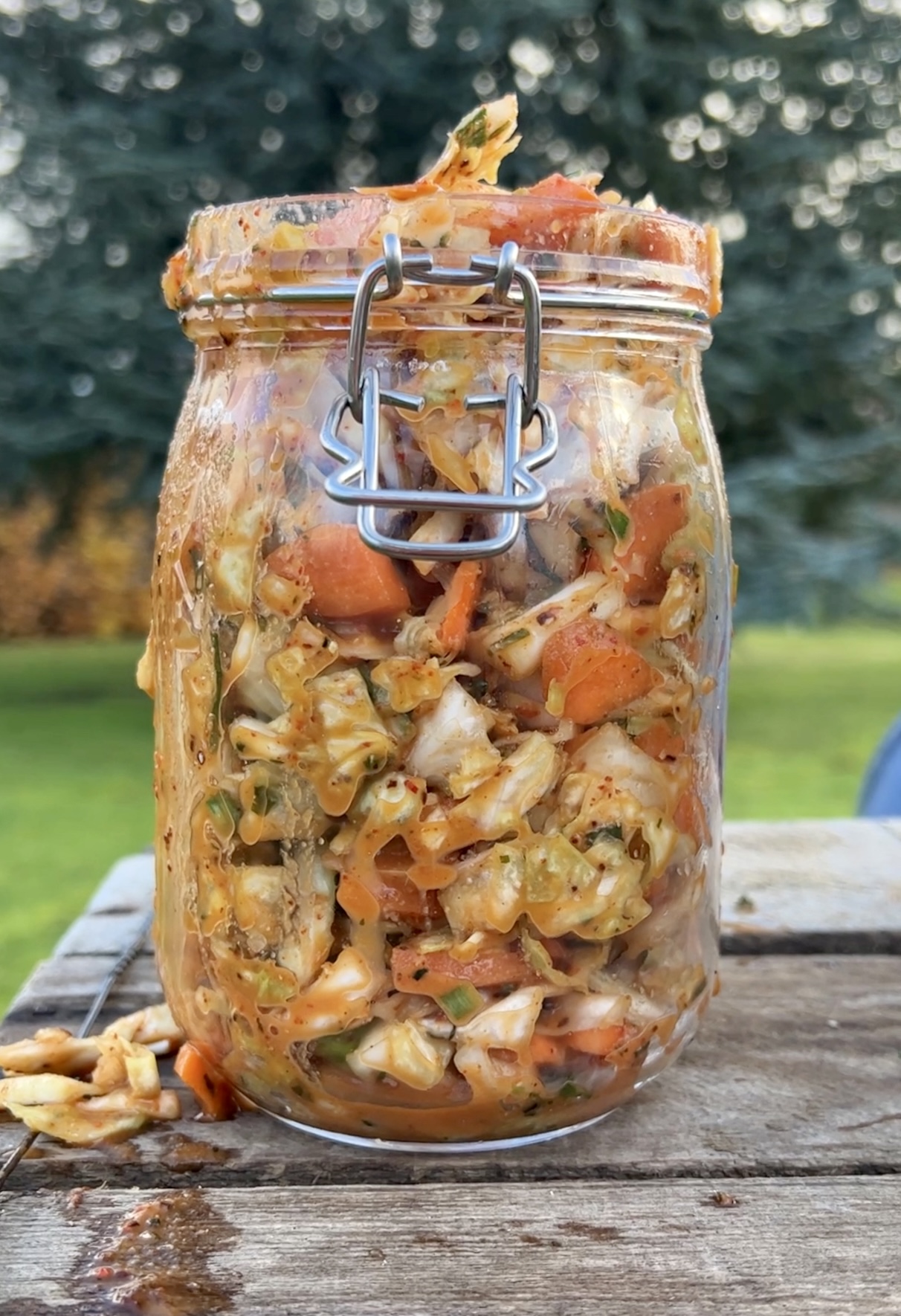
Easy Kimchi
Takes 10 minutes
Serves 1
Ingredients
- 1 kg mixed veg (such as carrot, pak choi, Chinese cabbage, radish, leek, beet)
- 20 g salt
Sauce
- 4 tbsp tamari
- 1 tsp maple syrup
- 25 g rice flour
- 200 ml water
- 5 cloves garlic
- 1/2 onion
- 1/2 tsp kelp powder
- 2.5 tbsp gochugaru (or 1 tbsp sweet paprika & 1.5 tbsp chilli powder/cayenne powder)
Instructions
- Prepare the veg: Roughly chop the vegetables into bite-sized pieces. Place them in a large bowl or saucepan, add the salt, and mix well. Bash the veg with a saucer for about 2 minutes, then let it sit for 1-2 hours (or even overnight). Afterward, rinse the salt away and place the veg back in the bowl or saucepan.
- Make the sauce: Peel the garlic cloves. Combine all the sauce ingredients and blend until smooth.Pour the sauce over the salted vegetables, then add the gochugaru or paprika/chilli mix and mix everything thoroughly.
- Ferment: Transfer the veg mixture into a jar or fermentation vessel, ensuring the veg is fully submerged under the sauce and natural juices. This is crucial as it allows the lactic acid fermentation process to occur. Leave the kimchi to ferment on the counter for 2-3 days until it starts to bubble. Taste it; if you prefer it more acidic, leave it to ferment longer. The longer it ferments at room temperature, the more acidic it becomes. Once satisfied with the flavour, transfer it to the fridge, where it will keep for many months, even years!
Notes:
- Check your kimchi every few days to ensure the vegetables remain submerged in the liquid. If the top layer is exposed to air and starts to spoil, simply scrape it off; the rest should be perfectly fine.
- Time and temperature are the secret ingredients for fermentation. The longer you let it ferment, the more intense and acidic the flavour becomes. Warmer temperatures will speed up the process.
Nutrition
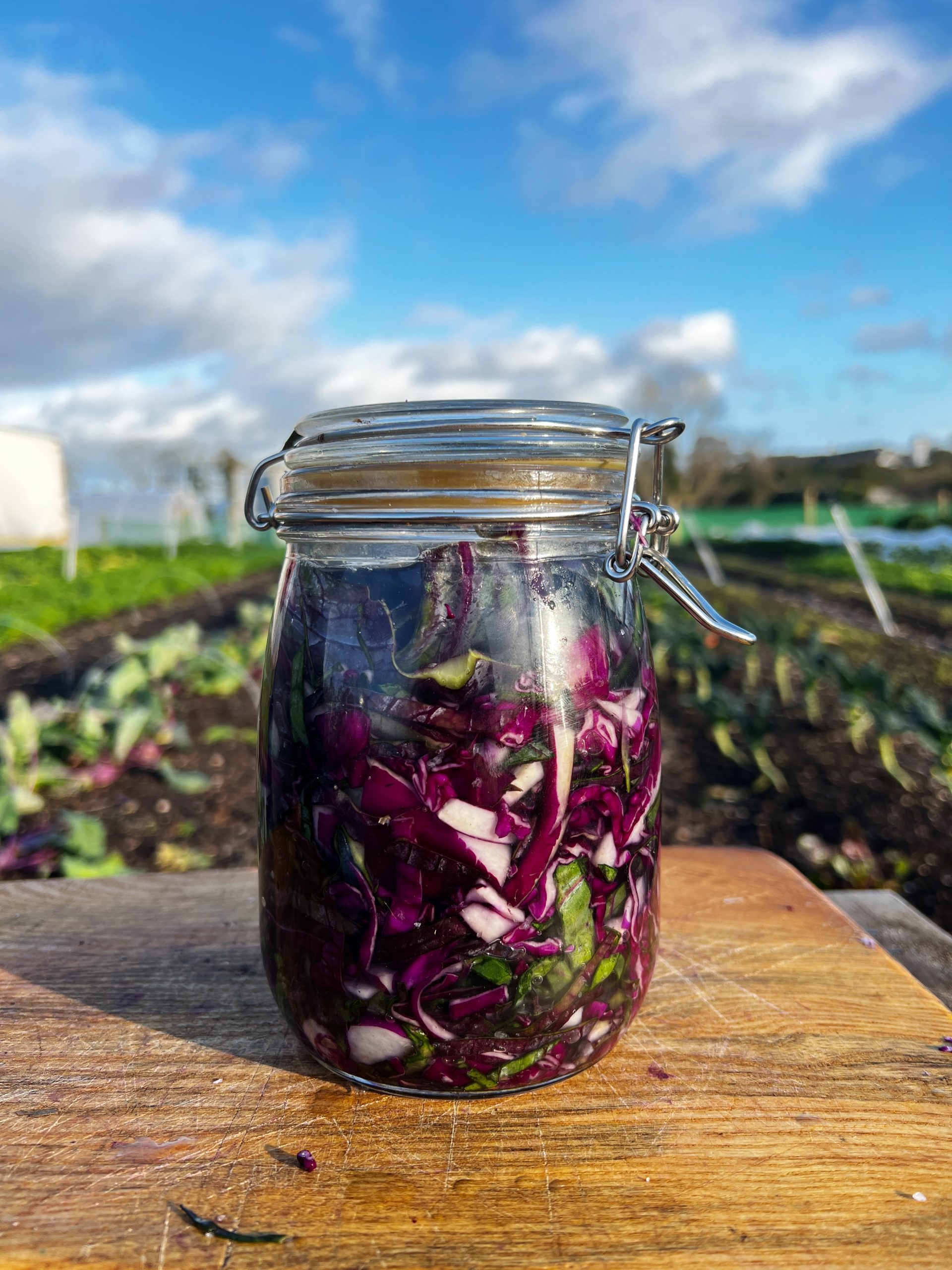
Sauerkraut
Takes 5 minutes
Serves 1
Ingredients
- 400 g Cabbage of your choice
- 8 g table salt
- 1 litre water
Instructions
- Remove the outer leaves of the cabbage if they appear wilted or sad, but save them—they’ll be used later to help keep your ferment submerged in liquid, which is very important.
- Slice and chop the cabbage as finely as possible, into bite-sized pieces. Weigh the cabbage to apply the 2% salt rule. For 400g of cabbage, you’ll need 8g of salt.
- Transfer the chopped cabbage and salt into a large bowl and massage thoroughly. The cabbage should begin releasing its liquid. You can also use the bottom of a mason jar to press down and help release more liquid.
- Carefully pack the salted cabbage into your jar, pressing it down firmly with your fingertips to ensure there’s some room left at the top. Pour water over the cabbage until it is just submerged. Use the reserved cabbage leaves to form a “plug” that keeps all the cabbage below the liquid. Some prefer to close the jar, but we recommend leaving it slightly open. Be sure to date your jar.
- Leave the sauerkraut to ferment for 3-5 days before tasting. Check every few days to ensure the cabbage stays submerged in the liquid. If the top layer, exposed to air, starts to spoil, simply scrape it off—the cabbage below should still be perfectly fine to eat.
Note:
- Time and temperature are key to fermentation. The longer it ferments, the stronger and more acidic the flavour. Warmer temperatures will speed up the fermentation process. Typically, sauerkraut is ready within 1-2 weeks at room temperature.
Nutrition
The Happy Pear Podcast
Our friend, Melissa Hemsley the self-taught chef, food columnist, best-selling cookbook author, real food activist and sustainability champion joined us this week for a chat!
Episode 96 – Melissa Hemsley
She is passionate about spreading the power of feel-good food, and has written five cookbooks including Eat Green, Eat Happy and her latest book Feel Good with 100 quick and easy recipes to bring a bit of comfort and joy into our kitchens and beyond.
We had a wonderful chat with Melissa, she is a great friend who has hosted us many times in her home in London. Having recently been diagnosed with ADHA and been under a long fertility journey, we dove deep into these topics alongside our love of food chats!
A brilliant episode – Enjoy!
Lots of Love,
Dave & Steve x
Available now from all good podcast providers:
To learn more about Melissa check out her site on: https://www.melissahemsley.com/
Produced by Sean Cahill and Sara Fawsitt
The idea of cooking biryani which is typically Indian feast food in 10 mins – might sound like a contradiction and an insult to an indian feast but this serves its purpose as quick easy dinner that is high in fibre, beans which are a good source of phyto-oestrogens which can be beneficial for balancing hormones as well as tasting delicious.
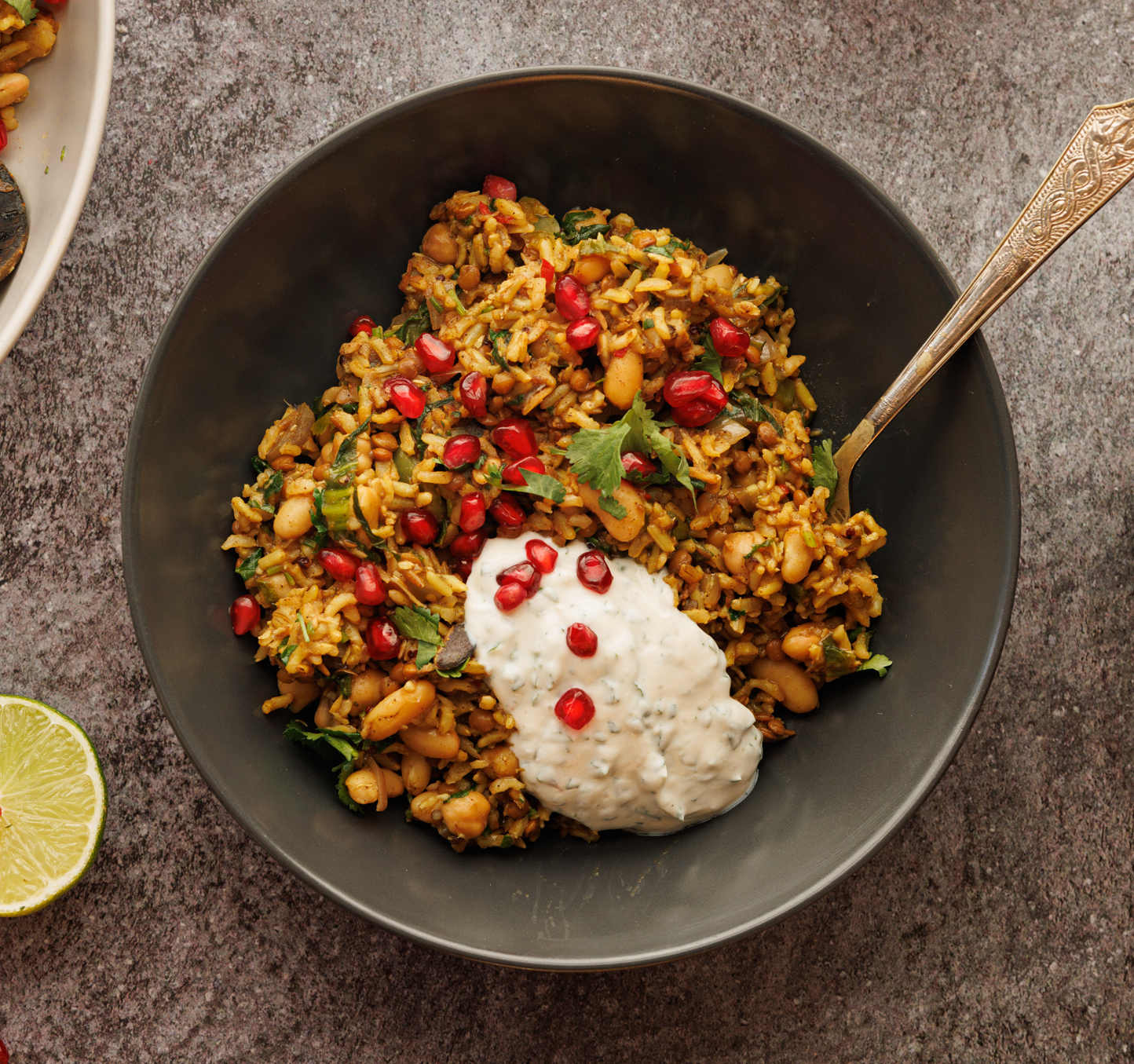
10 Minute Biryani
Takes 27 minutes
Serves 4
Ingredients
- 30 g Desiccated coconut
- 1 tbsp cumin seed
- 500 g precooked brown rice
- 400 g mixed beans
- 1 onion
- 1/2 red chilli
- 3 cloves of garlic
- 1/2 thumb sized ginger
- 1 pak choi
- 1 pomegranate
- 1/2 tbsp all spice
- 1 tbsp curry powder
- 500 ml vegetable stock
- 1/2 lime juice
- 3 tbsp tamari
- 15 g coriander
Lime Mint Riata
- 15 g fresh mint
- 500 g soy yoghurt
- 1/2 lime juiced
- 1 tbsp maple syrup
- 1/2 tsp salt
Instructions
- Peel and finely dice the onions, garlic and ginger, finely dice the chilli removing the seeds and white pit if you prefer it to be less spicy. Drain and rinse the beans.
- Heat a wide bottomed pan with a lid on high heat. Once hot add the desiccated coconut, cumin seeds, onion, garlic, ginger and chilli and fry, stirring regularly until the coconut starts to brown and smell like brown sugar. Add in the precooked rice along with half the veg stock and put a lid on it and allow it to steam for 2-3 mins
- Take the mint leaves off their stalk and finely chop, pour the yoghurt into a bowl and add the chopped mint, juice of ½ a lime, maple syrup, pinch of salt and mix through, taste and adjust the seasoning to your liking. Squeeze juice of half the like on top of the biriyani, taste and mix through, taste and adjust the seasoning to your liking.
- Squeeze juice of half the like on top of the biriyani, taste and mix through, taste and adjust the seasoning to your liking. Finely dice the fresh coriander and shook the pomegranate (remove the seeds from the pomegranate).
- Easiest way to do this is to stand the pomegranate with crown facing the sky, slice across the equator of the pomegranate or the middle, hold the half a pomegranate over a large bowl with the open side facing the bowl, get a wooden spoon and take your anger out and bang the seeds out. Repeat with the other half and remove any white pit as this can be quite bitter.)Decorate with the fresh coriander and the pomegranate seeds – serve with the mint raita
Nutrition
Video

Lemon Meringue Crunch
Takes 42 minutes
Serves 12
Ingredients
For the base:
- 400 g digestive biscuits
- 150 g vegan butter
For the lemon curd:
- Juice of 1 lemon
- Zest of 1 lemon
- 75 g vegan butter
- 300 ml oat milk
- 100 g caster sugar
- 1/8 tsp turmeric
- 3 tbsp white flour
For the meringue topping:
- 170 ml aquafaba (drained chickpea water, from 1 can)
- 120 g caster sugar
- ½ tsp cream of tartar
Instructions
- Prepare the base: Chop the vegan butter into small 2 cm cubes and add to a food processor along with the biscuits. Blend until the mixture comes together, and the biscuits have a breadcrumb-like texture. Line a baking tray approximately 30 cm x 15 cm x 4 cm with baking parchment.Pour the biscuit mixture into the lined tray and spread it out evenly, compressing it well to ensure it holds its shape once set. Place the tray in the fridge or freezer to set while you make the lemon curd.
- Make the lemon curd: Cut the vegan butter into small cubes and add it to a medium saucepan over medium heat. Once melted, add the oat milk and caster sugar, and stir until combined. Sift in the flour and bring the mixture to a gentle simmer, stirring continuously with a whisk. Add the lemon zest and lemon juice, and continue stirring until the curd thickens. Once the curd has reached a glossy consistency and is thick enough to stay on the whisk, remove it from the heat. Pour the curd over the biscuit base and return to the fridge to set while you make the meringue.
- Prepare the meringue: In a stand mixer, add the chickpea water (aquafaba) and whisk with a balloon whisk attachment at high speed until stiff peaks form (this should take about 5 minutes). Gradually add the caster sugar and cream of tartar, and whisk until the mixture becomes thick, stiff, and glossy.Transfer the meringue to a piping bag and pipe it over the lemon curd layer, creating thin, even points until the entire surface is covered.Using a blow torch, caramelise the tips of the meringue until golden and caramelised.Allow the dessert to cool for a few minutes before cutting and serving.
Nutrition
The Happy Pear Podcast
This week we had the pleasure of speaking to Joe De Sena!
Where to start? What a remarkable man! But would you want him as a partner? Or even a friend? Well not if you like lie-ins, tasty treats or taking it easy…
We like to think we are pretty good at facing discomfort with our daily sea swims and active lifestyle, but when Joe challenged us to join him on one of his death races, you can literally hear us squirming in our seats!
Episode 95 – Joe De Sena
Joe De Sena is the founder and CEO of Spartan, the world’s leading endurance sports brand. Growing up in working-class Queens, De Sena has demonstrated an entrepreneurial spirit since his preteens. He built a multimillion-dollar pool cleaning business before moving to Wall Street, where he started his own trading firm.
In 2001, De Sena fled Wall Street for Riverside Farm in rural Vermont. It was during this time that he discovered his passion for adventure races and endurance events, and Spartan Race was born.
De Sena has built Spartan into a global fitness and wellness brand, with a 10 million+ community of athletes across the globe. Under his leadership, Spartan’s portfolio of brands has grown to include Spartan Trail, DEKA, La Ruta, Tough Mudder, and HIGHLANDER.
A New York Times bestselling author, De Sena’s latest book, 10 Rules for Resilience: Mental Toughness for Families, hit bookstores last October.
A brilliant episode – Enjoy!
Lots of Love,
Dave & Steve x
Available now from all good podcast providers:
To learn more about Clint and Grounding check out: https://www.earthing.com/
This episode is sponsored by our friends from HEALF.com the amazing online platform for all yoru health needs!
Get an exclusive 20% off HEALF.com when you enter the promo code HEATHYPEAR
Healf is where you will find only the best of the best health brands all vetted by their community and validated by experts. We love this platform, you can’t go wrong and it has all our favourite stuff covering the 4 pillars of heath: Eat Move Mind Sleep
Produced by Sean Cahill and Sara Fawsitt
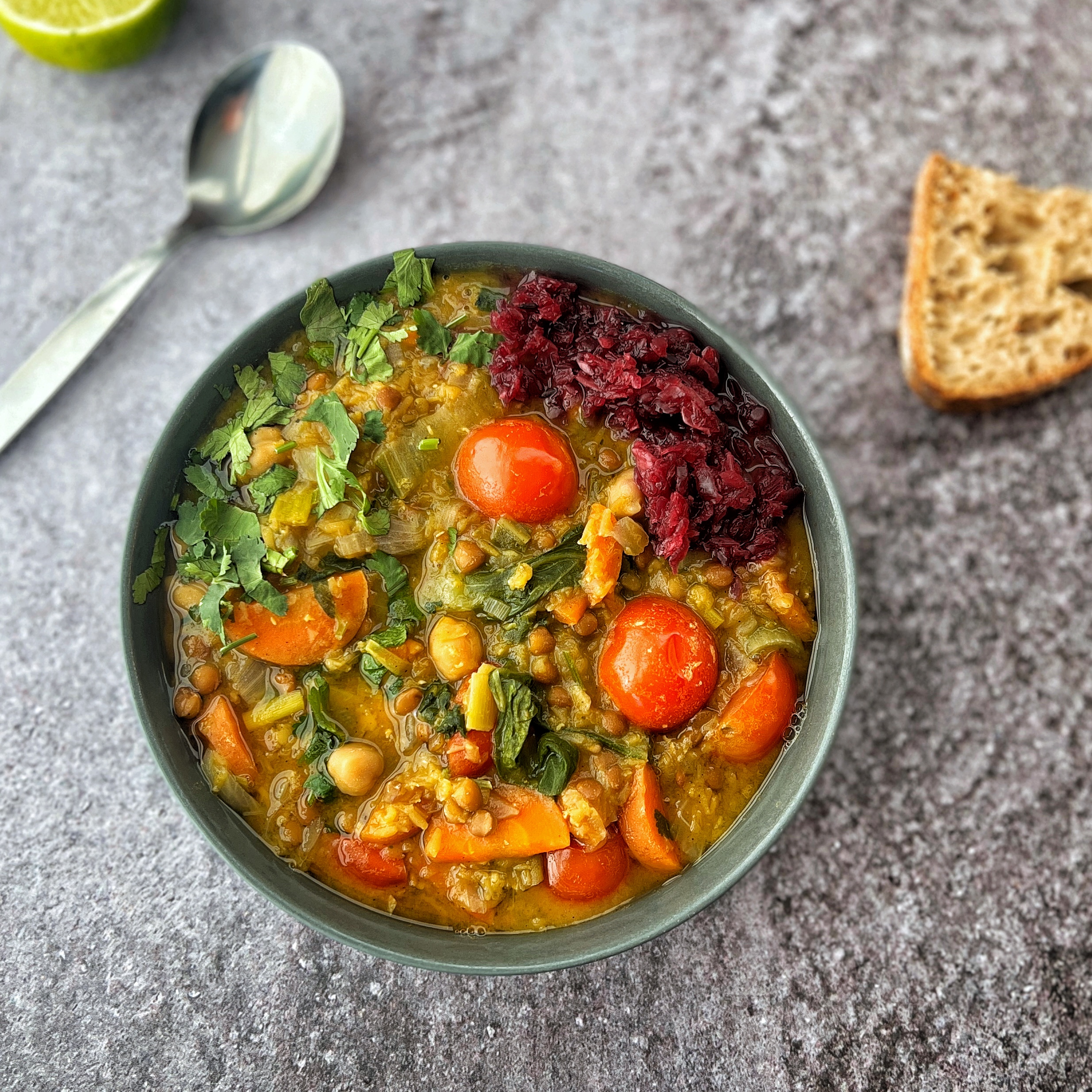
Hearty Lentil Stew
Takes 25 minutes
Serves 4
Ingredients
- 3 onions
- 4 cloves of garlic
- 4 carrots
- 1 leek
- 10 cherry tomatoes
- 500 g red lentils
- 2 pak choi
- 15 g coriander
- 1 litre veg stock
- 100 ml water
- 400 g chickpeas
- 400 g cooked lentils
- 3 tbsp tamari
- 2 tbsp curry powder
- 1 tsp salt
- 1 tsp black pepper
- 1 lime
Instructions
- Peel and finely chop the onions and garlic. Finely dice the carrots. Slice the leek lengthwise, rinse thoroughly to remove any sediment, then slice it into 2-cm rounds. Drain and rinse the chickpeas and lentils.
- Heat a 5-litre non-stick pot on high heat. Once hot, add the diced onions and cook until they start to brown around the edges, stirring occasionally.
- Add the garlic and diced carrots, along with a pinch of salt. Cook for 2-3 minutes, stirring occasionally.
- Add the chopped leek and 4 tbsp of water. Stir, cover with a lid, and let it sweat for 5 minutes. This will speed up the cooking process and help release the vegetables' sweetness.
- Remove the lid and add the split red lentils, vegetable stock, and 1 litre of water. Stir, cover, and cook for 20 minutes, stirring occasionally.
- While the lentils cook, halve the cherry tomatoes, finely slice the pak choi, and chop the fresh coriander or herb of choice.
- After 20 minutes, remove the lid and add the cooked chickpeas, lentils, tamari, curry powder, cherry tomatoes, pak choi, and fresh herbs. Squeeze the juice of half a lime into the pot and stir.
- Taste the stew and adjust the seasoning with more salt, pepper, or lime juice as needed.
- Bring the stew to a boil over high heat. Once done, remove from heat.
- Serve hot with your favourite grain or sourdough bread. The stew will keep for 2 days in the fridge and freezes well.
Nutrition
Video

Easy Indian Curry for Weight Loss
Takes 20 minutes
Serves
Ingredients
- 1 onion
- 2 cloves garlic
- 1- inch cube fresh ginger
- 400 ml veg stock
- 1 x 400ml tin chopped tomatoes
- 100 g baby spinach
- 2 x 400g tins chickpeas
- 1 cinnamon stick
- 1 tbsp cumin seeds
- 1 tbsp garam masala
- 1 tsp turmeric
- 1 tbsp tamari or soy sauce
- ½ tsp ground black pepper
- Juice of ½ lemon
- 1 red pepper
- 1 red chilli finely sliced for garnish (optional for extra heat)
- 2 tbsp gram flour or flour of choice
Instructions
- Peel and finely dice the onion, garlic, and ginger. Drain the tins of chickpeas and slice the red pepper, removing the seeds.
- Heat a wide-bottomed non-stick pan on high heat. Once hot, reduce to medium heat.
- Add the diced onion and ginger to the pan and fry for 2-3 minutes until they begin to brown. If they start to stick, add a couple of tablespoons of water to deglaze the pan.
- Add the cumin seeds, garlic, red pepper, and 1 tsp salt. Fry for another 2 minutes until the pepper softens.
- Add the turmeric, garam masala, cinnamon stick, and black pepper. Cook for 1 minute to toast the spices.
- Add the veg stock, tamari, and chopped tomatoes. Bring to a boil, then add the baby spinach, chickpeas and stir well.
- Sift in the gram flour and mix through.
- Garnish with finely sliced chilli and a squeeze of lemon juice.
- Serve with toasted pitta bread or your favourite grain.
Notes

Easy Indian Curry for Weight Loss
Takes 20 minutes
Serves
Ingredients
- 1 onion
- 2 cloves garlic
- 1- inch cube fresh ginger
- 400 ml veg stock
- 1 x 400ml tin chopped tomatoes
- 100 g baby spinach
- 2 x 400g tins chickpeas
- 1 cinnamon stick
- 1 tbsp cumin seeds
- 1 tbsp garam masala
- 1 tsp turmeric
- 1 tbsp tamari or soy sauce
- ½ tsp ground black pepper
- Juice of ½ lemon
- 1 red pepper
- 1 red chilli finely sliced for garnish (optional for extra heat)
- 2 tbsp gram flour or flour of choice
Instructions
- Peel and finely dice the onion, garlic, and ginger. Drain the tins of chickpeas and slice the red pepper, removing the seeds.
- Heat a wide-bottomed non-stick pan on high heat. Once hot, reduce to medium heat.
- Add the diced onion and ginger to the pan and fry for 2-3 minutes until they begin to brown. If they start to stick, add a couple of tablespoons of water to deglaze the pan.
- Add the cumin seeds, garlic, red pepper, and 1 tsp salt. Fry for another 2 minutes until the pepper softens.
- Add the turmeric, garam masala, cinnamon stick, and black pepper. Cook for 1 minute to toast the spices.
- Add the veg stock, tamari, and chopped tomatoes. Bring to a boil, then add the baby spinach, chickpeas and stir well.
- Sift in the gram flour and mix through.
- Garnish with finely sliced chilli and a squeeze of lemon juice.
- Serve with toasted pitta bread or your favourite grain.
Notes
menopause and perimenopause – Approximately 80% of what doctors and health professionals see in their clinics is related to lifestyle. When it comes to reducing the discomforts of menopause, there are changes you can make TODAY to make a difference. We’ve created a new course, HAPPY MENOPAUSE with the amazing Dr. Nitu Bajekal, Consultant Gynacologist who is full of amazing advice for women who are entering perimenopause or menopause. The course is also supported by Rohini Bajekal, Nutritionist who shares the information about what women should consume and what they should try and avoid, to reduce negative symptoms such as brain fog, hot flushes, sleep problems etc.
THE IMPORTANCE OF DIET…
A whole-food, plant-based diet means enjoying an abundance of colourful fruits and vegetables, legumes, whole grains, nuts, seeds, herbs and spices. These vibrant plant foods are full of hormone-regulating fibre, health promoting micronutrients, and antioxidants.
Centering your meals on plant foods offers both mental and physical benefits. When you focus on the healthy plant foods you’re adding to your plant, you don’t have to feel deprived. Focus on adding an abundance of colour to your plate and eat mindfully without the guilt.
Many experts believe that protein needs are higher as we age. Unfortunately, there’s a misconception that you cannot get enough protein without animal products. We’re here to dispel that myth. When eating a wide variety of protein-rich plant foods, such as legumes, you can meet all your protein requirements. This High Protein Bowl is a favourite of ours!
Replacing some grains in your diet with beans is one way to increase protein intake without increasing calories. Focusing on two to four servings of soy foods per day can be a great way to achieve higher protein intake during menopause. Plus, minimally processed soy products can be helpful in reducing the frequency and intensity of hot flushes. Win-win!

Things you should avoid…
- Ultra-processed foods
Avoiding or minimising foods without fibre can be helpful in improving menopause symptoms. These ultra-processed foods contain excess refined oils and animal foods filled with saturated fats, which can actually make hot flushes worse!
- Alcohol
Make water your drink of choice whenever possible. The chemical changes in your brain from alcohol can result in a loss of inhibition and may result in risk-taking behaviour or over indulgence. This can result in excess weight gain and worsening menopausal symptoms. Additionally, consumption of alcohol, especially beer, appears to be associated with an increased risk of developing fibroids.
- Cigarettes
Both alcohol and cigarette smoking are Class 1 carcinogens, which means they are known to cause cancer. In addition, there are a number of negative health outcomes, which only make existing menopausal symptoms worse. Cigarettes can impact your mood and sleep. Avoiding cigarette smoking can not only help alleviate menopausal symptoms, but it can also help in reducing your risk of cancer and heart disease.
- Caffeine
Not a surprise, but caffeine can greatly disrupt our sleep. As we’ve learned, sleep is vital for our health through menopause and beyond. Additionally, caffeine can irritate your bladder and make hot flushes worse. While we’re all for a brilliant cup of coffee, it’s important to reduce our intake if we notice symptoms worsening. A cup of decaffeinated tea or sparkling water with fresh berries and mint is the perfect, refreshing swap..
While big changes don’t always come easily, it’s important to recognise your progress and set smart and measurable goals rather than get overwhelmed. Incorporate more healthy choices into your life and make smart swaps to gain momentum and move yourself forward.
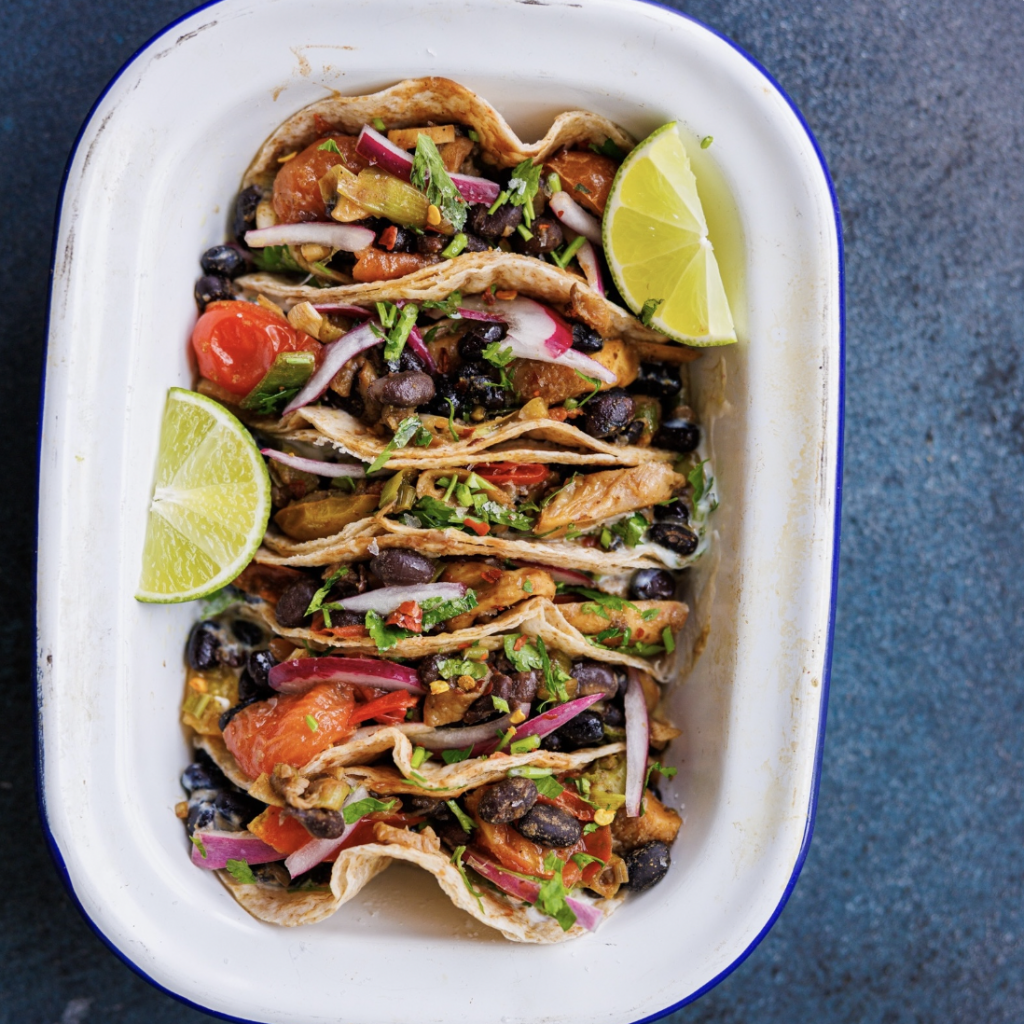
EASY VEGAN TACOS
Super tasty low fat, so perfect for those going through perimenopause and menopause. These are super easy vegan tacos that take 10 mins to make – packed with flavour… real crowd pleaser!
Total Time Needed: 10 Mins
Difficulty: Easy
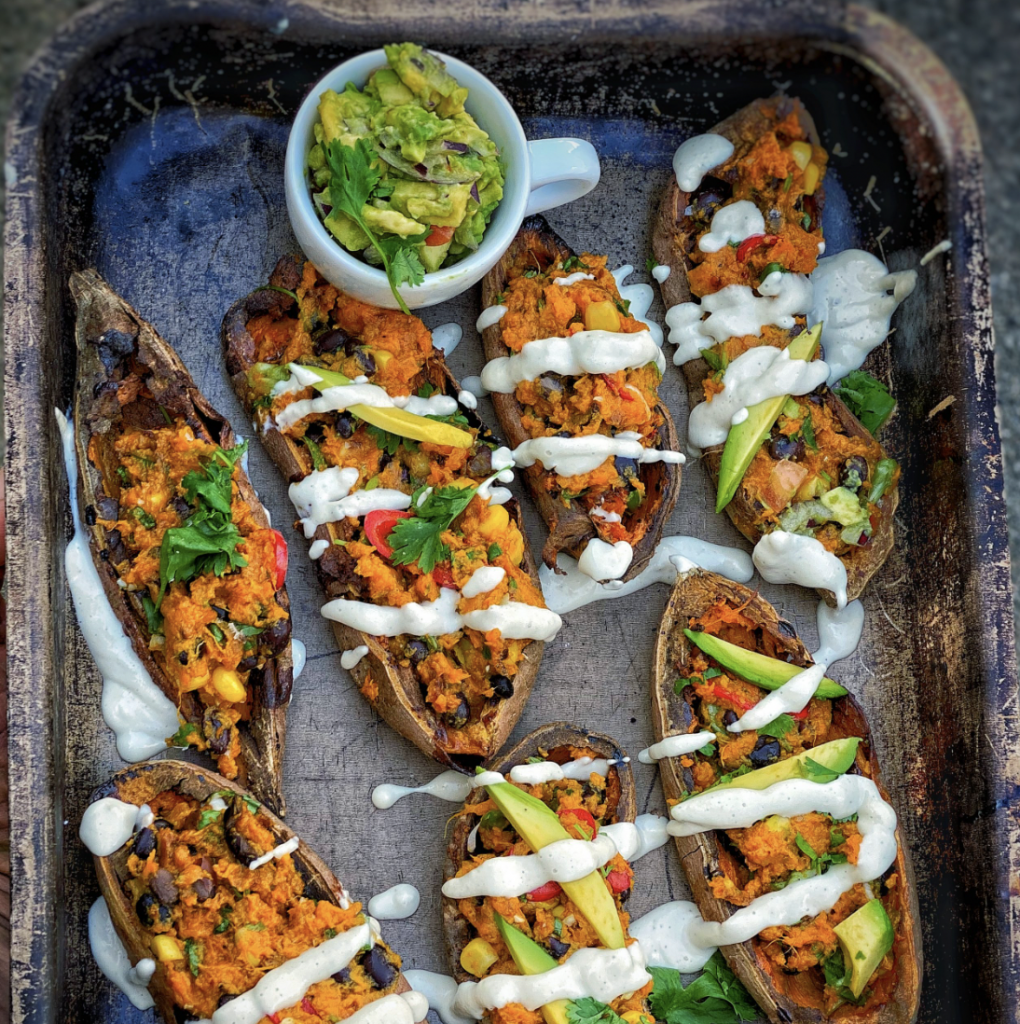
MEXICAN STUFFED SWEET POTATO SKINS
These are high in nutrition while being low in calories and super tasty. We have added a cashew cream to make them even more indulgent!
Total Time Needed: 40 Mins
Difficulty: Easy
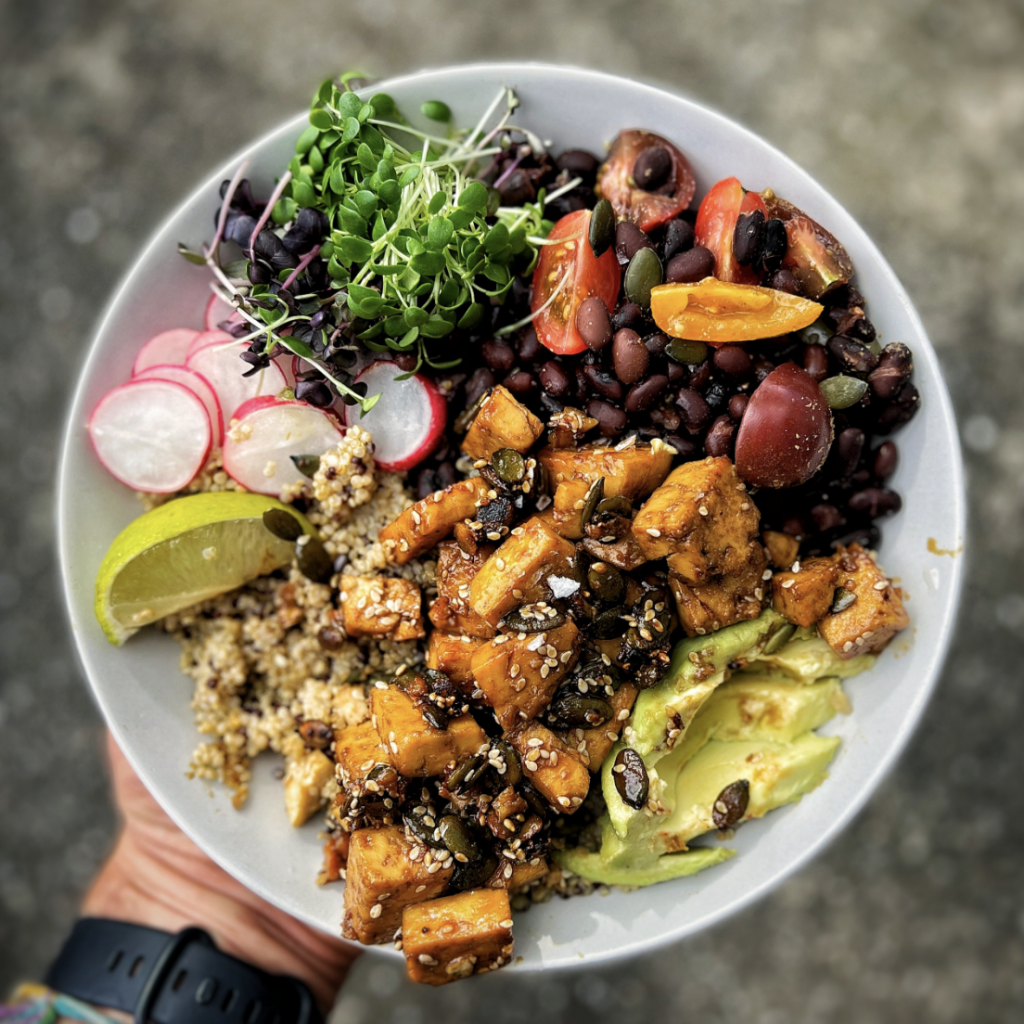
HIGH PROTEIN BOWL
A super tasty meal that is really quick to whip up with lots of fresh flavours, that also happens to be low in fat and high in protein. This meal is oil free so lower in calories and ideal for weight loss.
Total Time Needed: 5-10 Mins
Difficulty: Easy
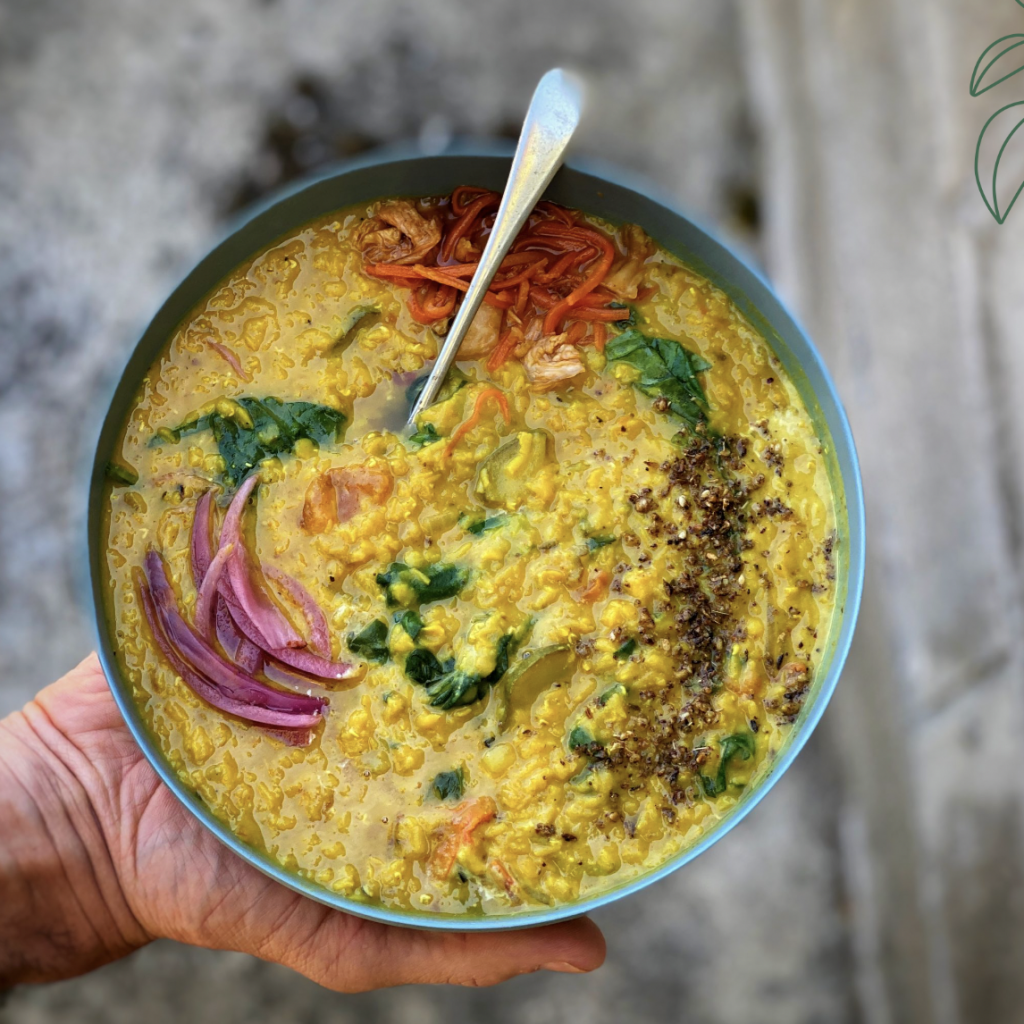
RED LENTIL DAHL
We love Dahl and have been cooking it at home and in our cafe for years! This red lentil Dahl is of our oldest and favourite recipes. Vegan, gluten free and made with no oil, so perfect for those who are experiencing menopause or even perimenopause. It’s so tasty and comforting. A great recipe for batch cooking too!
Total Time Needed: 40 Mins
Difficulty: Easy

EASY CHEESY ENCHILADAS
The root of the word enchiladas comes from the word enchilar which means to add chilli, here tortillas are filled with a delicious tomato and bean sauce, and baked in the oven and served with a rocking cashew cream – this is a family favourite in our house!
Total Time Needed: 15 Mins
Difficulty: Easy
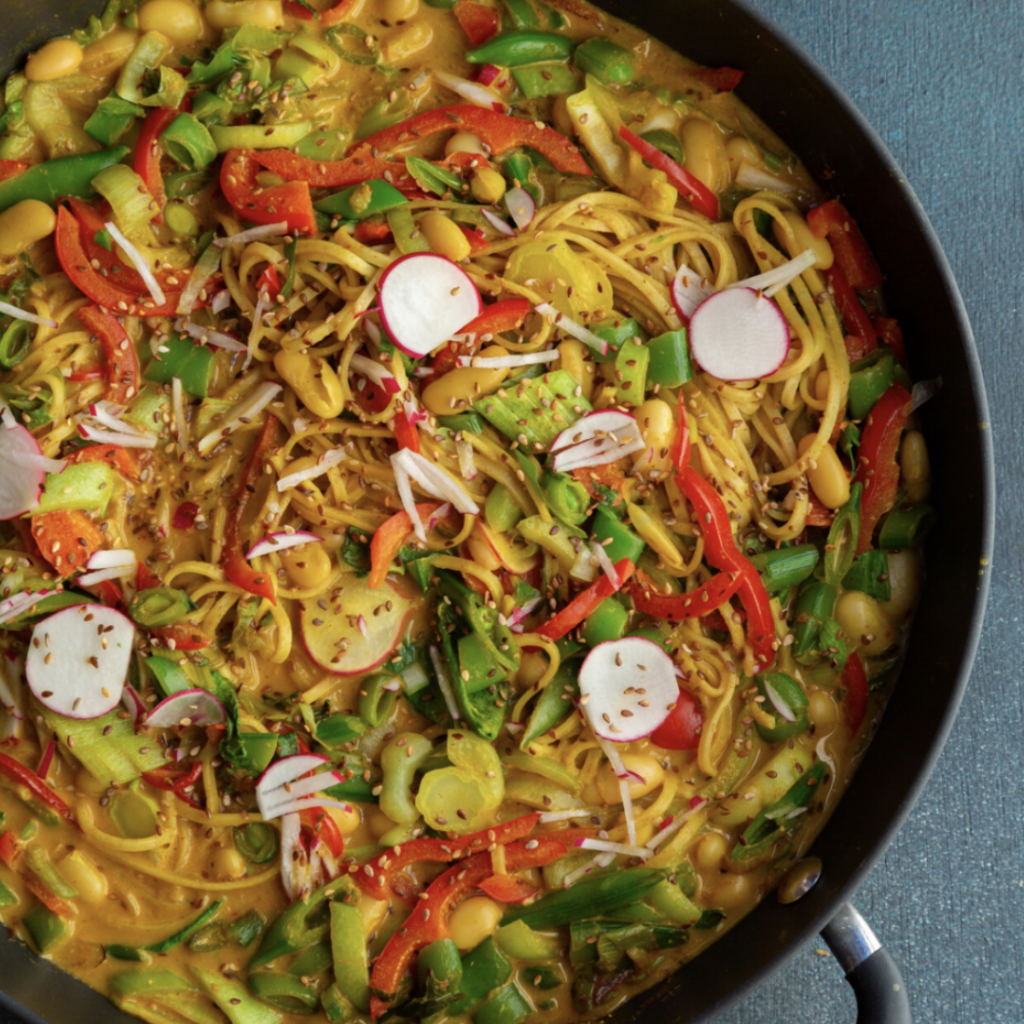
OIL FREE THAI YELLOW CURRY
Give this simple, easy Thai curry recipe a go. Being oil free it’s great for anyone going through menopause or perimenopause!
Total Time Needed: 15 Mins
Difficulty: Easy
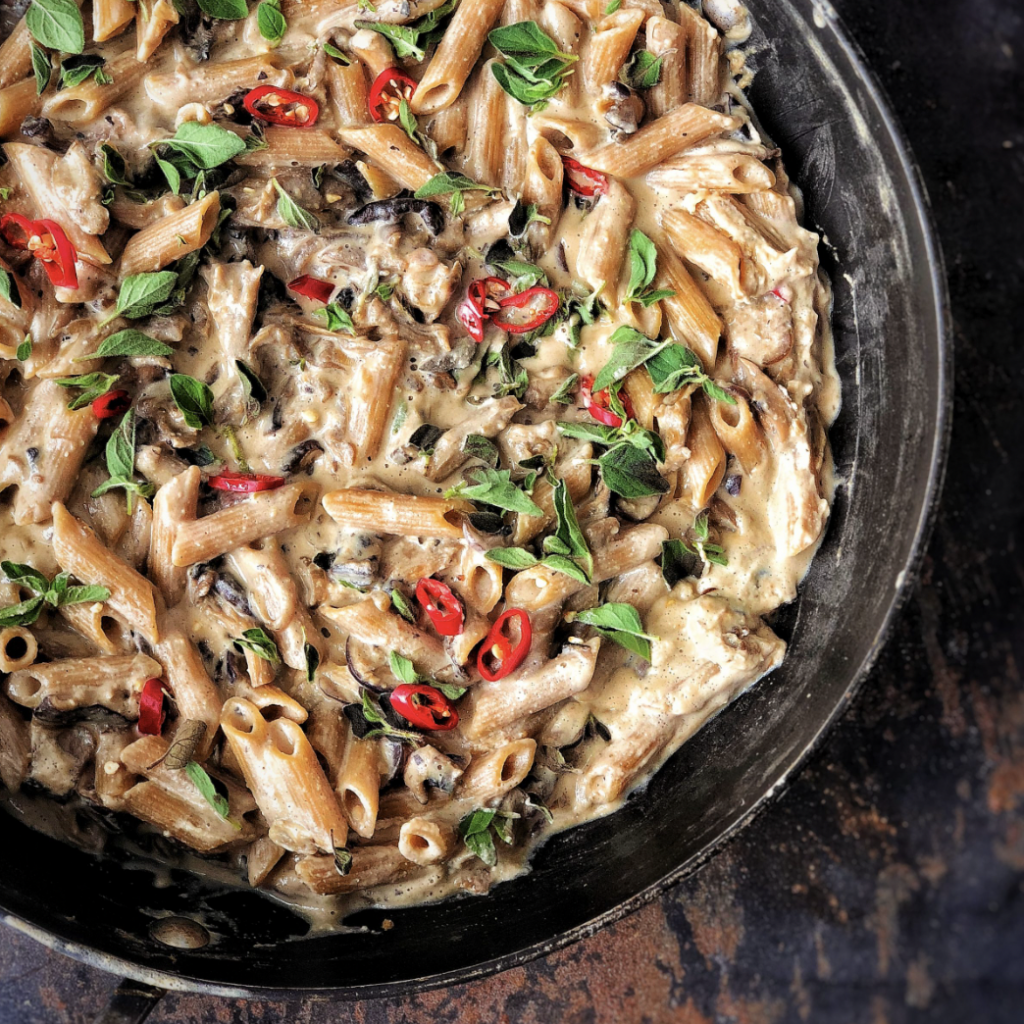
OIL-FREE CREAMY MUSHROOM PASTA
Easy to make, really simple and super tasty, this creamy, fried mushrooms pasta is well worth making…AND it has no oil! Huge win!
Total Time Needed: 15 Mins
Difficulty: Easy
The Bottom Line
It is never too early and never too late to bring in dietary and lifestyle changes that will help you manage menopause symptoms.
A fibre rich plant-based diet combined with exercise, good sleep hygiene, mindfulness and stress management can go a long way in combating menopausal symptoms.
For more expert advice in easing menopause symptoms, be sure to check out our course, Happy Menopause! Access the course via our membership platform on the app. Start your seven-day free trial TODAY!
Menopause is turning the page to a new chapter – a chapter to grow in wisdom, experience, and to become a better version of yourself. This is your time to thrive.
The Happy Pear Podcast
How often do your bare feet touch the earth; soil, grass, sand, stones?
Do all your shoes have rubber souls?
Have you ever heard of grounding?
Episode 94 – Clint Ober
For more than 20 years, Clint Over has dedicated his life to improving the health of everyone on earth.
In 1998, after a successful career grounding systems in the cable television industry, Earthing pioneer Clint Ober began investigating the potential to improve human health with grounding.
“I had suffered from chronic pain, unable to sleep for years. After I did this, I went to bed and for the first time since I could remember I woke up the next morning, I had slept through the night and the pain was gone.”
Today, he is the founder of Earth FX Inc., a grounding research and development company based in California through which he helped to develop, and patent, the first indoor Earthing products.
This episode will give you goosebumps and if you are like us you will be rushing off to buy your grounding bedsheets!
Enjoy!
Lots of Love,
Dave & Steve x
Available now from all good podcast providers:
To find out more about Mo and his work please check out: https://www.mogawdat.com/
Produced by Sean Cahill and Sara Fawsitt
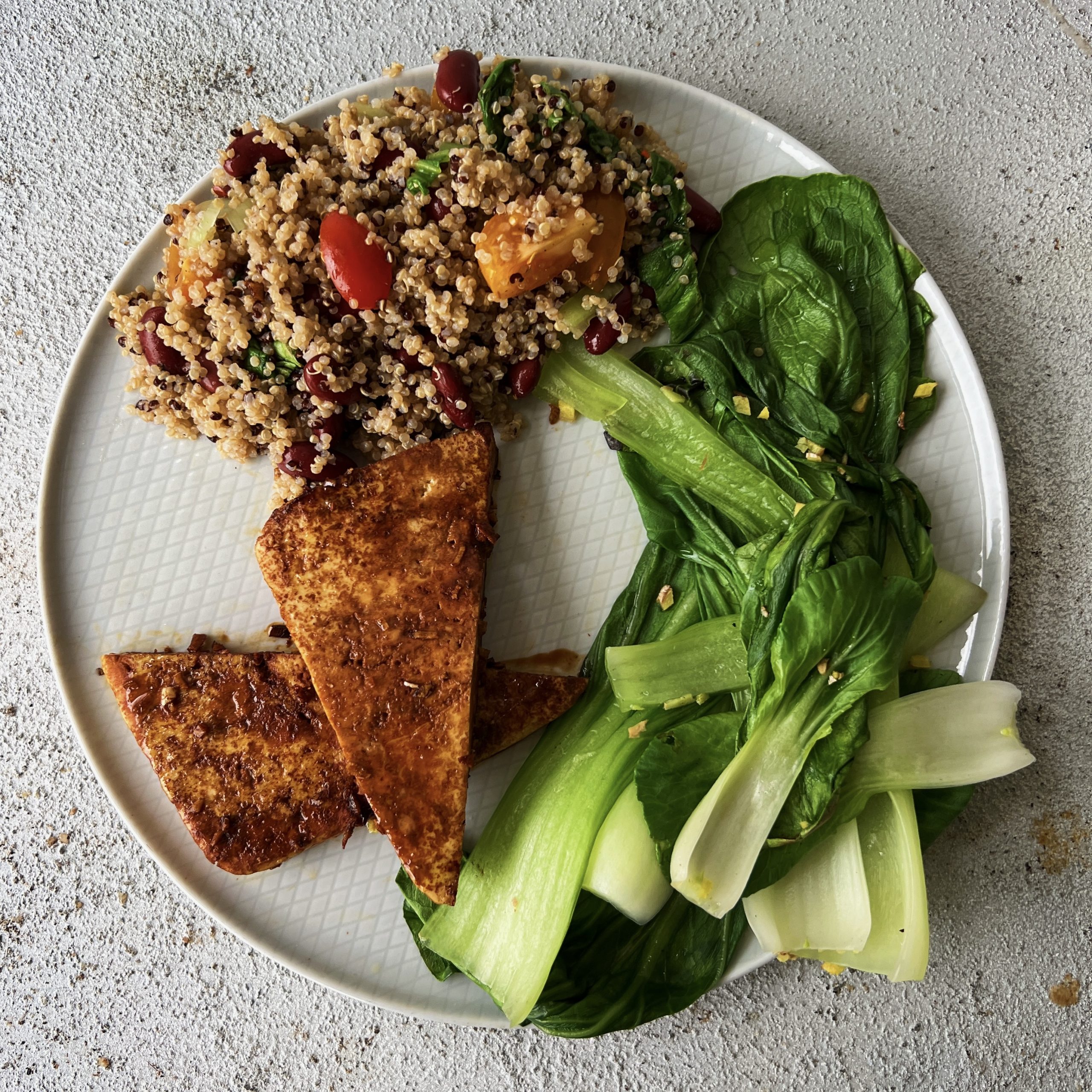
Pan-fried Tofu with Steamed Greens and Quinoa
Takes 15 minutes
Serves 2
Ingredients
- 100 g quinoa
- 225 ml water
- 100 g spinach kale, chard, or York cabbage
- 200 g firm tofu
- A small thumb-sized piece of fresh ginger approx. 15 g
- 1 small red chilli leave it out if you don’t like spice
- 100 g fresh tomatoes
- 1.5 tbsp sesame seeds
- 2 tbsp tamari
- Juice of 1 lime
- Optional: Nutritional yeast for serving
Instructions
- Put the quinoa on to boil with the water and a pinch of salt. Bring to the boil, then reduce the heat to a simmer with the lid slightly ajar.
- Once nearly all the water has evaporated, remove the pot from the heat, cover with a lid, and let it steam for 10 minutes. The quinoa will fluff up.
- Wash the greens, remove the tough centre veins, and roughly chop into bite-sized pieces. Steam for 3 minutes until softened but not overly cooked, turning occasionally for even cooking. Set aside.
- Chop the tofu into ½ cm cubes. Peel and finely chop the ginger, deseed and chop the chilli (or leave the seeds for more spice), and chop the tomatoes into bite-sized pieces.
- Heat a non-stick pan over high heat. Add the ginger and chilli, frying for 1–2 minutes. If it sticks, add 2 tbsp water and scrape up any browning with a wooden spoon.
- Add the tofu and sesame seeds, frying for 4 minutes and stirring regularly until golden on all sides. Add more water if necessary.
- Pour in the tamari, stirring to coat the tofu evenly. Turn off the heat.
- Add the steamed greens, tomatoes, and lime juice to the pan. Stir well and cook for another 3–4 minutes.
- Serve the quinoa in bowls with the tofu, greens, and sesame mix on top. Sprinkle with nutritional yeast if desired.
Nutrition
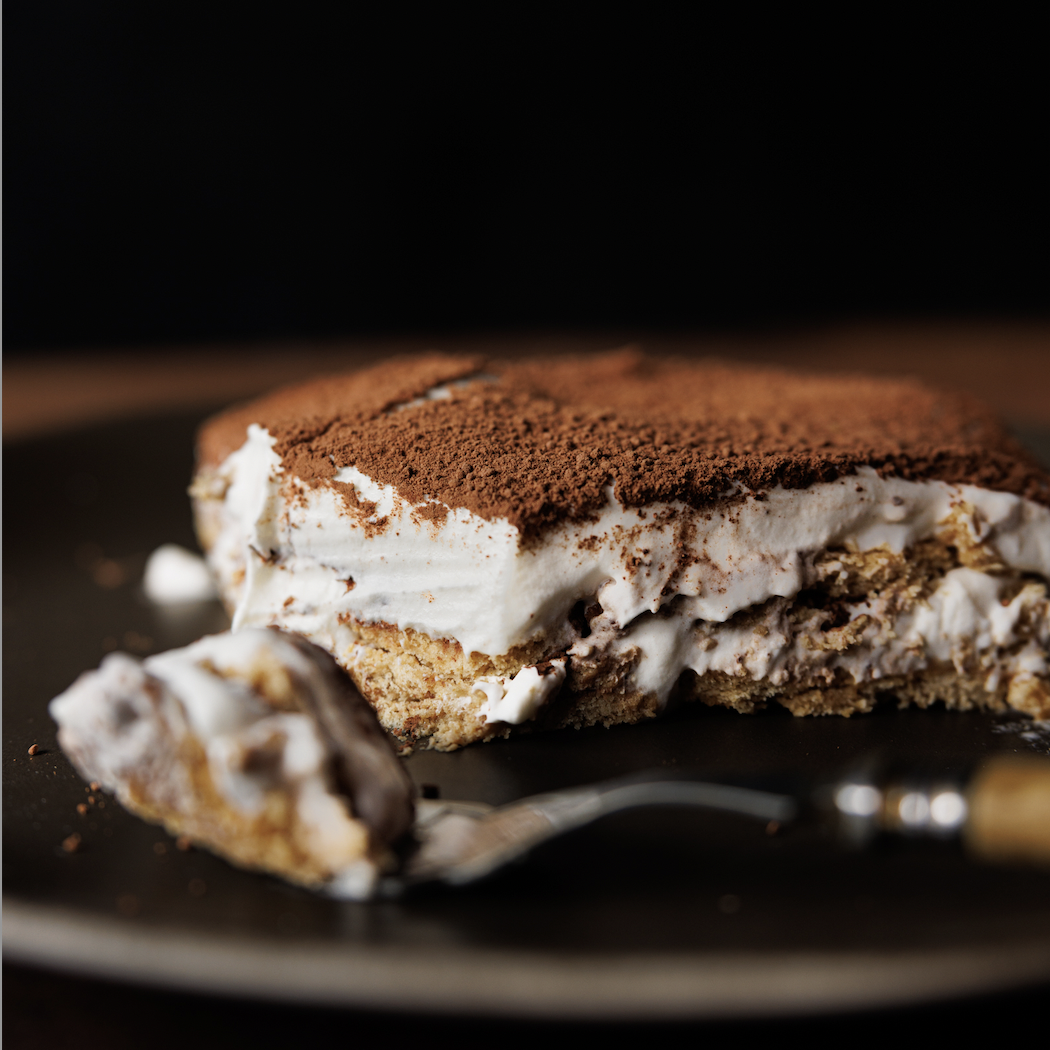
5 Minute, 5 Ingredient Tiramisu
Takes 5 minutes
Serves 8
Ingredients
- 500 g vegan whipped cream
- 50 g cocoa powder
- 60 g icing sugar
- 300 ml strong coffee
- 500 g digestive biscuit
Instructions
- Prepare the coffeeBrew a strong cup of coffee and mix in 3 tbsp of icing sugar. Stir well to dissolve the sugar.
- Whip the creamWhip the vegan cream until stiff peaks form. Add 3 tbsp of icing sugar and mix well.
- Soak the biscuitsDunk each digestive biscuit in the sweetened coffee 2-3 times, depending on how firm the biscuits are. The goal is to let the biscuits soften and absorb the coffee until they reach a sponge-like consistency after soaking.
- Assemble the tiramisuUse a baking tray approximately 25cm x 25cm x 3cm (or 9 x 9 inches x 1 inch). Lay a single layer of soaked biscuits at the base of the tray. Spread a generous layer of whipped cream on top, followed by a dusting of cocoa powder.
- Add another layerRepeat the process by adding another layer of soaked biscuits, followed by another layer of cream and a generous dusting of cocoa powder.
- ServeYour tiramisu is ready to serve immediately. Enjoy!
Nutrition
Video
The Happy Pear Podcast
Can happiness be taught?
According to this week’s podcast guest, Mo Gawdat, it can!
Episode 93 – Mo Gawdat
“It’s not the events that make you happy in life, it’s the comparison that happens inside your head between the event and your expectation of the event.”Mo Gawdat is the former Chief Business Officer of Google X; host of the popular podcast, Slo Mo, author of the international bestselling books Solve for Happy and Scary Smart; and founder of One Billion Happy.
After a 30 year career in tech and serving as Chief Business Officer at Google X (Google’s ‘moonshot factory’ of innovation) Mo has made happiness his primary topic of research, diving deeply into literature and conversing on the topic with some of the wisest people in the world.
Motivated by the tragic loss of his son, Ali, Mo began pouring his findings into his international bestselling book, Solve for Happy: Engineer Your Path to Joy. His mission to help one billion people become happier, #OneBillionHappy, is his moonshot attempt to honor Ali by spreading the message that happiness can be learned and shared with one billion people.
“If a parent’s only wish is happiness for their children then why aren’t we teaching it in school?”
According to Mo, happiness is an equation, and gratitude is the ultimate expression that can remind us to be happy.
“You are the one that is setting your expectation. You are the one interpreting the event a certain way, therefore you are in control of your own happiness.”
We had a great chat with Mo, on our favourite topic, you guessed it – happiness! A brilliant episode that will hopefully leave you feeling elevated, grateful, and dare we say it… happy!
What’s more, Mo has also offered you a gift! The first 100 listeners of The Happy Pear Podcast to sign up, will get an exclusive two month free access to his membership community. You get all the training material, rieki infused meditations, and live webinars with Mo, his co-author Alice and expert guest speakers. This is worth 50 Euros and you get it for free on Unstressable.com. sign up now and use the code THEHAPPYPEAR to be one of the first 100!
Lots of Love,
Dave & Steve x
Available now from all good podcast providers:
To find out more about Mo and his work please check out: https://www.mogawdat.com/
Produced by Sean Cahill and Sara Fawsitt

10 Menopause Myths
We all want to live long, happy lives. It’s a pretty universal desire.
Growing into our older bodies is a gift that many are not afforded. However, for some women, aging can be accompanied by the discomforts and uncertainties of menopause.
This can be a difficult stage of life. It can also be extremely transformative.
Menopause is turning the page to a new chaper – a chapter to grow in wisdom, experience, and to become a better version of yourself.
While it can feel overwhelming, it doesn’t have to be! There is a lot of misinformation, and we’re here to clear up the ten biggest menopause myths. We’ve consulted with some of the greatest experts in the field of women’s health to help you along this next phase of life.
For more expert insight, check out our podcast with the brilliant Dr. Nitu Bajekal, a gynaecologist with thirty-five years of experience empowering women to take charge of their health.

1. Miserable menopause symptoms are a guarantee.
Hot flushes, low libido, irritability, brain fog… These are just some of the joys of menopause. Believe it or not – it doesn’t have to be this way!
Menopause can be a beautiful period in one’s life. A time for new beginnings, fresh starts, and a new you. With the proper support and healthy lifestyle changes, misery in menopause does not have to be your reality.
Proper guidance in movement, sleep, and nutrition can significantly decrease those hormonal fluctuations and discomforts. A plant-based diet can support optimal health in all stages of life. These easy vegan tacos are low fat and packed with protein and fibre.
2. Menopause starts after the age of fifty.
Wouldn’t it be nice if menopause were that predictable? Unfortunately, this isn’t the case. Menopause runs on it’s own clock – not yours.
While the average age of menopause is fifty-one, the average range of menopause falls between forty-five and fifty-five years old for women across the world.
Early menopause occurs when a woman’s period stops between the ages of forty and forty-five. In approximately one percent of cases, menopause can start before the age of forty. This is known as premature ovarian insufficiency, or POI.
The average life expectancy of a woman in the UK is just under eighty-three years. Therefore, women can hopefully expect to live thirty plus years after menopause.
This period is extremely important and can include some of the happiest and most productive years of an individual’s life. For more tips and science on ageing well, be sure to listen to our podcast episode with Dr. James Timmons.
3. Menopause starts when your period stops.
Not quite. Menopause occurs when the number of eggs in the ovaries drop to a critical level where periods stop. However, a woman is only considered menopausal or post-menopausal when they have not had any periods or bleeding for at least twelve months.
As you can imagine, this can be confusing. If your periods have stopped for any reason, or if your bleeding patterns suddenly change, you should always consult your doctor for advice.
Many women assume that they cannot get pregnant as they approach perimenopaus or menopause. However, this is not the case.
If your periods have stopped before the age of fifty, you should continue to use effective contraception for at least two years after your last period. If you are over the age of fifty, it is recommended you use contraception for at least one year after your last menstrual period.
4. Symptoms are normal and there’s no reason to seek help.
Unfortunately, many women persist in their discomfort with symptoms of menopause because they believe their experience is ‘normal.’ Studies have shown that eight out of ten women suffer from significant hot flushes, yet only two to three will seek help.
Even fewer individuals seek help for symptoms of painful sex. While this may be for a number of reasons, it is important that individuals experiencing menopausal symptoms advocate for themselves to receive the most appropriate and effective supports.
While menopause is guaranteed. Significant discomfort does not have to be. Be sure to connect with your doctor, as well as certified nutrition experts and lifestyle practitioners to promote the most optimal health and reduce uncomfortable symptoms.
5. Weight loss is impossible during menopause.
Hormonal fluctuations in perimenopause and menopause, sleep disturbances, increased anxiety, and stress can make it easier to put on weight and more challenging to lose it.
Most adults ten to steadily put on weight between the ages of twenty and sixty-five, with women in early menopausal years often noticing unwanted weight gain.
While managing weight in menopause can be challenging, it is definitely not impossible. Eating a whole food, plant-based diet, moving your body, and prioritising your sleep can not only prevent chronic disease, but it can help you maintain a healthy weight.
Developing ways to reduce using oil while cooking can help to keep weight off in menopause. For example, saute and cook in water or vegetable broth. These easy, cheesy enchiladas are oil-free and sacrifice no flavour!
Any diet is destined to fail long-term if not a part of a healthy, sustainable lifestyle with realistic goals and a positive mindset. Repeat an affirmation out loud at least five to ten times per day. Let the words that leave your mouth be both kind and true. Be patient with yourself and take a step toward change.
6. Your sex life is over.
Low sexual desire, low libido, and vaginal changes are all symptoms of menopause. However, these changes do not mean that your sex life has to suffer.
Between 17-45% of postmenopausal women report finding sex painful. This is likely due to falling hormone levels which can cause vaginal atrophy, or thinning of the lining of the vagina.
Not to fear. There is still plenty to do to improve vaginal lubrication and comfort during sex.
Women should try to avoid: excessive washing, douching, using perfumed toiletries, feminine wipes and synthetic perfumes. Natural oils such as coconut oil, Vitamin E, or almond oil after a shower can help to lock in moisture around the vulval area. Water-based vaginal moisturizers and lubricants help make sexual intercourse more comfortable.
Most importantly – take charge of your diet and lifestyle! Eating whole plant foods, such as soybeans, watermelon, and lots of veg can help to improve the vaginal microbiome.
During menopause, many women feel a loss. They may feel more fatigued or just not like themselves. Having said that, menopause can also be liberating for many. It’s a time when one is often more secure, confident, and can ask what they want sexually.
The most important factor is to remain open and patient throughout this stage, communicate openly with your sexual partner, and seek support together if needed. For more on sexual longevity, check out our fascinating conversation with Dr. Amy Killen.
7. It’s too late for lifestyle changes.
The earlier you incorporate dietary and lifestyle changes, the more benefits you are likely to see. That said, it is never too late to start making changes. These changes can help manage symptoms of menopause and live a happier and more fulfilling life.
Approximately 80% of what health professionals are seeing today is related to lifestyle. Nutrition, exercise, sleep, alcohol use, stress and loneliness all play key roles in chronic disesase, as well as women’s health issues such as menopause.
A fibre-rich plant-based diet, combined with a healthy exercise routine, good sleep hygience, mindfulness, and having positive social connections can go a long way in combating menopausal symptoms.
Additionally, many women find the time around menopause stressful. It is so important to take care of your own needs during this stage of life, especially when these needs may have been put on the back burner for so long.
Self-care can include deep breathing, walking in nature, or a long bath. It could involve setting healthy boundaries with others. Build your self-care toolbox.
Don’t forget to have fun, too! Cultivate a sense of curiosity, fun, and light heartedness in your life. These small changes support optimal health in menopause and beyond.
8. Soy products will disrupt your hormones further.
The soybean is a legume that has been around for thousands of years. Despite the various opinions and misconceptions, it is not only safe but optimal for your health.
Adopting plant-based diets rich in legumes including beans, lentils and peas, and especially soy helps reduce menopausal symptoms in two ways.
First, soy is a rich source of plant oestrogens or natural phytoestrogens. These can help to reduce both hot flush incidence and severity. Second, soy can help to promote a happy weight. Excess body weight is associated with a higher incidence of symptomatic hot flushes.
Soy also helps to reduce the risk of heart disease, lowers cholesterol levels, reduces the risk of breast, bowel, liver, and ovarian cancers and reduces the risk of osteoporosis.
Two to four daily portions of minimally processed soy products, such as soy milk, soy yoghurt, edamame beans, mature soybeans, tofu, miso, and tempeh is recommended by experts.
A randomised controlled trial suggested fantastic results. Only a half cup of mature soya beans reduced the frequency and severity of hot flushes by 84% and improved the quality of life in vasomotor, psychosocial, physical, and sexual symptoms in postmenopausal women when followed for only twelve weeks.
Don’t be afraid to add soy to your diet! It’s incredibly healthful and can reduce your risk of chronic disease, in addition to supporting menopausal symptoms. Check out our favourite ways to cook tofu for amazing texture and flavour!
9. A plant-based diet can’t meet your protein needs.
Many experts believe that protein needs are higher as we get older. The current recommendation is that individuals ages sixty five and older aim for a daily protein intake of at least 1-1.2g per kg of body weight.
There seems to be a common misconception that you can’t get enough protein without consuming animal products. This is simply untrue.
By eating a wide variety of plant foods with a focus on protein rich foods, such as legumes, you can easily meet protein recommendations. Nearly all vegetables, legumes, grains, nuts, and seeds contain some protein. Protein is made up of amino acids and plants contain all nine amino acids, much to contrary belief.
Replacing some grains in your diet with beans is one way to increase your protein intake. By focusing on two to four servings of soy products per day, such as tofu, tempeh, and soy milk, you can easily achieve higher protein recommendations during menopause.
You can thrive on a plant-based diet at all stages of life. Check out this delicious, high protein bowl for a super tasty meal.
10. Your body is failing you.
Menopause can certainly come with challenges, but it can also be accompanied by great wisdom and experience. A new you is emerging, and it’s time to embrace those changes.
Our most productive and enjoyable years are often after menopause. We can take time to pursue the things we’re passionate about. We can be of great help to our families and our greater community.
If you feel yourself slipping into a negative space, try incorporating some positively worded statements, or affirmations, in your day. Studies have shown that these can decrease stress and increase well-being. They can strengthen self-worth and ensure you practice kindness and compassion toward yourself.
Menopause – A New Beginning
While menopause can certainly signify a conclusion to one chapter of life, it also represents a new chapter and beginning to be enjoyed.
There is a beautiful life to be lived during and after menopause, and we encourage you to take control of your health and happiness to make it your best years yet.
If you’re craving community connection, access to expert advice, exercise, movement, and mindfulness, along with over 600 delicious plant-based recipe – be sure to join our Happy Menopause Course!

There’s always a lot of left-over pumpkin in the lead up to Halloween…so we made these delicious little slices. The pumpkin filling is so rich and creamy and in the words of Steve…”there a bit too moreish!” Ladies and Gents…Pumpkin and Pecan Slices
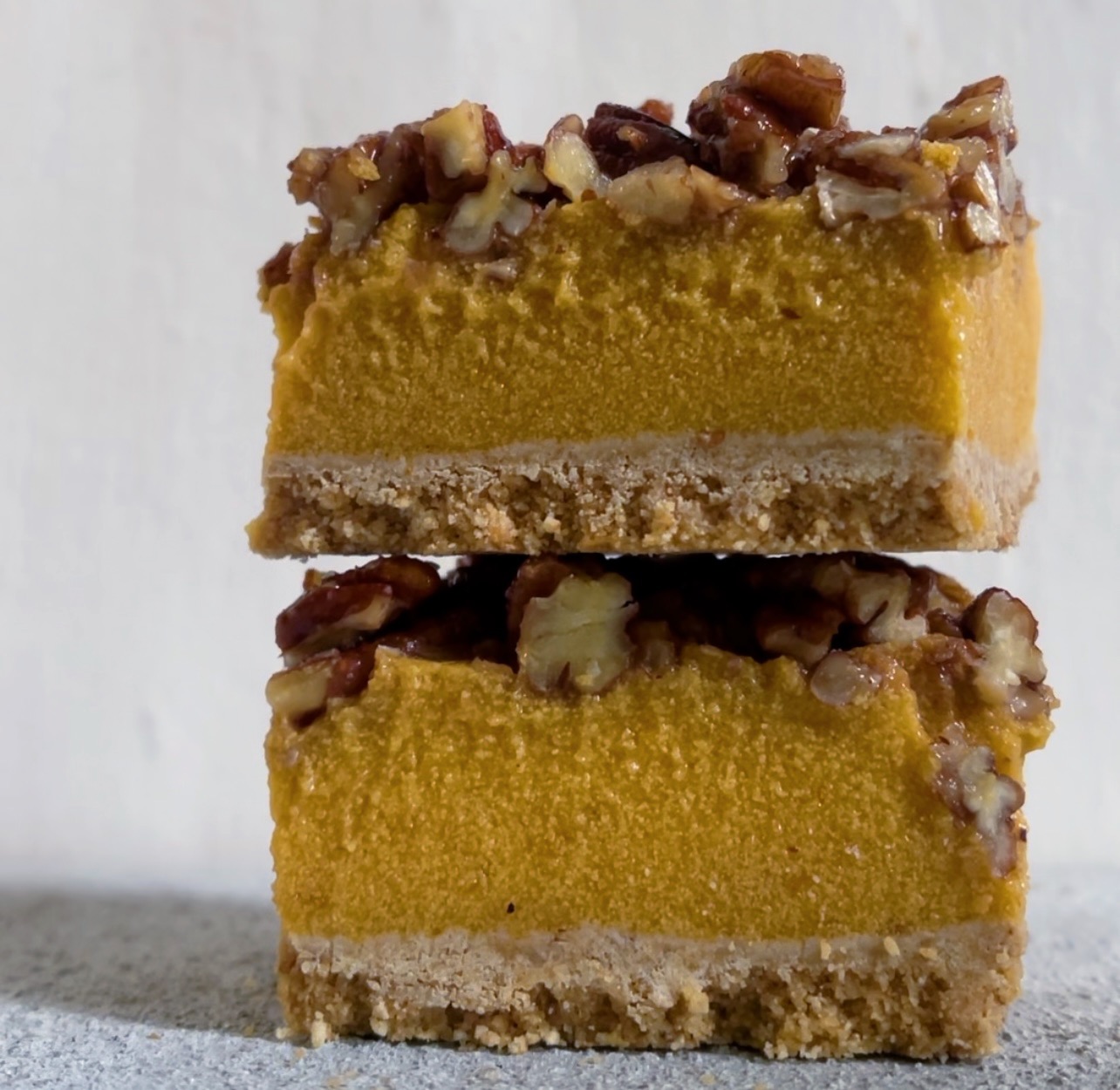
Pumpkin and Pecan Slice
Takes 1 hour 28 minutes
Serves 12
Ingredients
Base
- 200 g Digestive biscuits
- 80 g coconut oil
- 1/2 tsp vanilla extract
Filling
- 500 g Pumpkin 500 g pumpkin/squash (400g pumpkin puree)400 g vegan creamed cheese100 g coconut oil140 g maple syrup1 tsp vanilla extract1 tsp ground cinnamon2 tsp ground ginger1 pinch salt
- 400 g vegan cream cheese
- 100 g coconut oil
- 140 g maple syrup
- 1 tsp vanilla extract
- 1 tsp ground cinnamon
- 2 tsp ground ginger
Topping
- 150 g pecan nuts roughly chopped
- 50 g maple syrup
Instructions
- Peel the pumpkin and remove the seeds. Slice the flesh of the pumpkin into small bite sized pieces. Add them to a baking tray and bake for 25 minutes until cooked through.
- Add the biscuits to the food processor and blend until they reach a breadcrumb like consistency (approx 1 minute). Add the coconut oil and vanilla extract (if using) and blend until incorporated (approx 30 seconds).
- Transfer the blended base ingredients to a lined spring form pie dish. A spatula is easiest to ensure you get everything out of the food processor. Using a spoon spread it around evenly. Use the back of the spoon to compact it till it becomes firm and compact.
- Wipe out the food processor. Add the roasted pumpkin to the food processor along with all the rest of the filling ingredients and blend until nice and smooth.
- Using a silicon spatula transfer the filling onto of the base. Spread out so smooth and even.
- Over a medium heat, heat a frying pan and add the roughly chopped nuts, stirring continuously for 2-3 minutes. Add the maple syrup and keep moving the nuts around in the pan until the nuts are completely coated in the sizzling syrup and begin to crystallise. Remove from the heat. Once slightly cooler, scatter over the top of the pumpkin filling.
- Pop in the fridge for an hour before slicing up. Enjoy!
Nutrition

5 Things You Didn’t Know About Your Gut
The ability to enjoy our food is central to the human experience.
Nobody wants to go through feelings of pain and discomfort accompanied by bloating and gas. While these can be triggered by many different things, both are a sign that your gut health may be in need of a little extra love.
Did you know that ancient civilizations believed that the gut was an extension of the brain? Although many scoff at this ancient wisdom, advances in research have shown that there’s a reason people say to ‘trust your gut.’
Our gut health impacts our mood, digestion, immunity, and overall health. There’s a lot to learn when it comes to the gut microbiome. That’s why we’ve identified five things you might not yet know about your gut!
For more expert insight on how to improve your gut health, be sure to check out our podcast episode with award winning gastroenterologist, Dr. Will Bulsiewicz.
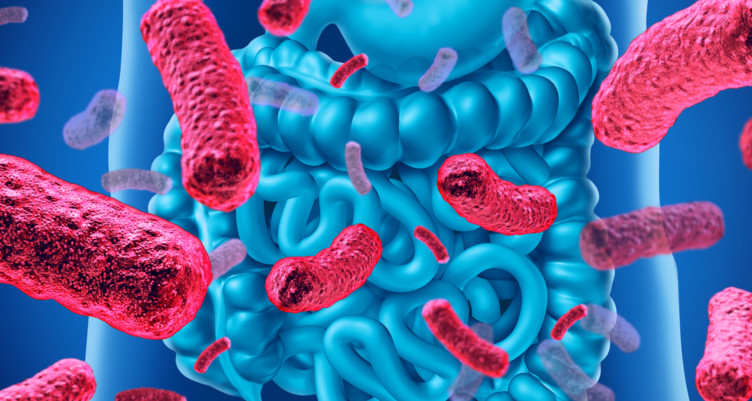
Your gut is the control centre for human biology
Hippocrates, considered the father of modern medicine, believed that all health begins in the gut. Two-thousand years later, we recognize the truth in this through our learnings about the human gut microbiome.
By adulthood, this microbiome has developed into an incredibly complex ecosystem. Over 100 trillion microbes, bacteria, yeasts, viruses, and archaea delicately interact with one another to support our digestive system, as well as our entire being.
Our gut microbes have been described as a control centre for human biology. Our microbes produce dozens, if not hundreds, of chemicals that contribute to our health outcomes. They regulate our appetite, blood sugars, inflammatory processes, and metabolic health.
In our journey to better gut health, our gut microbes are our crucial allies. They rely on us, and we depend on them for optimal wellbeing.

Your gut thrives on fibre-rich foods
Since our digestive system cannot break down fibre, the human body has brilliantly outsourced the task to our gut microbes. Through the supply of fibre-rich foods, such as fruits, vegetables, wholegrains, beans, and unprocessed plants – we boost the production of what are called Short-Chain Fatty Acids (SCFA).
Here are just a few of the benefits of SCFAs:
- They help to produce hormones that regulate our appetite and control our blood sugars.
- A gut starved of SCFAs can lead to what’s known as leaky gut, which drives inflammation and can lead to problems such as heart disease.
- SCFAs interact with our immune system daily, preventing an overactive immune system, which can help support conditions like Crohn’s disease.
Sadly, nearly 90% of adults do not consume enough fibre. A diet high in animal products and processed foods has been shown to cause bloating, constipation, and poor gut health. High consumption of ultra-processed foods wreaks havoc on microbiome diversity.
If you want to avoid bloating, constipation, IBS, leaky gut, and other digestive related issues, a high-fibre plant based diet can ensure your gut microbiome flourishes.
Your gut appreciates movement and rest
At Happy Pear, we like to think of our gut microbiome as our little pet. Yes, you read that right.
Just like your family pet needs a proper diet, rest, and exercise – so does your gut!
If you know anything about us, you know we always prioritise daily movement. We love a beautiful ‘swimrise’ on Greystones beach with our community and can fit a yoga session in even the snuggest of spaces. Daily movement and a healthy exercise routine are key to our overall health and energy levels.
Recent research even suggests that when comparing the microbiome of non athletes to professional rugby players, the rugby players had a stronger and more diverse microbiome. Frequent and regular exercise is really beneficial for gut health – so get moving!
As important as movement is in our lives, so is sleep! Sleep is such a crucial factor for our overall health, but yet it’s often one of the first to be compromised with busy schedules.
Sleep deprivation can lead to overeating processed foods that are higher in fat and sugar and low in fibre. These foods typically trigger uncomfortable feelings of bloating and constipation. Additionally, sleep deprivation has been linked to reduced microbial diversity.
So, keep your gut happy by getting 7-8 hours of sleep per night!
Your gut loves the great outdoors
Did you know that people who live in the countryside tend to have healthier and more diverse microbiomes than city residents? An oversantised indoor lifestyle is not the best for our microbial health. Instead, get outside as much as possible! If you can’t make it out of the city, spend some time in local parks – or even your backyard!
Connecting to the earth, or grounding as it’s often referred to, can have amazing benefits for your wellbeing. Spending time in nature exposes us to more bacterial biodiversity, which in turn can help us to create a more diverse microbiome and even improve our immune system.
Your gut craves plant diversity
For years, a team of researchers attempted to discover what defined a healthy microbiome. In their work, they uncovered that the #1 predictor is the diversity of plants in your diet.
The study highlighted that individuals who ate more than thirty different plants per week unlocked incredible benefits of fibre-loving bacteria in the gut microbiome. Unfortunately, due to the Standard Western diet – fewer than 1 in 250 people are achieving that goal.
If you’re familiar with our gut health recipes, you’ll have already noticed that each has a plant score. This is an easy way to keep track of the diversity of plants in your diet. Whether it be a bean, green, or wholegrain – try them all! Your microbiome will thank you.
Why Gut Health Matters
We all want to live happily and in good health. One of the best ways to boost our health, strengthen our immune system, and optimise digestion is to cultivate a healthy gut.
Our gut microbes are key contributors to our health, and we can work in partnership with them. When the gut is happy and healthy – the feeling is often mutual.
If you’re looking to heal your gut and reclaim your health, we’re here to help. It’s no coincidence that the lifestyle for a healthy gut looks a lot like what we’ve been sharing with our Happy Pear community for more than eighteen years.
If you want to learn our five secrets to optimise your gut health and reduce constipation and bloating, be sure to check out the Gut Health Revolution course on our app. Plus, gain exclusive access to simple, fifteen minute meals to heal your gut, along with all of our other favourite Happy Pear recipes in one place! Start your seven-day free trial today!

The Happy Pear Podcast
Oliver Burkeman is the author of the New York Times and Sunday Times bestseller Four Thousand Weeks, about embracing limitation and finally getting round to what counts, along with The Antidote: Happiness for People Who Can’t Stand Positive Thinking and Help! How to Become Slightly Happier and Get a Bit More Done.
Episode 92 – Oliver Burkeman
“We are dissuaded from doing things that add great value to our lives just to avoid discomfort.”
For many years he wrote a popular column for the Guardian, ‘This Column Will Change Your Life’. In his email newsletter The Imperfectionist, he writes about productivity, mortality, the power of limits and building a meaningful life in an age of distraction. He lives in the North York Moors.
This episode is particularly special as it is the first that was LIVE on our app, Healthy Living by The Happy Pear!
“We talk about not wanting to settle when we think we can do better… but we end up becoming a commitment-phobe and don’t realise that both of these are settling. One is settling for an imperfect human being and the other is denying yourself the pleasure of and benefits of a long term relationship… this doesn’t just apply to dating and it’s great to realise this so you stop making decisions motivated by this notion of a perfect outcome.”
We had a wonderful conversation with Oliver, and members of the app got to ask their questions too. We spoke about the issues with time management, our inability to be in the present moment, how to achieve more by doing less, how the concept “to settle” isn’t always a negative thing, the importance of leaning into discomfort, amongst many other things.
We hope you enjoy this episode as much as we did.
Lots of Love,
Dave & Steve x
Available now from all good podcast providers:
To find out more about Oliver Burkeman and his work, check out: https://www.oliverburkeman.com/
Produced by Sean Cahill and Sara Fawsitt
this a link to Justyna Flynn’s website from our site – she’s a brilliant Clinical Psychologist, Gestalt psychotherapist and somatic experience therapist. She has an office for private sessions – link here to learn more
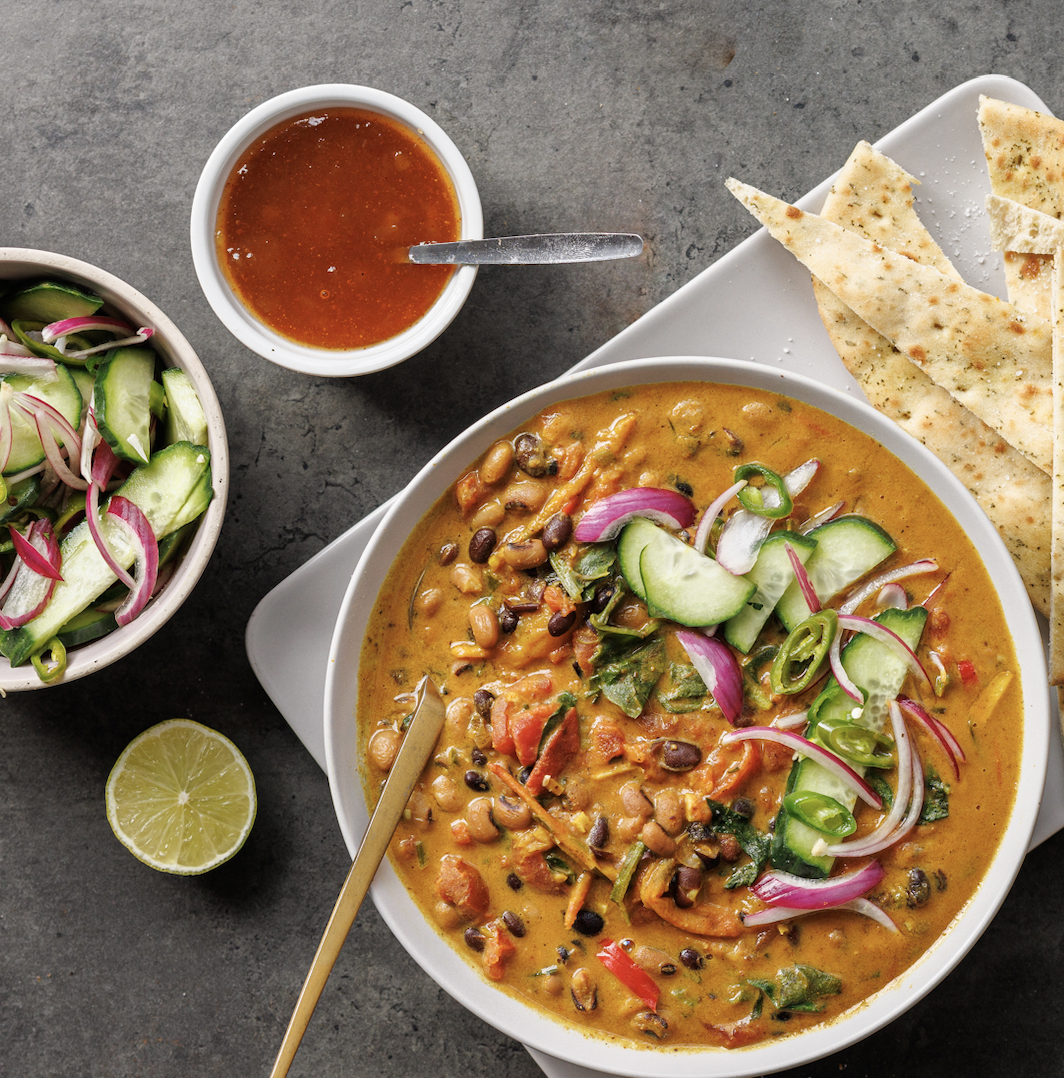
15-Minute Indian Feast
Takes 12 minutes
Serves 4
Ingredients
Curry:
- 4-5 scallions (spring onions)
- ½ thumb-sized piece of ginger
- 2 cloves garlic
- ½ red chilli
- 20 cherry tomatoes
- 1 tsp cumin seeds
- 1 tsp coriander seeds
- ½ tsp cardamom pods
- 1 tbsp turmeric
- ½ tsp chilli powder
- 1 tsp garam masala
- ½ tsp black pepper
- 1 tbsp mango chutney
- 400 g chopped tomatoes (tinned)
- 400 g black beans (tinned)
- 400 g black-eyed beans tinned
- 400 g coconut milk (full-fat, tinned)
- 50 g baby spinach
- Juice of ½ lime
- 2 tsp salt
Cucumber Pickle:
- ½ cucumber
- 2 green chillies
- 1 red onion sliced into half moons
- 50 ml apple cider vinegar
- 1 tbsp maple syrup
To serve:
- 2 naan breads
- Mango chutney
Instructions
- Start the Pickle:Peel and finely slice the red onion into strips. Slice the green chillies into thin rounds, removing the seeds if you prefer it less spicy. Add them to a large glass with a pinch of salt, the vinegar, maple syrup, and enough water to submerge the onions and chillies. Leave to pickle while you prepare the rest of the dish.
- Toast the Spices:Heat a wide-bottomed non-stick pan on high heat. Once hot, add the cumin seeds, coriander seeds, and cardamom pods. Toast for 2-3 minutes until the cumin seeds start to pop. Remove from the pan and crush into a powder using a pestle and mortar or by placing in a zip-lock bag and using the bottom of a mug. Remove any large pieces of cardamom skin and discard.
- Prepare the Curry:Heat the pan again on high. Slice the spring onions into thin slices, peel and finely dice the ginger and garlic, and finely chop the chilli (remove the seeds for less heat). Add 1.5 tbsp of oil to the hot pan along with the spring onions, ginger, garlic, and chilli, and fry for 2-3 minutes.
- Add Tomatoes and Beans:Quarter the cherry tomatoes and add them to the pan with a pinch of salt, mixing well. Drain and rinse both the black-eyed beans and black beans, then add them to the pan, stirring to combine.
- Spice and Simmer:Add the turmeric, garam masala, chilli powder, and black pepper to the pan and cook for 1-2 minutes, stirring well. Then, add the chopped tomatoes, coconut milk, 1 tsp of salt, and 1 tbsp of mango chutney. Mix and heat through, stirring occasionally. Add the baby spinach and the juice of ½ lime, then taste and adjust the seasoning with more salt, pepper, or lime juice as needed.
- Prepare the Cucumber Pickle:While the curry is simmering, slice the cucumber in half lengthwise, then cut into thin strips. Drain the pickled onions and chillies, and mix them with the cucumber in a bowl, saving the pickling brine for future use.
- Serve:Heat the naan bread. Serve everything on a large platter with the curry, cucumber pickle, and naan bread, and enjoy with a dollop of mango chutney!
Nutrition
Video

We’re chuffed with these little bites. They are made with 96% fruit, contain no added sugar and are high in fibre. Each pack has less than 100 calories and contains 1 of your 5 a day. Great for healthy snacks while on the go, kids lunch boxes or even if you’re out for a long run or cycle!
INGREDIENTS
Fruit (96%) [Apple Juice Concentrate, Apple Purée Concentrate, Strawberry Purée (5.5%), Beetroot Juice Concentrate (1%)], Gelling Agent (Pectin), Citrus Fibre, Lemon Juice Concentrate, Natural Flavouring, Black Carrot Juice Concentrate
ALLERGEN INFORMATION
For allergens, including Cereals containing Gluten, see ingredients highlighted.
May contain traces of Peanuts, Nuts and Sesame.
NUTRITIONAL INFORMATION
| Typical | per 100g |
|---|---|
| Energy | 1979kJ/327kcal |
| Fat | 1.6g |
| Of which Saturates | 0.7g |
| Carbohydrates | 74g |
| Of which Sugars* | 70g |
| Fibre | 7.0g |
| Protein | 0.8g |
| Salt | 0.10g |
SAFETY WARNING
Not suitable for children under 3 years. Children can choke on small pieces of fruit.

We’re chuffed with these little bites. They are made with 96% fruit, contain no added sugar and are high in fibre. Each pack has less than 100 calories and contains 1 of your 5 a day. Great for healthy snacks while on the go, kids lunch boxes or even if you’re out for a long run or cycle!
INGREDIENTS
Fruit (96%) [Apple Juice Concentrate, Apple Purée Concentrate, Strawberry Purée (5.5%), Beetroot Juice Concentrate (1%)], Gelling Agent (Pectin), Citrus Fibre, Lemon Juice Concentrate, Natural Flavouring, Black Carrot Juice Concentrate
ALLERGEN INFORMATION
For allergens, including Cereals containing Gluten, see ingredients highlighted.
May contain traces of Peanuts, Nuts and Sesame.
NUTRITIONAL INFORMATION
| Typical | per 100g |
|---|---|
| Energy | 1979kJ/327kcal |
| Fat | 1.6g |
| Of which Saturates | 0.7g |
| Carbohydrates | 74g |
| Of which Sugars* | 70g |
| Fibre | 7.0g |
| Protein | 0.8g |
| Salt | 0.10g |
SAFETY WARNING
Not suitable for children under 3 years. Children can choke on small pieces of fruit.
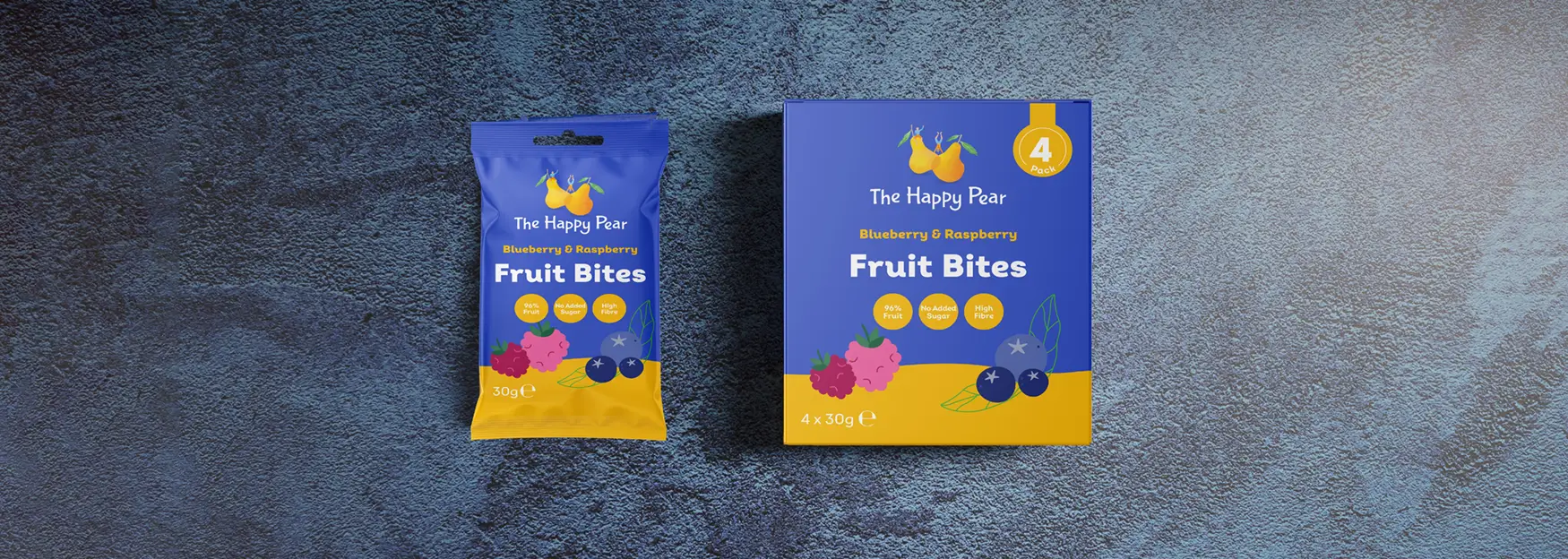
We’re chuffed with these little bites. They are made with 96% fruit, contain no added sugar and are high in fibre. Each pack has less than 100 calories and contains 1 of your 5 a day. Great for healthy snacks while on the go, kids lunch boxes or even if you’re out for a long run or cycle!
INGREDIENTS
Fruit (96%) [Apple Juice Concentrate, Apple Purée Concentrate, Blueberry Purée (3%), Raspberry Purée (3%)], Citrus Fibre, Gelling Agent (Pectin), Black Carrot Juice Concentrate, Lemon Juice Concentrate, Natural Flavouring
ALLERGEN INFORMATION
For allergens, including Cereals containing Gluten, see ingredients highlighted.
May contain traces of Peanuts, Nuts and Sesame.
NUTRITIONAL INFORMATION
| Typical | per 100g |
|---|---|
| Energy | 1979kJ/327kcal |
| Fat | 1.6g |
| Of which Saturates | 0.7g |
| Carbohydrates | 74g |
| Of which Sugars* | 70g |
| Fibre | 6.9g |
| Protein | 0.8g |
| Salt | 0.10g |
SAFETY WARNING
Not suitable for children under 3 years. Children can choke on small pieces of fruit.

We’re chuffed with these little bites. They are made with 96% fruit, contain no added sugar and are high in fibre. Each pack has less than 100 calories and contains 1 of your 5 a day. Great for healthy snacks while on the go, kids lunch boxes or even if you’re out for a long run or cycle!
INGREDIENTS
Fruit (96%) [Apple Juice Concentrate, Apple Purée Concentrate, Blueberry Purée (3%), Raspberry Purée (3%)], Citrus Fibre, Gelling Agent (Pectin), Black Carrot Juice Concentrate, Lemon Juice Concentrate, Natural Flavouring
ALLERGEN INFORMATION
For allergens, including Cereals containing Gluten, see ingredients highlighted.
May contain traces of Peanuts, Nuts and Sesame.
NUTRITIONAL INFORMATION
| Typical | per 100g |
|---|---|
| Energy | 1979kJ/327kcal |
| Fat | 1.6g |
| Of which Saturates | 0.7g |
| Carbohydrates | 74g |
| Of which Sugars* | 70g |
| Fibre | 6.9g |
| Protein | 0.8g |
| Salt | 0.10g |
SAFETY WARNING
Not suitable for children under 3 years. Children can choke on small pieces of fruit.

This Oat M*lk froths brilliantly and is epic in your favourite coffee, tea or hot chocolate. We love making Golden Turmeric Milk or Lattes with it as it’s so creamy and deliciously frothy. Enjoy!
INGREDIENTS
Water, Organic Oat (12%), Organic Sunflower Oil, Sea Salt
ALLERGEN INFORMATION
For allergens incl. Cereals containing Gluten, see ingredients highlighted.
NUTRITIONAL INFORMATION
| Typical | per 100ml |
|---|---|
| Energy | 195kJ / 72kcal |
| Fat | 2.9g |
| Of which Saturates | 0.4g |
| Carbohydrates | 10g |
| Of which Sugars* | 2.5g |
| Fibre | 0.7g |
| Protein | 1.0g |
| Salt | 0.10g |

We absolutely love the taste of this and love pouring it over our favourite granola, super muesli or using it to make delicious creamy porridge, chia seed puddings or super tasty pancakes.
INGREDIENTS
Water, Organic Oat (12%), Organic Sunflower Oil, Sea Salt
ALLERGEN INFORMATION
For allergens incl. Cereals containing Gluten, see ingredients highlighted.
NUTRITIONAL INFORMATION
| Typical | per 100ml |
|---|---|
| Energy | 195kJ / 46kcal |
| Fat | 1.2g |
| Of which Saturates | 0.2g |
| Carbohydrates | 8.0g |
| Of which Sugars* | 2.0g |
| Fibre | 0.8g |
| Protein | 0.5g |
| Salt | 0.10g |
The Happy Pear Podcast
“If you are worried about biodiversity or climate change, the single greatest point of agency you have is your food choices, and by deciding to buy this pizza rather than that pizza you have changed the game and you are part of the solution“
Episode 91 – Groove Armada
Most of you might know Andy Cato as one of the duo, Groove Armada, the English electronic music band. Which achieved chart success with their singles “At the River”, “I See You Baby” and “Superstylin'”. Having released eight studio albums, four of which were charted in the UK Albums Charts Top 50.
However, the other side of Andy, when he’s not traveling the world on tour, is a mixed arable and livestock farmer and co-founder of Wildfarmed.
“Once you have seen this stuff you can’t unsee it.”
17 years ago, at the age of 33, on his way back from a gig, Andy was reading an article about agriculture and climate change, and like most people he hadn’t made the link between climate change and how we grow our food.
This article became the catalyst for Andy to make a change!
Today Andy, is the first Englishman to be awarded the Chevalier L’Order Mérite de Agricole – the equivalent of a knighthood for services to agriculture. His unique Wildfarmed method brings the concept of rewilding to farming, combining the best of nature with modern technology to create thriving ecosystems and diverse, healthy soils.
Now, Andy is on a mission to take what he’s learned and help other farmers adopt his Wildfarmed system so they can too can work towards restoring biodiversity and producing delicious food.
How does Andy balance his fame and music career with being an award winning agriculturalist? What was life in the music industry like in those early years, how did he get into it? These are some of the questions we ask Andy and many more, diving deep into his farming journey. It was particularly special being able to record this episode on his farm.
Enjoy!
Lots of Love,
Dave and Steve x
Available now from all good podcast providers:
To find out more about Andy’s work check out: wildfarmed.co.uk
Get an exclusive 20% off the amazing online platform that is HEALF.com when you enter the promo code HEALTHYPEAR – Healf is where you will find only the best of the best health brands all vetted by their community and validated by experts. We love this platform, you can’t go wrong and it has all our favourite stuff covering the 4 pillars of heath: Eat Move Mind Sleep
Produced by Sean Cahill and Sara Fawsitt
This is such an easy dish…but seems super impressive. If you have an excess of red onions, why not whip this up? Let the oven do the hard work! Caramelised red onion and mushrooms Tarte Tatin
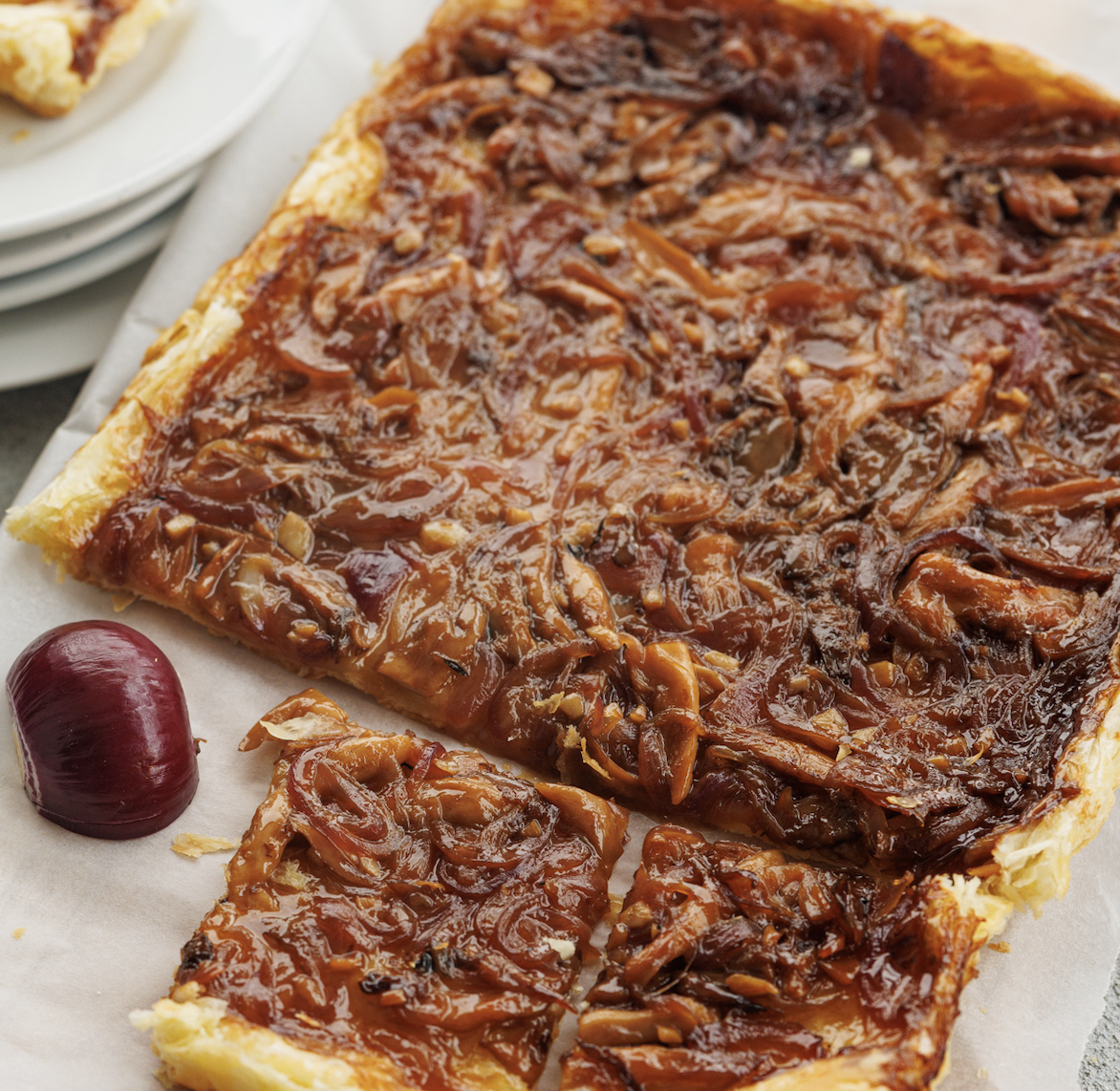
Caramelised red onion and mushrooms tart Tatin
Takes 37 minutes
Serves 6
Ingredients
- 250 g red onions
- 2 gloves garlic
- 150 g mushroom ideally oyster
- 2 tbs tamari or soy sauce
- 3 tbs maple syrup
- 1 tbs balsamic vinegar
- 15 g fresh thyme
- 200 g vegan cream cheese
- 1 sheet vegan puff pastry
Instructions
- If you are using frozen puff pastry ensure it is properly thawed first
- Preheat the oven to 180C.
- Peel and finely chop the onion (half moons work well) and garlic. Roughly chop the mushrooms into slices.
- Roughly chop the mushrooms into slices.Put a large wide bottomed frying pan on a medium heat and leave to warm up. Once it is hot, add 1 tbsp oil along with the onions, garlic and mushroom. Cook the veg for about 10-15 minutes stirring regularly until they start to char.
- In a bowl mix together the balsamic vinegar, maple syrup, tamari and whisk it together using a fork. Add to the veg and leave to reduce for a further 3 minutes.
- Remove from the heat and allow to cool slightly. Take the thyme leaves from the sprigs and add half of them to the veg and mix through.Line a medium sized baking tray (approximately the size of the sheet of puff pastry) with baking parchment.
- Transfer the cooked veg and spread out evenly. Fit the sheet of puff pastry to fit the size of the baking tray and carefully place on top tucking in any edges (if your tray is smaller than the puff pastry sheet you will need to cut it slightly)
- Put in the preheated oven and bake for 20-30 minutes until the pastry starts to golden up.
- Remove the dish from the oven, put a board that is slightly bigger than the pan on top of it and invert so that the pastry is now on the bottom and the cooked veg on top. Garnish with the remaining thyme leaves, slice and enjoy!
Nutrition
Video
The Happy Pear Podcast
Have you ever wondered what it would be like to be a nomad? To live on the road? Moving from one adventure to the next?
How about living on the road and raising a family? Something many of us would think is impossible! How would you educate your kids? Give them a sense of belonging and grounding? How would you finance this lifestyle? How would you retain friendships and community?
Episode 90
Four years ago, our friend Marty and his family did just this! They packed what they could, sold the rest and left their home in Seattle for a life of adventure and learning on the road with their three kids.
Instead of traveling to see places, they travel to find people! Building a network of creative and thoughtful families in fascinating places.
In this episode we catch up with Marty in person, he explains how the decision to do such a move came about, and how he has managed to keep it up for the last four years and convincing many others to follow suit. Establishing their own boutique travel agency, Quartier Collective, which leverages the network they have created into short and long group travel events for families all over the world, blending learning, community and exploration with a deep sense of curiosity and gratitude.
This episode will have you rethinking your next holiday, how you approach education, work and life balance. It will leave you with a whole new perspective on living as a family.
Lots of Love,
Dave and Steve x
Available now from all good podcast providers:
To find out more about Marty, his family and his travel agency check out their Instagram page: @quartiercollective
Produced by Sean Cahill and Sara Fawsitt
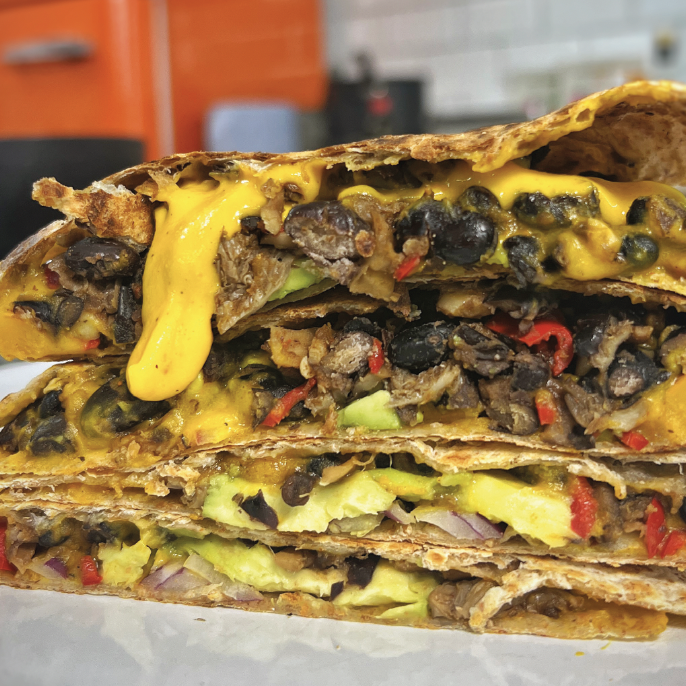
Cheesy Quesadillas
Takes 15 minutes
Serves 2
Ingredients
Nacho Cheese
- 140 g cooked pumpkin
- 60 ml sunflower oil
- 30 ml oat milk
- 1 tbsp lemon juice
- 1 clove garlic (finely sliced)
- ¾ tsp salt
- ½ tsp pepper
Meaty Mushrooms
- 200 g oyster mushrooms
- 2 cloves garlic
- 3 tbs tamari
- ½ tsp smoked paprika
- 1 tbsp maple syrup
- 1 tbsp ground coriander
- 2 tbsp water
- 400 g black beans
- 1 whole chilli (finely sliced)
Pickled Onions
- 1 whole red onion (finely sliced)
- 50 ml vinegar
- 50 ml water
- ½ tsp salt
For the Quesadillas
- 2 whole wheat tortillas
- 1 whole avocado
Instructions
- Make the mushrooms:Rip or slice the mushrooms into long chunky slices. Peel and finely dice the garlic. Heat a wide-bottomed pan over high heat, and once hot, add 1 tbsp of oil. Add in the mushrooms and compress with a clean pan to increase the sizzle and evaporate some of the water for a meatier texture. Leave to cook for 3-4 minutes until they start to brown on one side. Stir the mushrooms and add in the garlic, tamari, maple syrup, smoked paprika, and ground coriander. Mix through. Drain and rinse the black beans and add them to the pan along with ½ tsp of salt. Add 2 tbsp of water to deglaze the pan and incorporate any bits stuck to the pan.
- Pickle the onions:Peel and slice the red onion into long strips. Add to a glass with the vinegar, 50 ml of water (enough to submerge), and a pinch of salt. Leave to sit and pickle while you make the pumpkin cheese.
- Make the nacho cheese:Add the cooked pumpkin to a food processor along with the rest of the nacho cheese ingredients. Blend until super smooth. Taste and adjust to your liking, adding more water if needed to achieve a smooth but not too runny texture.
- Assemble the quesadillas:Cut the avocado in half, spoon out the flesh, and slice into long strips. Heat the pan back on medium heat and add a tortilla to the pan. On half of the tortilla, spoon on 2-3 tbsp of pumpkin cheese sauce, half of the mushroom and black bean mix, a few slices of avocado, and some pickled red onions. Drizzle with 2 tbsp of pumpkin cheese on top. Fold over the tortilla and cook on both sides until golden brown. Carefully remove from the pan onto a chopping board and slice in half. Repeat with the remaining tortilla and enjoy!
Nutrition
Video
The Happy Pear Podcast – Sam Corlett
On one sunny sunrise swim back in 2019, all the way from Australia to our lovely little island, we met the handsome Sam Corlett, the star of the latest Viking’s series Valhalla.
We approached this Viking-like being (he stood out from the rest of us Irish that’s for sure!) chatted and encouraged him to come join us for a swim again the next day, little did we know a pandemic would soon hit and this foreign man would enter our family circle and become more like a brother to us all.
Episode 89 – Sam Corlett
Fast forward 3 years and now Sam has hit the big screens, an international superstar. He’ the lead of his own Netflixs show and in many ways only at the beginning of his journey. We decided it was time to sit down the three of us and discuss it all, life, wisdom, his journey, how we met, what’s next and what makes his soul truly vibrate.
It’s so special to be able to share someones story who you are so close with, a beautiful conversation, we hope you enjoy it as much as we did.
Lots of Love,
Dave and Steve x
Available now from all good podcast providers:
This episode is sponsored by Vivobarefoot Footwear. Vivobarefoot Footwear have given our listenders an exclusive 20% discount when you enter the code HAPPYPEAR20
Genuinely these are the only shoes you will see Dave & Steve wearing!
Produced by Sean Cahill and Sara Fawsitt
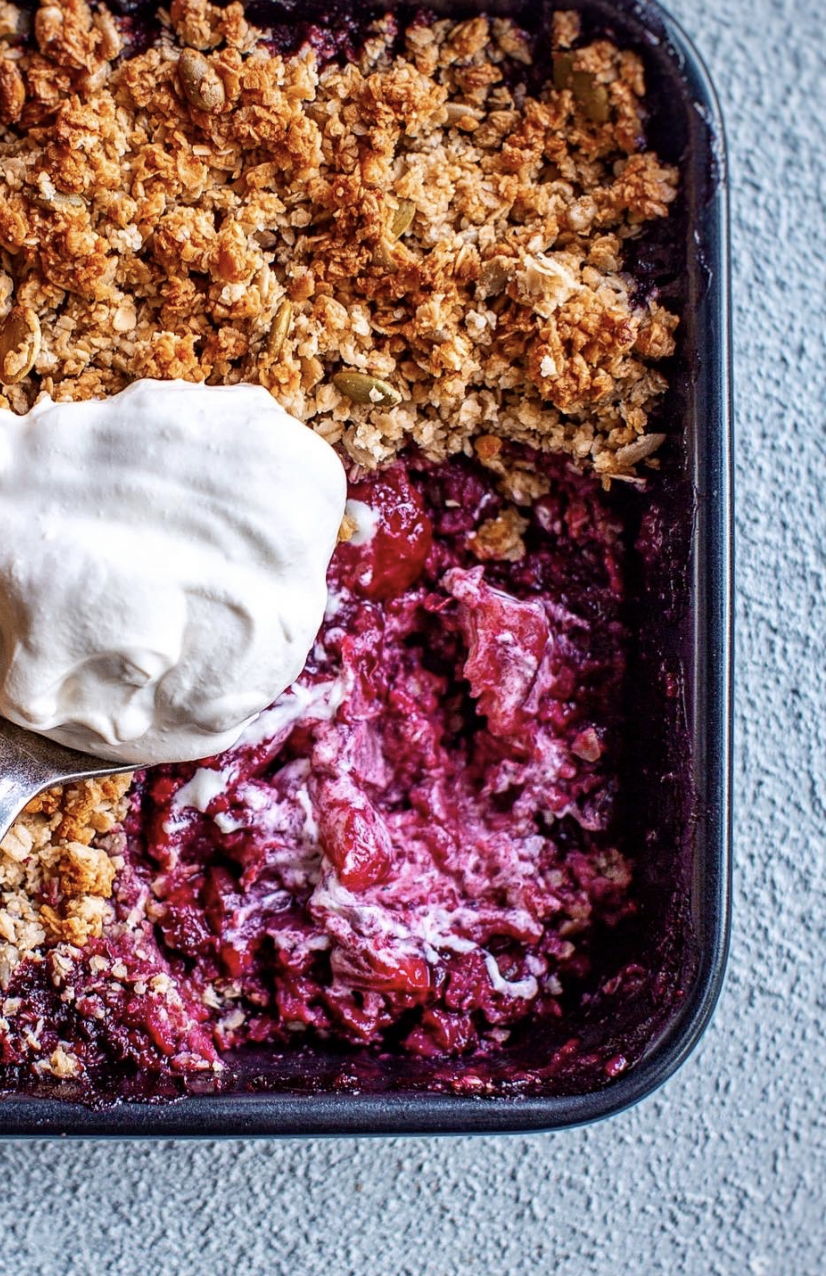
Apple, Pear & Blueberry Crumble
Takes 45 minutes
Serves 7
Ingredients
- 200 g oats
- 50 g desiccated coconut
- 50 g ground almonds
- 1 handful of nuts e.g., walnuts, almonds, or pecans
- 1 handful of seeds e.g., sunflower or pumpkin seeds
- 90 ml sunflower oil
- 90 ml maple syrup
- 1.5 kg apples and/or pears
- 100 g frozen blueberries
- 2 tsp ground cinnamon
- 1 tsp ground ginger
- 8 tbsp water
Instructions
- Preheat the oven to 180°C.
- Core and chop the apples and pears into bite-sized pieces, leaving the skins on. Place them in a pot with the frozen blueberries, water, cinnamon, and ginger.
- Bring the fruit mixture to the boil, then reduce the heat and simmer for about 20 minutes, stirring occasionally, until the fruit has softened and broken down.
- In a bowl, thoroughly combine all the crumble ingredients, including the oats, desiccated coconut, ground almonds, nuts, seeds, sunflower oil, and maple syrup, until well mixed.
- Transfer the stewed fruit mixture to a 30 cm crumble or ceramic dish, spreading it evenly. Evenly distribute the crumble topping over the fruit, then bake in the preheated oven for about 25 minutes or until the topping is golden.
Nutrition
The Happy Pear Podcast
“You can manifest anything as long as you are the driving force behind it.”
Have you heard of the number one best seller, Manifest: 7 Steps to Living Your Best Life by Roxie Nafousi? A book that will go down in history as one of those books that created a generational shift in perspective.
This week we had the pleasure of having Roxie on our podcast. A single mother, with a colourful past of drug abuse and self doubt who managed to turn her life around and manifest the life she wanted.
Episode 88 – Roxie Nafousi
“Generally speaking how we feel is a choice, we can choose how we feel and how we respond to the world, that’s not to say that it is always easy too, and it’s not saying you shouldn’t allow yourself to process and feel negative emotions, but you choose whether you indulge in them, process them and let them go and make a conscious decision to choose a more empowering perspective.”
Roxie Nafousi is a self-development coach, inspirational speaker, author, ambassador for the Mental Health Foundation and contributor to Kourtney Kardashian’s wellness platform, POOSH.
Roxie’s commitment to transforming lives and helping to empower others with the tools they need to fulfil their potential has seen her become a renowned and respected figure in the wellness world.
She has been named “The Manifesting Queen” by Forbes and “The A-Lists favourite manifestor” by The Sunday Times Style Magazine. A regular feature in many of the UK’s top publications, including British Vogue, Financial Times, The Times Magazine, Harper’s Bazaar & ELLE, to name a few, we caught up with her one Thursday morning to breakdown what it really means to manifest.
“It’s really important to get out of the victim mindset, and thats why the term manifestation can really rub people up the wrong way.”
A truly valuable episode for anyone out there, and a great reminder of how we can empower ourselves to get the best out of life.
We hope you enjoyed it as much as we did.
Lots of Love,
Dave and Steve x
Available now from all good podcast providers:
Get an exclusive 20% off the amazing online platform that is HEALF.com when you enter the promo code HEALTHYPEAR – Healf is where you will find only the best of the best health brands all vetted by their community and validated by experts. We love this platform, you can’t go wrong and it has all our favourite stuff covering the 4 pillars of heath: Eat Move Mind Sleep
Produced by Sara Fawsitt and Sean Cahill
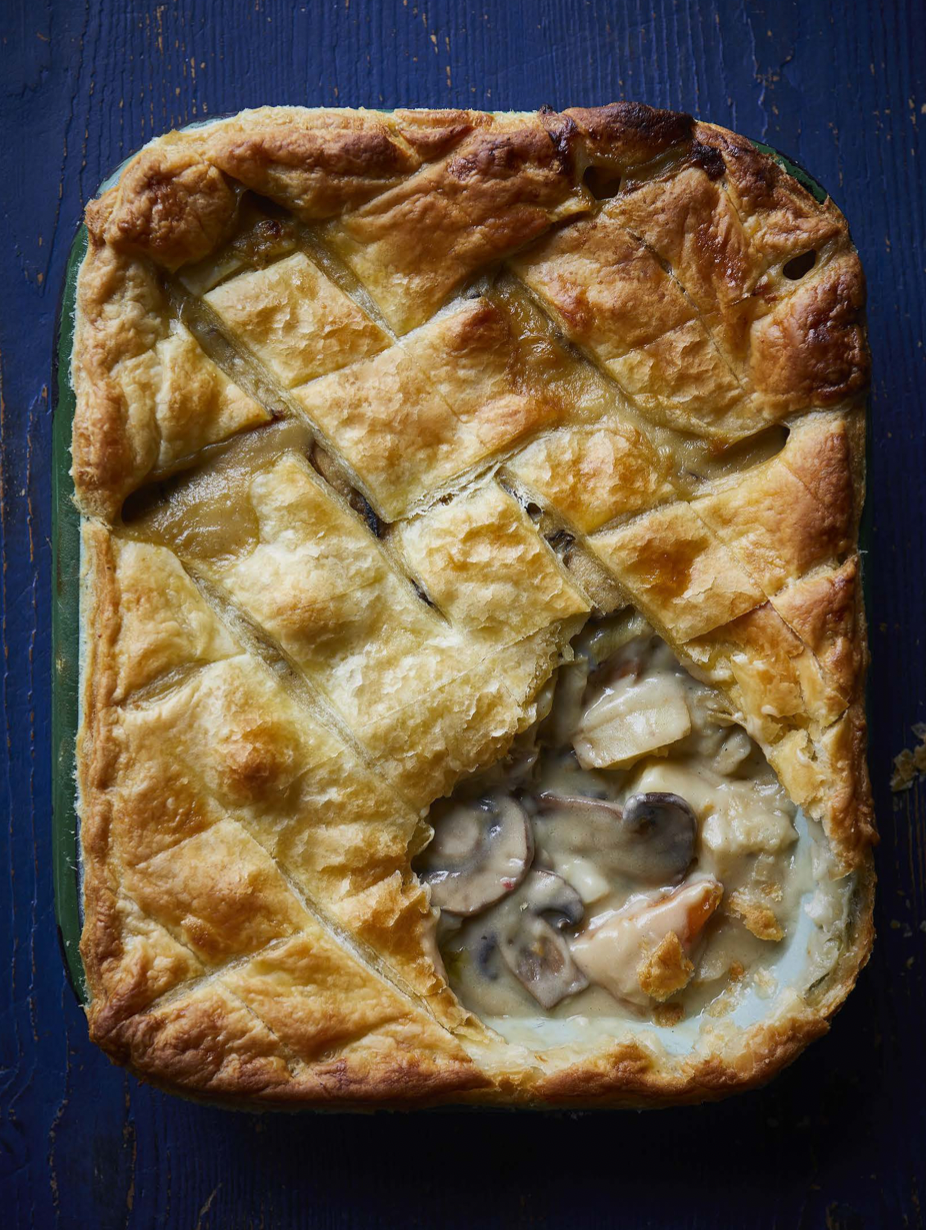
Creamy Mushroom Pie
Takes 50 minutes
Serves 6
Ingredients
- 320 g puff pastry defrost if frozen
- 400 g mushrooms thickly sliced
- 1 leek sliced into 1cm rounds (include green parts, thoroughly washed)
- 3 cloves garlic peeled and finely chopped
- 200 g sweet potatoes skin on, cut into 1cm pieces
- 200 g potatoes skin on, cut into 1cm pieces
- 1 tbsp Dijon mustard
- 8 tbsp olive oil for bechamel sauce
- 8 tsp plain flour
- 1 tsp garlic powder
- 800 ml oat milk plus extra for brushing
- Salt and black pepper to taste
Instructions
- Prepare the Puff PastryIf using frozen puff pastry, remove it from the freezer to defrost to room temperature.
- Preheat the OvenPreheat the oven to 200°C (fan)/220°C/gas 7.
- Cook the Mushrooms and GarlicHeat 1 tablespoon of oil in a wide-bottomed non-stick pan over high heat.Once hot, add the mushrooms and fry for 4–5 minutes until they begin to colour. Add the garlic and fry for another 2 minutes.Remove from the pan and set aside.
- Cook the VegetablesUsing the same pan, add the sweet potatoes, potatoes, leeks, and 1 teaspoon of salt. Stir well and cook for 5 minutes, stirring regularly.Reduce the heat to low-medium, cover with a lid, and let the vegetables steam in their own juices for 10 minutes or until the potatoes and sweet potatoes are tender.Remove the lid, turn off the heat, and stir the cooked mushrooms back into the pan along with the Dijon mustard.
- Make the Bechamel SaucePlace a medium saucepan over high heat. Once hot, add the 8 tablespoons of oil.Sift in the flour and whisk continuously, cooking for 1 minute to remove the raw flour taste.Add 2 teaspoons of salt, 1/4 teaspoon black pepper, and the garlic powder. Gradually add the oat milk while whisking continuously.Bring the mixture to a boil, then reduce to a simmer for 3–4 minutes until it thickens to a creamy consistency. Taste and adjust seasoning with more salt, pepper, or a squeeze of lemon juice if desired.
- Combine and Assemble the PiePour the bechamel sauce into the pan with the mushroom and vegetable mixture. Stir well to combine.Transfer the filling to a 20 x 30cm casserole or pie dish and let it cool for 30 minutes.
- Prepare and Add the Pastry ToppingRoll out the puff pastry on a lightly floured surface and cut it to fit the top of the pie dish.Gently score the top in a criss-cross pattern and place it over the filling. Use a fork to crimp the edges around the dish.Brush the top of the pastry with a little extra oat milk for a golden finish.
- BakeBake in the preheated oven for 25 minutes or until the pastry is golden and crisp.
- ServeServe warm. This pie pairs wonderfully with a green salad or, during colder months, with roasted potatoes.
Nutrition
Video
The big mushroom debate is about cleaning them. Some chefs never wet mushrooms, as they
believe they become soggy and lose some of their absorbent properties, while others recommend
brushing or cleaning them with a dry cloth. If you are going to wash your mushrooms in water, don’t
soak them. Instead, think of dunking them like you would a biscuit in a cup of tea, or wipe them with
a damp cloth. For our creamy mushroom pie, we just wipe them with a cloth!
Choose firm mushrooms that are not too spongy, and where relevant and possible turn the
mushrooms upside down and have a look at their gills, which should be dry and firm. Avoid any
mushrooms that are wet or soggy or woody. In terms of storing, it is best to remove the mushrooms
from any plastic packets, if this is how you bought them, as this can cause condensation and make
them go soggy. Store them in the fridge in a paper bag. Some people put their mushrooms in the
sun to absorb more vitamin D; however, if left too long in the sun they will dry out and become
woody. Alternatively you can spend 20 minutes outside in direct sunlight and you will generally get
all your vitamin D requirements for the day.
Mushrooms can be foraged, and it is something that we love to do. We remember having such fun
with our friend Nick in Devon, hunting for turkey tail and chicken of the woods mushrooms, but you
should only do it with someone who is qualified and knows the different varieties, as there can be many poisonous mushrooms.
The Happy Pear Podcast
A REFLECTION ON THE MEANING OF LIFE
His life is soon to be a Hollywood feature film, this is our second recording with the wonder that is John Mcavoy.
Last episode was such hit, we had to get him on again!
What a character and inspiring human being, to go from serving life in the highest security prison at the age of 22 for armed robery to a complete switch! Now an ultra athlete who recently turned Vegan!
Episode 87 – John Mcavoy
Last episode we went though his full back story, a breath taking story that leaves you hanging on his every word.
Since then we have become good friends, and in this episode we manage to go much deeper with John, into his philosophies of life, what keeps him ticking, his next adventures and how he now approaches sports after years of being an endurance athlete.
What an infectious character with an amazing outlook on life we can all learn from.
Enjoy!
Lots of Love,
Dave & Steve
Available now from all good podcast providers:
This episode is sponsored by Vivobarefoot Footwear. Vivobarefoot Footwear have given our listenders an exclusive 20% discount when you enter the code HAPPYPEAR20
Genuinely these are the only shoes you will see Dave & Steve wearing!
Produced by Sean Cahill and Sara Fawsitt
An EPIC burrito. are so incredible tasty and the type of meal you feel sad once you have finished as it was so good! This burrito consists of 5 components here which might sound like a lot but trust us it is so worth it!
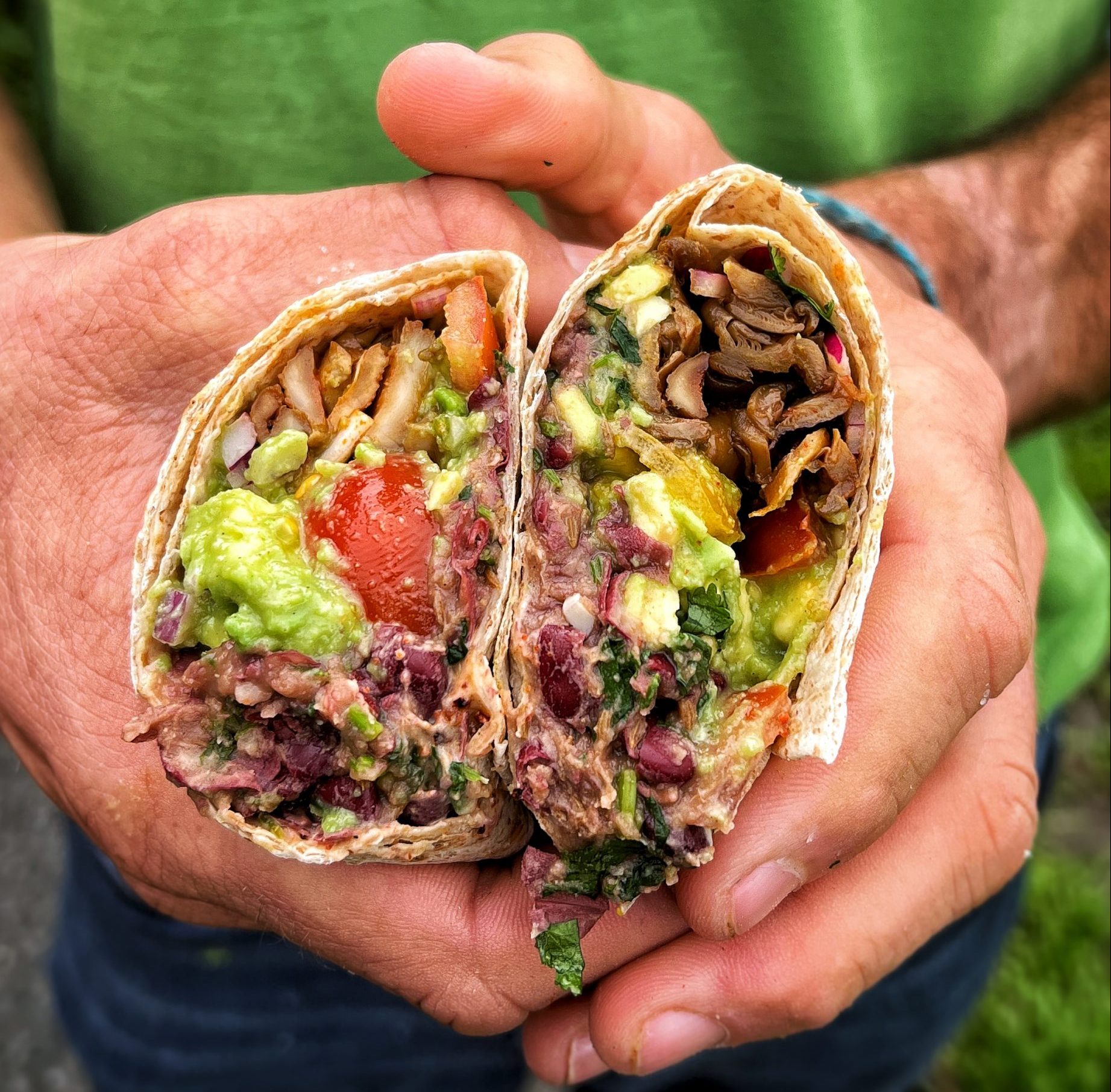
10 Minute Epic Burrito
Takes
Serves 2
Ingredients
- 1 red onion thinly sliced
- 50 ml apple cider vinegar
- 1 tin kidney beans
- 2 cloves garlic
- 1 lime juice
- 10 g coriander
- 1 tsp ground coriander
- 1 tsp ground cumin
- 1 tsp cumin seeds
- 1/2 tsp salt
- 1/2 tsp pepper
- 200 g oyster mushrooms
- 2 tbps tamari soy sauce
- 1 tbs maple syrup
- 1/2 tsp smoked paprika
- 1 avocado ripe
- 6 cherry tomatoes
- 1/4 red onion finely chopped
- 1 tsp ground cumin
- 1/2 lime juice
- 1/2 tsp salt
- 1/2 tsp pepper
- 4 tbsp vegan mao
- 1 tbsp korean chilli powder
- 3 wholemeal wraps
Instructions
- First step make the pickled red onion – Finley slice the red onion into half moon slices, add to a glass and add the vinegar and fill with water until all the onions are submerged.
- Slice the mushrooms into thin slices. Heat a non stick pan on high heat and add 1 tbsp of oil. Once hot add the mushrooms and the smoked paprika and mix well, leave to cook for 5 mins. Add the tamari and the maple syrup and mix well so that they are well spread. Taste and adjust the seasoning to you liking. Remove from the heat.
- For the guacamole, remove the flesh of the avocado and slice into small cubes, quarter the cherry tomatoes and add in, and finely dice the red onion, squeeze in the lime and add the salt, black pepper and ground cumin. Using a fork bring together and mash to your desired texture, some like it smooth and others like it chunky. Taste and adjust the seasoning to your liking.
- For the refried beans, peel and finely dice the garlic cloves, drain and rinse the kidney beans, heat the same pan from the mushrooms and add 1/2 tsp of oil, once hot add the garlic, cumins seeds and beans and 2 tbsp of water and mix well ensuring to encorporate any of the sauce from the mushrooms. Finely dice the fresh coriander. Cook for 2-3 mins and add in the juice of the lime, the ground cumin, ground coriander, salt and black pepper and mix through. Use the back of the wooden spoon to mash the beans until it comes together. Add in the fresh chopped coriander and mix through, taste and adjust the seasoning to you liking.
- For the spicy mayo just add the mayo to a small bowl and mix in the chilli powder.
- To roll your buritto, add the mayo on the bottom, followed by the refried beans, guacamole, mushrooms and finish with some pickled red onions – roll up and enjoy!
Nutrition
Dave & Steve x
Eat a lot of chickpeas? Throwing out the water they sit in? STOP what you’re doing and try this recipe. It’s so delicious, so easy and zero waste. We absolutely love this recipe hack! 5 minute chocolate mousse, let’s do it!
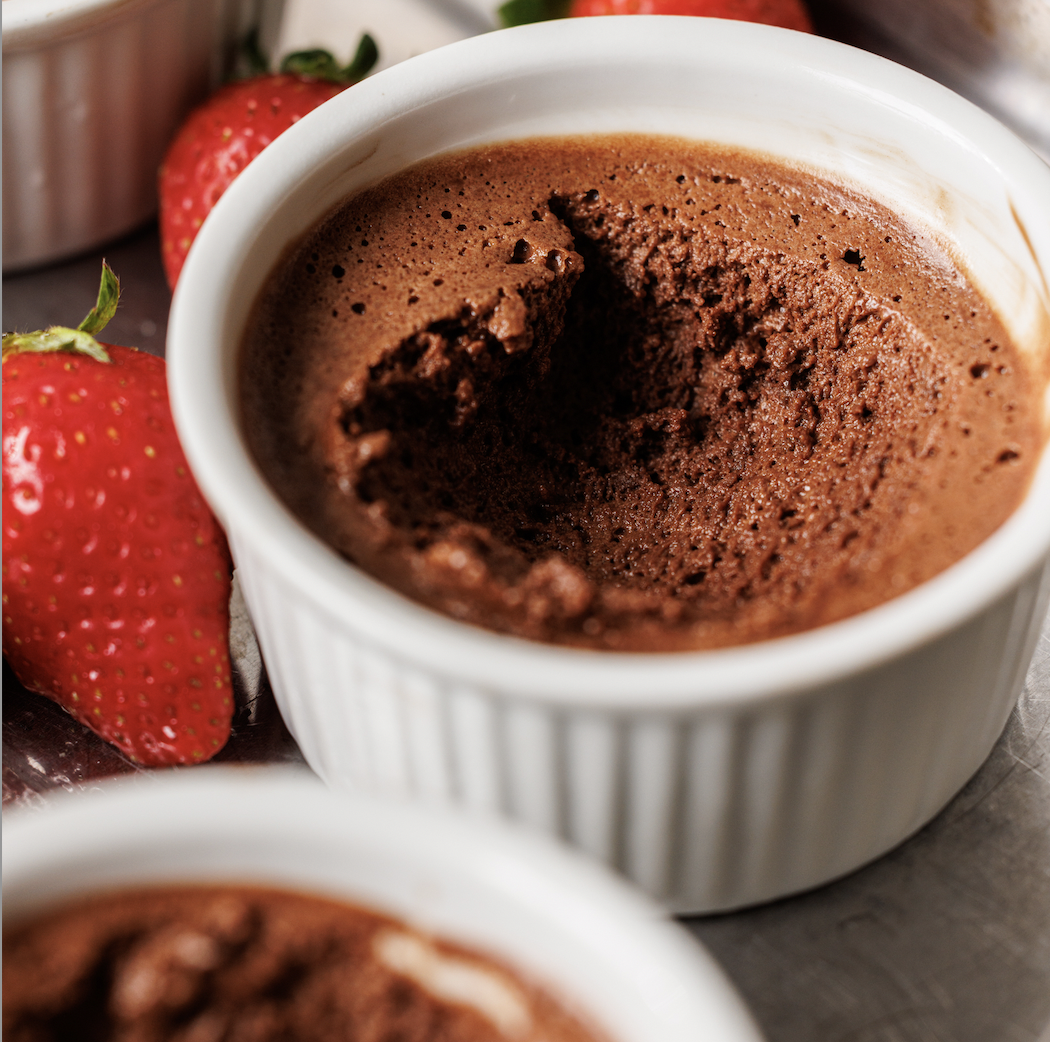
5 Ingredient Chocolate Mousse
Takes
Serves 6
Ingredients
- 150 ml Aquafaba drained chickpea water
- 150 g dark chocolate
- 3 tbsp caster sugar
- 3-5 drops fresh lemon
Instructions
- Drain your chickpeas and pour the drained water into a clean bowl. Any grease will prevent your Aquafaba from whipping up! Pop the chickpeas in your fridge for another meal…
- With an electric whisk, whisk the Aquafaba on a slow speed, gradually increasing until it's on high. Add the few drops of lemon juice to help the Aquafaba stabilise and whisk even quicker. Whisk the Aquafaba for about 3 minutes until it's made stiff peaks and doesn't shift in the bowl. At this point, add in your sugar, one tablespoon at a time and continue whisking until you have a thick, glossy, meringue like texture.
- Melt your chocolate over a bain-marie and once the chocolate has completely melted, take it off the heat.
- Add one third of the Aquafaba mixture into the hot chocolate and mix well. Slowly fold in the rest of the Aquafaba mixture with a spatula. Do this carefully so the mousse doesn't deflate.
- Transfer into ramekins and pop in the fridge to set!
Nutrition
Video
We love Aquafaba. It’s really magic in the way it whisks up just like an egg white does and as you know, we eat a lot of chickpeas so we tend to have a lot of Aquafaba knocking about and it’s a great way to reduce waste. People tend to think that Aquafaba is meant for meringues, but the truth is, it does so much more. It has similar protein levels to egg whites so they whip up in very similar ways.
We have taken a very traditional mousse recipe and replaced the egg white with Aquafaba and it’s worked perfectly. It’s so fluffy, it’s almost like a cloud.
We also love Aquafaba, because it can’t be over-whipped. This means if you have a hand free stand, you can leave it to whisk up and focus on melting your chocolate.
Aquafaba chocolate mousse, you’ll never throw away chickpea water again!
Dave & Steve x
Top tip: If you want to keep your Aquafaba but don’t think you’ll need it any time soon – it freezes amazingly. We pour the water into an ice-cube tray and take it out when we need it. It works just as well…just let it defrost!
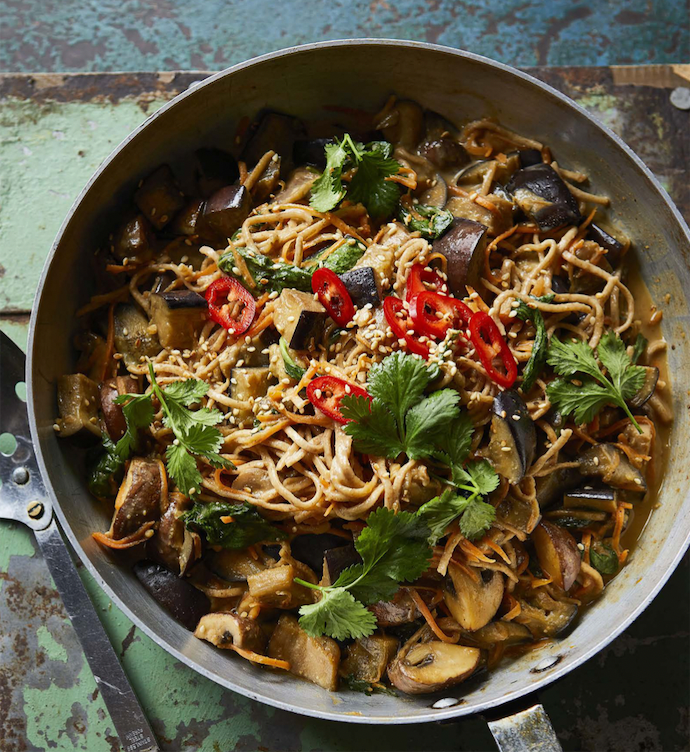
Chilli Peanut Noodles
Takes
Serves 2
Ingredients
- 300 g wholewheat noodles
- 1 large aubergine
- 200 g mushrooms of choice
- 1 whole carrot
- 5 tbsp soy sauce
- 4 tbsp maple syrup
- 3 tbsp apple cider vinegar
- 4 tbsp peanut butter
- 1/2 tsp chilli powder
- 50 g baby spinach
Instructions
- Cook the noodles in a pan of boiling water according to the instructions on the packet, then drain and rinse.
- Chop the aubergine and mushrooms into small, bite-sized pieces and grate the carrot. Heat a large, wide-bottomed pan on high and add 2 tablespoons of olive oil. Once hot, add the aubergine and mushrooms and cook for 8 minutes, stirring regularly. If they start to stick, add 2 tablespoons of water and use a wooden spoon to deglaze any caramelisation from the bottom of the pan.
- In a jug, mix the soy sauce, maple syrup, vinegar, peanut butter, chilli powder, 6 tablespoons of water, and 1/2 teaspoon of black pepper until smooth. Reduce the heat to medium and add half of the sauce to the aubergine and mushrooms. Cook for another 4 minutes, stirring regularly.
- Add the noodles, baby spinach, grated carrot, and the remaining sauce to the pan. Stir in a circular motion to mix everything together and cook for 2 minutes.
- Remove from the heat and adjust the seasoning to your liking. Add more chilli if you like it spicy, and enjoy!
Nutrition
Video
The goodness behind our Chilli Peanut Noodles…
Aubergines are high in fibre and water, and low in calories. Most people don’t get their recommended daily intake of fibre, in fact
of the recommended 30g a day most people are only eating 18g. Fibre traditionally was just associated with being beneficial for
digestion, but in the recent decades it has also been found to be a prebiotic, which is the food that the bacteria in our
microbiome feed upon and that encourages more of the beneficial microbes to grow as opposed to the less beneficial ones.
Differently, mushrooms are a good source of essential B vitamins and other immune-supporting nutrients such as selenium.
White button mushrooms can be one of the few plant food sources of vitamin D, which is important for calcium absorption,
immune function, heart health and protecting bone health. They have also been linked to helping improve cardiovascular function, and even help protect against cancer.
80g of mushrooms, 14 baby button mushrooms, 4 large closed cup mushrooms or1 large flat mushroom is considered to be one of your 5-a-day.
If y.
Dave & Steve x
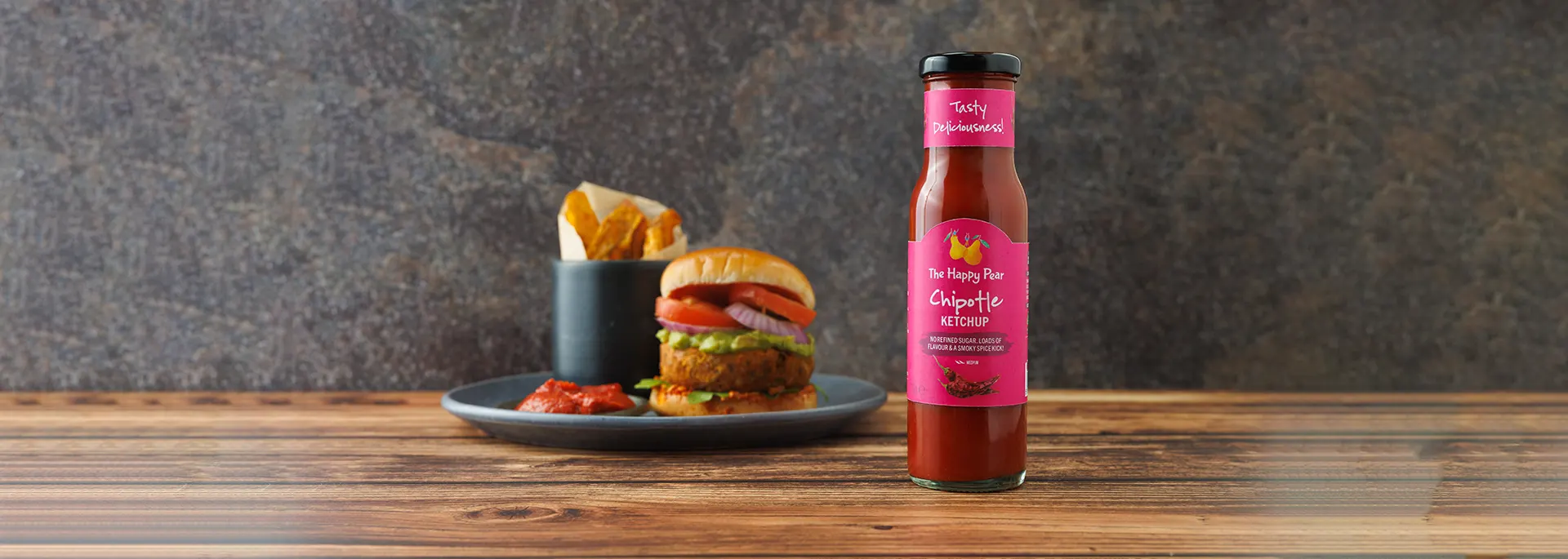
INGREDIENTS
Tomato* (54%), Grape Juice, Onions, Spirit Vinegar, Irish Cider Vinegar, Corn Starch, Bramley Apples, Salt, Chipotle Flakes (0.4%), Spices, *Made with 153g of Tomatoes per 100g of Ketchup
ALLERGEN INFORMATION
For allergens incl. Cereals containing Gluten, see ingredients highlighted.
NUTRITIONAL INFORMATION
| Typical | per 100g |
|---|---|
| Energy | 407kJ / 96kcal |
| Fat | 0.5g |
| Of which Saturates | 0.1g |
| Carbohydrates | 20.0g |
| Of which Sugars | 16.0g |
| Fibre | 1.4g |
| Protein | 2.2g |
| Salt | 1.2g |
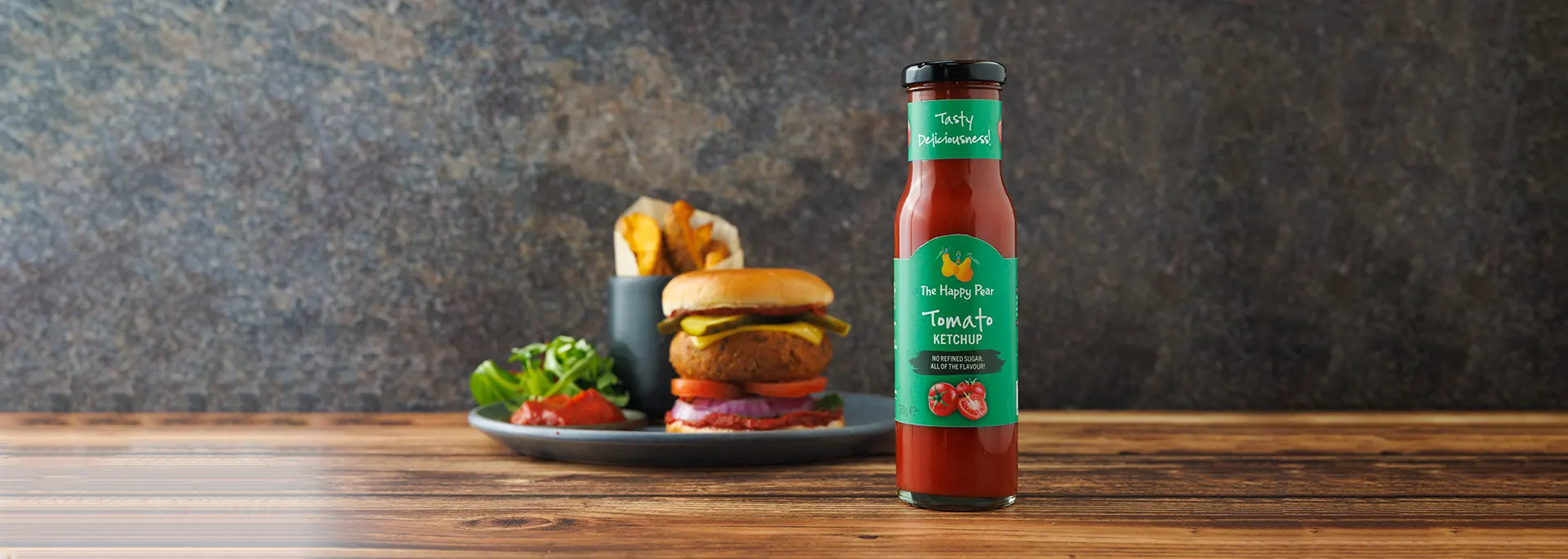
INGREDIENTS
Tomato* (60%), Grape Juice, Irish Cider Vinegar, Corn Starch, Spirit Vinegar, Salt, Lemon Juice, Spices, *Made with 174g of Tomatoes per 100g of Ketchup
ALLERGEN INFORMATION
For allergens incl. Cereals containing Gluten, see ingredients highlighted.
NUTRITIONAL INFORMATION
| Typical | per 100g |
|---|---|
| Energy | 469kJ / 111kcal |
| Fat | 0.5g |
| Of which Saturates | 0.2g |
| Carbohydrates | 24.0g |
| Of which Sugars | 18.0g |
| Fibre | 1.3g |
| Protein | 1.9g |
| Salt | 1.4g |
The Happy Pear Podcast
Known as a ‘teacher of teachers’, this week we had the pleasure of speaking to Gary Gorrow, a Vedic Meditation Teacher, a Qualified Ayurvedic Health Coach, Mindfulness Expert and the Creator/Director of SOMA, a world class retreat in Byron Bay.
Episode 86 – Gary Gorrow
“Self hate is so deeply ingrained in us.”
Gary is passionate about empowering people with techniques that enable them to re-engineer their lives inside and out. His approach synthesises the best of modern science and ancient consciousness based practices. His students come from a range of backgrounds and include Google, GWS Giants, celebrities, CEO’s, health practitioners, athletes, entrepreneurs, creatives, grandparents and children.
This episode was a brilliant reminder for us to why we started on our meditation journey so many moons ago. Gary is truly a teacher of teachers, we hope you enjoy this episode as much as we did!
Lots of Love,
Dave & Steve
Available now from all good podcast providers:
Get an exclusive 20% off the amazing online platform that is HEALF.com when you enter the promo code HEALTHYPEAR – Healf is where you will find only the best of the best health brands all vetted by their community and validated by experts. We love this platform, you can’t go wrong and it has all our favourite stuff covering the 4 pillars of heath: Eat Move Mind Sleep!
Produced by Sara Fawsitt and Sean Cahill
We would love to hear your feedback! Write to us at podcast@thehappypear.ie and we will read out selects in the intro of each episode.
The Happy Pear Podcast
In this episode Russell breaks down the biological clock and circadian rhythm, why certain people are morning people vs night owls, how waking up in the night isn’t necessarily a bad thing, how sleep and mental health are linked, how morning light vs evening light effects us and how different types of work could go against our sleep requirements.
Episode 85 – Russel Foster
“Most people don’t have a sleeping problem, they have an anxiety problem”
Born in Aldershot in 1959, Russell Foster is an award winning professor of circadian neuroscience at Oxford and the director of the Nuffield Laboratory of Ophthalmology.
For his discovery of non-rod, non-cone ocular photoreceptors he received numerous awards including the Zoological Society scientific medal. He has written numerous books, his latest being – Life Time: The New Science of the Body Clock, and How It Can Revolutionize Your Sleep and Health.
According to Russell, when it comes to sleep one glove does not fit all. The notion that we need “8 hours of sleep per day” to be healthy is nonsense says Russell. There are numerous factors that interplay to create a good nights sleep and each one of us is unique to the other.
Russell wants to remove the anxiety associated with sleep and get down to the root of why we sleep the way we do.
“To understand if you are getting enough sleep the first thing is to ask yourself are you not feeling able to function optimally during the day? Do you need an alarm clock? Does it take you a long time to get up? Do you feel sluggish? Do you need caffeine? Do you need a nap? On your time off do you oversleep? Are you irritable? It’s listening to our bodies! And listening to it carefully as the tired brain can delude itself to think that it’s not tired.
In this episode Russell breaks down the biological clock and circadian rhythm, why certain people are morning people vs night owls, how waking up in the night isn’t necessarily a bad thing, how sleep and mental health are linked, how morning light vs evening light effects us and how different types of work could go against our sleep requirements.
He really covers it all and will put you at ease if you consider yourself someone who struggles with sleep.
A fascinating episode – Enjoy!
Lots of Love,
Dave & Steve
Available now from all good podcast providers:
We would love to hear your feedback! Write to us at podcast@thehappypear.ie and we will read out selects in the intro of each episode.
Checkout Vivobarefoot Footwear and avail of 20% discount when you enter the code HAPPYPEAR20 – Genuinely the only shoes you will see Dave & Steve wearing!
Produced by Sara Fawsitt and Sean Cahill
The Happy Pear Podcast
We have come to the end of our series of mash-up episodes, and what better way to go out with a bang than with an episode like this!
An incredibly important topic. That as a man I (Stephen here) am ashamed to say is not taken more seriously…
Episode 84 – Female Hormones
We have had a number of female health specialists on our podcast, from period pains, menopause, perimenopause to fertility. And what we found amazing is how complex it all is, and perhaps polarising?
Should you take the pill, should you not? Should you take HRT, should you not? Should you eat differently to a man? Should you exercise in the same way a man does? The list goes on…
There are many different opinions and the one thing we have come to the conclusion is that not all the information is made easily available to women so they can make informed choices for themselves…
It also makes you wonder are we lacking in the full picture, why does women’s health bring up so many opposing opinions?
So today I would like to bring you on a journey, a journey all about hormones and women’s health and what we know from the studies that have been done. We have taken extracts from some of the female experts we have had to date on this podcast, and broken down the potential health risks, symptoms, natural remedies and medical interventions that could massively improve a female’s life and in some cases even prevent much more serious health risks.
We hope that after listening to this episode, you, as a woman, can feel much more informed to make the right choices when it comes to hormones. Or to any men listening you gain a better understanding of what a female has to go through and can be better support for your mothers, sisters, daughters, friends and colleagues. This really is an episode for everyone!
And if you have any feedback for us please email in on podcast@thehappypear.ie
Such an important topic, enjoy!
Lots of Love,
Dave & Steve x
Available now from all good podcast providers:
We would love to hear your feedback! Write to us at podcast@thehappypear.ie and we will read out selects in the intro of each episode.
Checkout Vivobarefoot Footwear and avail of 20% discount when you enter the code HAPPYPEAR20 – Genuinely the only shoes you will see Dave & Steve wearing!
Produced by Sara Fawsitt
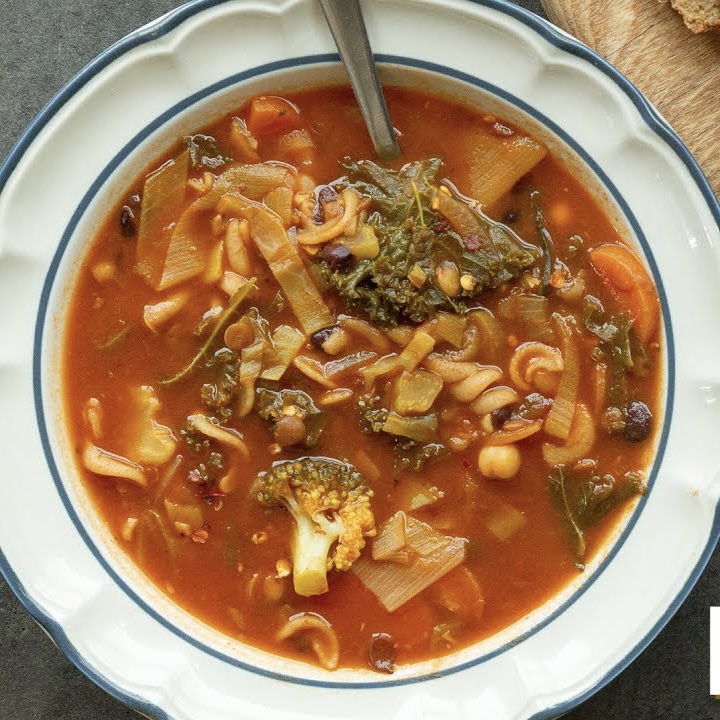
Wholefood Immune Boosting Ikarian Stew No Oil – for weight loss –
Takes 50 minutes
Serves 10
Ingredients
- 2 onions
- 3 cloves of garlic
- 2 carrots 150g
- 2 leeks 400g
- 1 x 400g tin blackbeans beans – 240g drained – cannellini/ haricot
- 1 x 400g tin of cooked chickpeas – 240g drained
- 1 x 400g tin of cooked lentils – 240g drained
- 150 g dry wholemeal pasta we used fusilli
- 200 g broccoli
- 100 g kale
- 1 x 680g tin chopped tomatoes
- 100 g tomato paste
- 2 tablespoons tamari
- 2.5 litres of veg stock
- ½ tsp black pepper
Instructions
- Peel and finely dice the onion and garlic. Cut the leeks in half lengthwise and then into 2cm rounds, finely slice the carrots. Cut the broccoli into small florets and ensure to use all the stalk. Drain and rinse the cooked beans and lentils tins. Remove the kale from the stalk and finely chop the stalk.
- Heat a large pot on high heat. Once hot add the onion and garlic and cook for 3-4 minutes stirring regularly. If it starts to stick add 2 tbsp of veg stock and loosen. Once they start to brown slightly add the chopped leak, carrots, broccoli stalk, kale stalk and a generous pinch of salt and 50ml of veg stock and put the lid on and leave to sweat for 10 mins stirring occasionally.
- Next add the rest of the ingredients, (the tins beans and lentils, tomato passata, tomato puree, tamari, veg stock, pasta and kale). With the lid on bring to the boil and reduce to a low heat and simmer for 10 mins. Taste and adjust the seasoning to your pallet and add some chilli flakes if you like it spicier
- Serve with some fresh bread for a super-nourishing meal!
Video
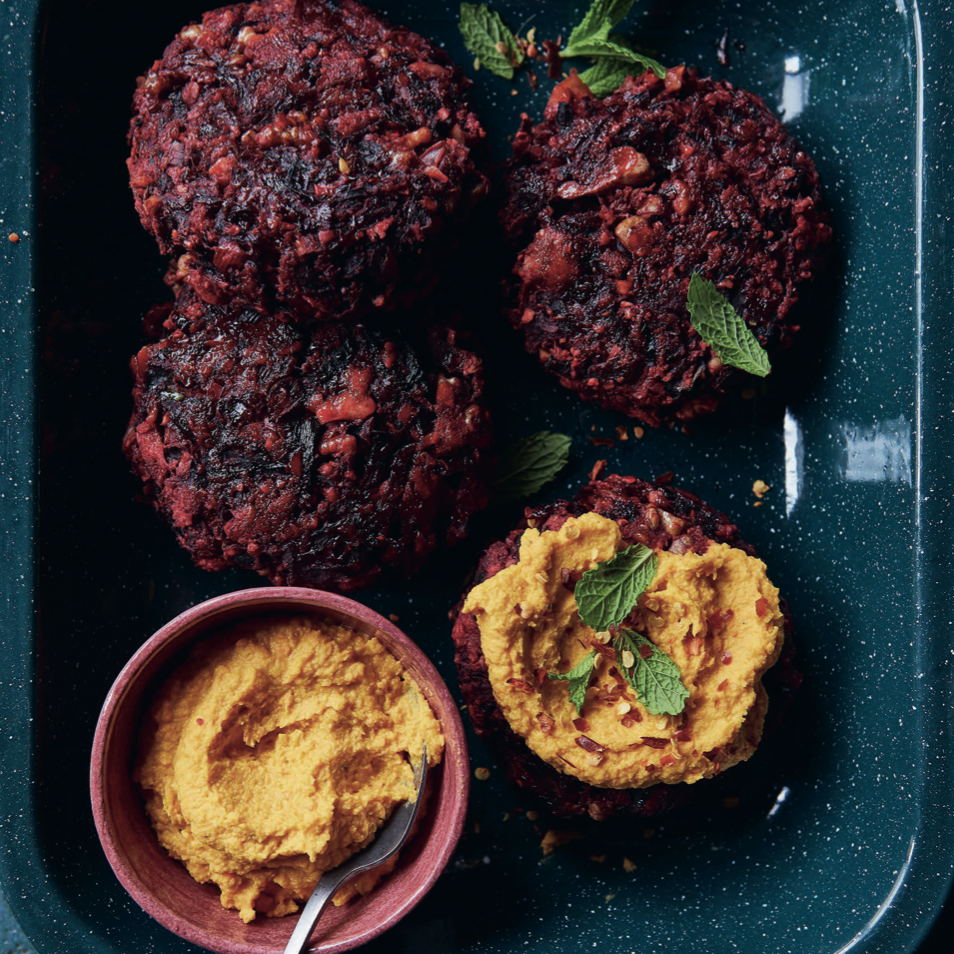
Beetroot & Walnut Burgers
Takes 45 minutes
Serves 2
Ingredients
- 60 g 2.1 oz cashew nuts
- 400 g 14 oz uncooked beetroot (beet)
- 140 g 4.9 oz walnuts
- 80 g 2.8 oz vegan cheddar cheese
- 20 g 0.7 oz fresh mint
- 10 g 0.35 oz firm tofu
- Juice of 1 lemon
- 100 g 3.5 oz fresh breadcrumbs
- 150 g 5.3 oz The Happy Pear Happy Hummus or The Happy Pear Reduced Fat Hummus
Instructions
- Preheat the Oven: Preheat the oven to 180°C (356°F) fan/200°C (392°F)/gas 6. Line two baking trays with parchment.
- Soak the Cashew Nuts: Place the cashew nuts in a bowl and cover with boiling water, then leave to soak for 10 minutes.
- Prepare the Beetroot: Wash the beetroot thoroughly, peel and grate into a bowl.
- Toast the Walnuts: Roughly the walnuts, spread on a tray, and toast in the oven for 6–7 minutes. Once done, set aside to cool.
- Cook Beetroot Mixture: Use a pan over medium heat, add the grated beetroot, and sauté with a pinch of salt for 4–5 minutes. Transfer to a bowl to cool.
- Prepare Cheese and Mint: Grate the vegan cheddar cheese and finely chop the fresh mint.
- Create Cashew Cheese: Drain the cashews and blend with tofu, some oil, half of the lemon's juice, and a dash of salt and pepper until smooth.
- Combine Burger Mixture: In the beetroot bowl, mix in the cashew cheese, grated cheese, toasted walnuts, breadcrumbs, remaining lemon juice, chopped mint, and seasoning.
- Shape and Bake Burgers: Form the mixture into 6 burgers and bake for 25 minutes on the prepared tray.
- Serve: Once baked, serve the burgers with hummus on top or on the side.
Nutrition
Video
When we first created our Beetroot, Walnut and Feta Burgers, you all loved them. So, with the dream of making them as easy as possible, we returned to the drawing board. They needed to still pack a punch, but only use 10 ingredients or less. We think the cashew feta cuts through the sweet beetroot just perfectly and makes the burgers so indulgent, if you fancy a big feast. This recipe also goes incredibly well with a pesto, much like our spicy red pepper pesto, just smeared on top before adding whatever toppings you fancy.
If you have any stale bread in your kitchen that you don’t want to throw out, this is the perfect excuse to whizz them up in a blender or even use a grater and make your own bread crumbs. Equally you can swap out whatever herbs you have, for mint. We think mint, feta and beetroot are a match made in heaven, but we’ve used basil and coriander in the past and they’ve turned out delicious.
Beetroot Benefits: Beetroot is packed with antioxidants, evident from its bright red colour. When we first opened our juice bar, our aprons and hands used to be stained pink from juicing fresh beetroots. A simplistic way to think of antioxidants and their benefits for the body is that another name for rust is oxidation, so antioxidants help slow down the build-up of ‘rust’ in our body by slowing down cellular degradation. Research published in the journal Nutrients showed that eating beetroot can help dilate blood vessels because of its dietary nitrates, enhancing our physical performance.
It really is a winner, this dish. If you want to see how we make it, step-by-step, click our video below. It really is so simple and so
delicious. If you have any questions about this dish, feel free to drop a message below and we’ll get straight back to you.
Dave & Steve x
The Happy Pear Podcast
Think of an argument or confrontation you had last year – What do you remember more? What context of what was said or how the argument made you feel?
The last time you were with a family member or a friend – where you fully present or on your phone or distracted at all?
How much of your time do you spend on tasks, activities and with people that align with your values and your happiness?
Episode 83 – 3 Life Lessons
Welcome to this week’s podcast mash-up, where we take you on a slightly different journey…
A journey of self-improvement. Dave has taken exerts from 3 of his favourite podcast guests (so far) and put them into this one episode for you. Curating them into 3 lessons, that we believe will be super beneficial to you and anyone else you know!
So sit back, listen, take note and let us know if you got as much out of it as we did!
And if you have any feedback for us please email in on podcast@thehappypear.ie
Lots of Love,
Dave & Steve x
Available now from all good podcast providers:
We would love to hear your feedback! Write to us at podcast@thehappypear.ie and we will read out selects in the intro of each episode.
Checkout Vivobarefoot Footwear and avail of 20% discount when you enter the code HAPPYPEAR20 – Genuinely the only shoes you will see Dave & Steve wearing!
Produced by Sara Fawsitt
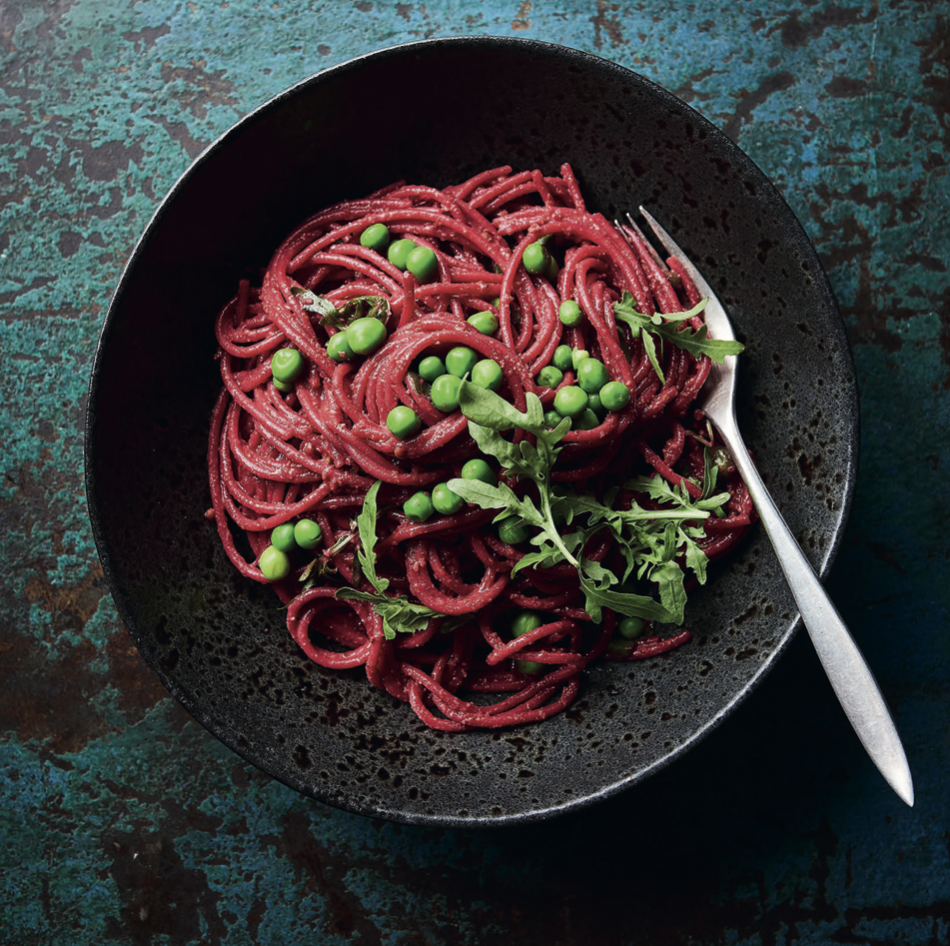
Beetroot Pesto Pasta
Takes 35 minutes
Serves 4
Ingredients
- 200 g uncooked beetroot
- 400 g dried wholemeal spaghetti or penne pasta
- 130 g pine nuts
- 100 g frozen peas
- 1.5 cloves garlic
- 2 tbs balsamic vinegar
- 30 g rocket
Instructions
- Preheat your oven to 200°C fan.
- Wash the beetroot and remove any dirt and blemishes, then roughly chop into bite-sized pieces. Place them on a baking tray, sprinkle with a pinch of salt, and drizzle with olive oil. Bake for 20–30 minutes, or until well roasted and slightly charred around the edges.
- Bring a medium saucepan of water to the boil, add 1 tablespoon of salt, and cook the pasta according to the packet instructions.
- Toast the pine nuts in a dry frying pan over high heat for 5 minutes, stirring regularly until golden. Remove from the heat and set aside.
- Drain and rinse the pasta, reserving some of the pasta water. Place the peas in a bowl, pour over the pasta water, and leave them to sit for 5 minutes. Then, drain and rinse the peas.
- Peel and chop the garlic, and place it in a food processor with the roasted beetroot, balsamic vinegar, olive oil, and 1 teaspoon of salt. Blend until smooth. Add the pine nuts and pulse until they’re broken up but still slightly chunky for texture.
- To assemble, put the cooked pasta into a large pan and add half the beetroot pesto, half the peas, and the rocket. Stir together and warm over medium heat for 2–3 minutes, stirring regularly. Save the remaining pesto for another pasta dish or as a sandwich spread.
- Divide between 4 bowls and serve with the remaining peas scattered on top. Any leftover pesto will last for up to a week in the fridge and works brilliantly as a sandwich spread.
Notes
Nutrition
Video
We absolutely love this our Beetroot Pesto Pasta recipe! The nutty beetroot pesto packs so much flavour and when is pink pasta never a fun dinner to serve up? We use wholemeal spaghetti in this recipe as it’s high in fibre but you can use whatever pasta you have in your cupboard. Equally, we’ve topped it with a peppery rocket but you can garnish with anything you fancy. Basil works wonderfully but if you’re really looking to minimise your waste, you can even boil down you beetroot stem and leaves (finely chopped) and toss them through your pasta just before serving. We promise, it will be delicious.
Beetroot Benefits: Beetroot is packed with antioxidants, evident from its bright red colour. When we first opened our juice bar, our aprons and hands used to be stained pink from juicing fresh beetroots. A simplistic way to think of antioxidants and their benefits for the body is that another name for rust is oxidation, so antioxidants help slow down the build-up of ‘rust’ in our body by slowing down cellular degradation. Research published in the journal Nutrients showed that eating beetroot can help dilate blood vessels because of its dietary nitrates, enhancing our physical performance. It really is a winner, this dish.
This is a winning dish in both our households, with our kids loving the look and taste of it. It’s so easy that if your kids are into cooking, they can roll up their sleeves and give you a hand in the kitchen, with some of the simpler steps…we all need a chief button presser for the food processor.
If you want to see how we make it, step-by-step, click our video below. It really is so simple and so delicious. If you have any questions about this dish, feel free to drop a message below and we’ll get straight back to you.
Dave & Steve x
The Happy Pear Podcast
Do you snore, have asthma, struggle to focus?
Do you have corns, bunions, feet pain, ankle, knee, hip or lower back pain?
Do you have a strong immune system? How often do you find yourself ill per year?
Episode 82 – THE 5 Hidden Health Hacks
In this week’s podcast mash-up, we take the best of the best from all our health-focused episodes so far: we highlight the lesser-known but potentially incredibly important health hacks that could help your life.
The remarkable thing is, all of these are FREE: from walking barefoot (Tony Riddle) and nasal breathing (Patrick McKeown); to putting your hands in organic soil (Zach Bush) and deliberately changing seating positions throughout the day (Katy Bowman), simple things can support our health so we want as many people as possible to know about them.
Get ready for a tidal wave of health hacks – let us know if you find any of them useful!
A winning episode. Enjoy!
Lots of Love,
Dave & Steve x
Available now from all good podcast providers:
We would love to hear your feedback! Write to us at podcast@thehappypear.ie and we will read out selects in the intro of each episode.
Checkout Vivobarefoot Footwear and avail of 20% discount when you enter the code HAPPYPEAR20 – Genuinely the only shoes you will see Dave & Steve wearing!
Produced by Sara Fawsitt
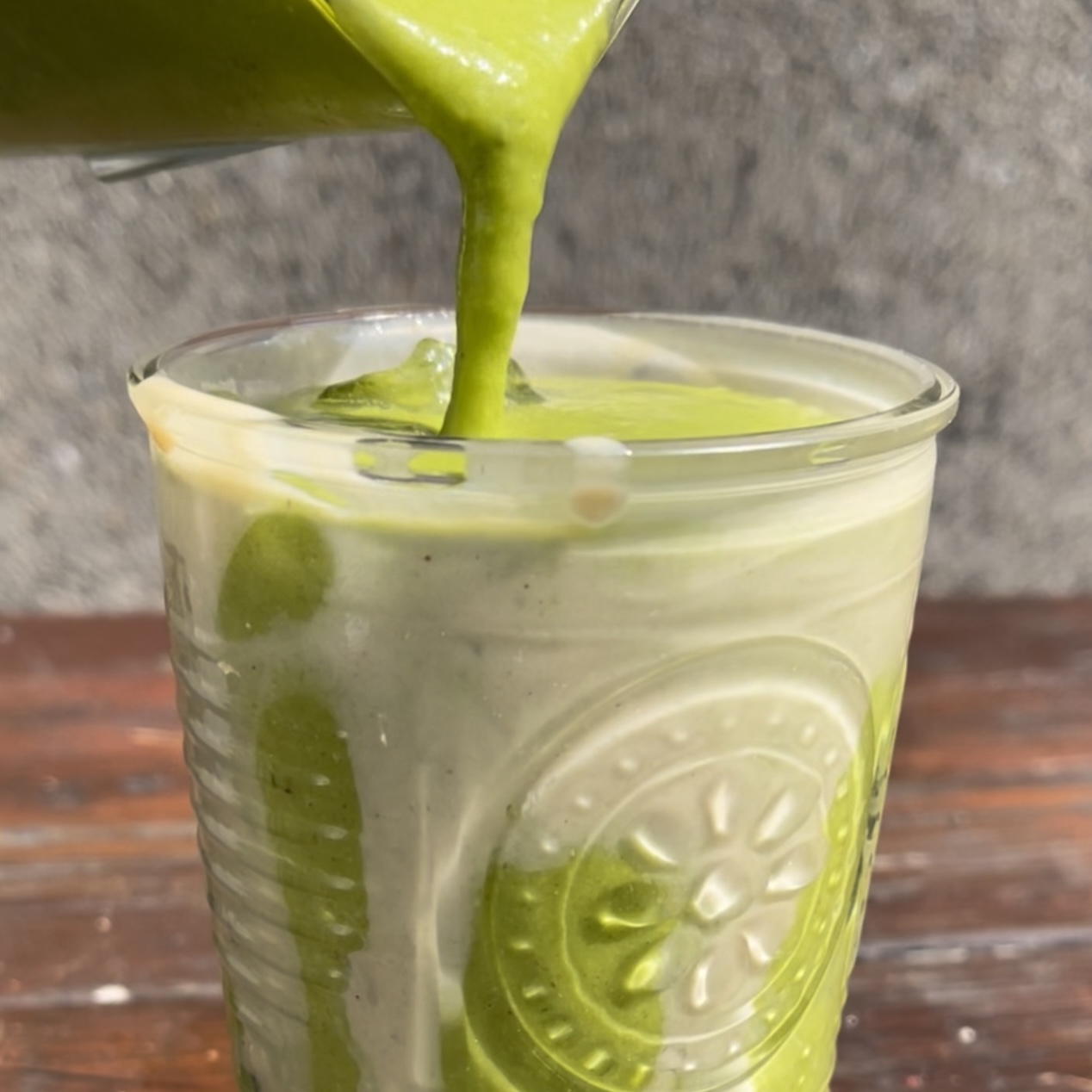
Immunity Boost Kale Smoothie
Takes 7 minutes
Serves 2
Ingredients
- 50 g kale
- 12 g ginger
- 2 whole oranges
- 8 Medjool dates
- 1/2 ripe avocado
- Juice of 1 lime
- 2 tbsp almond butter
- 275 g iced or cold water
Instructions
- Prepare the IngredientsRemove the thick ribs from the kale leaves.If using non-organic ginger, peel it; organic ginger can be used with the skin on.Peel the oranges and remove any seeds.Pit the Medjool dates, ensuring there are no stones left.Scoop the flesh from half an avocado and discard the stone.
- BlendAdd all prepared ingredients to a blender.Blend on high speed until smooth, adjusting the texture with additional water if needed.
- ServePour into glasses and enjoy immediately for maximum freshness.
Nutrition
Immunity Boost Kale Smoothie
Green, sweet, substantial: three words that don’t often go together! This Immunity Boost Kale Smoothie is a powerful way to
start your morning. ginger will put a pep in your step, the avocado, kale and almond butter will ensure your energy is consistent
during the morning, and the dates will bring sweet deliciousness! We suggest using almond butter for this recipe, but any nut
butter that you have sitting in your cupboard will work, great. Peanut butter and Tahini are close favourites. Start the day right
with this Immunity Boost Kale Smoothie! This recipe is also a great way to use up any avocado that might be sat in your fridge f
or too long! To use the whole avocado, smash the remaining half on to some toasted sourdough with a little salt, lime and chilli
for a lovely accompaniment with your smoothie.
More Kale to use up?

The Happy Pear Podcast
Let’s talk SEX!
The taboos, intimacy, pornography, vulnerability, communication, monogamy, infidelity, pleasure, orgasms, erectile dysfunction and so much more…
Episode 81 – Great sex for life!
How can we fit so much into one episode you might wonder? Well, we did it again, we decided to make life easier for you by taking the best nuggets from our series on Sex, Pleasure and Relationships and we put it into one bite-sized episode for you!
This topic is fascinating! We all do it and yet we seem to only talk about it publicly when it comes to fertility. Despite the fact that “90% of sex is for pleasure“ – Dan Savage
So why is this? Why can’t we have good honest conversations without feeling the need to crack a joke or only talk top-level stuff?
And yet according to the Huffington Post, more people watch porn than they do Netflix, Amazon and Hulu combined.
With this kind of stats, you’d think we would be talking about sex all the time.
In this episode, we explore this lack of communication, we gain some great advice on how to improve our own sex lives, have orgasms, reduce erectile dysfunction and so much more…
A winning episode. Enjoy!
Lots of Love,
Dave & Steve x
Available now from all good podcast providers:
We would love to hear your feedback! Write to us at podcast@thehappypear.ie and we will read out selects in the intro of each episode.
Checkout Vivobarefoot Footwear and avail of 20% discount when you enter the code HAPPYPEAR20 – Genuinely the only shoes you will see Dave & Steve wearing!
Produced by Sara Fawsitt
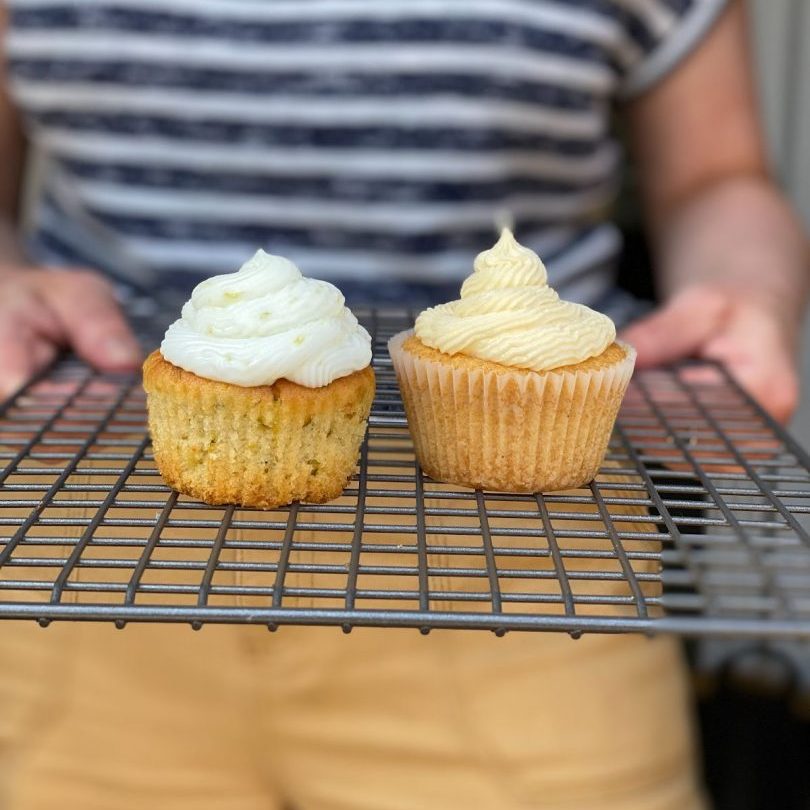
Courgette and Lemon Cupcakes
Takes
Serves
Ingredients
- 100 g Courgettes
- 300 g Self-raising flour
- 200 g coconut sugar or caster sugar
- 250 ml Non-dairy milk
- zest and juice of 2.5 lemons
- 450 g vegan cream cheese
- 150 g icing sugar
Instructions
- Preheat the oven to 180C fan/200°C/gas 6. Line a muffin tray with paper cases.
- Put the milk into a jug with the zest and juice of 2 lemons and 100ml of sunflower oil. Mix and allow the milk to curdle for a few minutes. Make a well in the centre of the dry ingredients and pour in the curdled milk. Bring together using a spatula until all the ingredients are combined.
- Fold the grated courgette through the batter. Pour the batter into each muffin case, no more than three-quarters full. Bake in the oven for 20–25 minutes, rotating halfway through the cooking time.
- Remove the cupcakes from the oven when they have risen and check that they are done by inserting a clean skewer into the centre – if the skewer comes out clean they are done, if not, put the cupcakes back into the oven for another 5 minutes or so. Allow to cool fully before icing.
- For the icing, put the vegan cream cheese into a mixing bowl and use a whisk to break it up until smooth and creamy. Sieve in the icing sugar and juice of the remaining lemon half plus most of the zest. Whisk until smooth. Pop back into the fridge until you are ready to ice the cupcakes.
- Simply frost each cupcake using a palette knife or a spatula. If you want pretty swirls, half fill a piping bag with a large star nozzle, or use a large freezer/sandwich bag and snip off about 1cm off one of the corners, and pipe a nice swirl on to each cupcake. Decorate with the rest of the lemon zest.





